Motorola Mobility T56EV1 Portable Cellular / PCS GSM Transceiver User Manual UG C330 GSM
Motorola Mobility LLC Portable Cellular / PCS GSM Transceiver UG C330 GSM
Exhibit 8 Users Manual

APPLICANT: MOTOROLA, INC. FCC ID: IHDT56EV1
EXHIBIT 8
INSTRUCTION MANUAL
A preliminary draft copy of the Users Manual follows:

START HERE >
MPx220
GSM
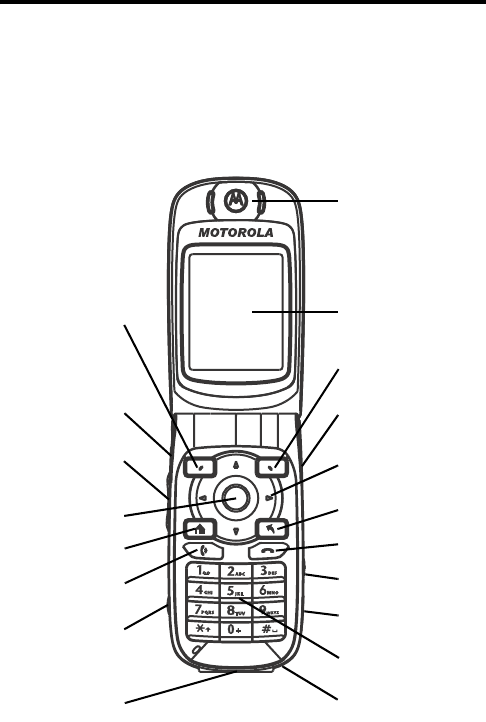
DRAFT
1
Welcome
Welcome to the world of Motorola MOTOPro devices. Your
Motorola MPx220 wireless phone delivers to you simplified
communications, increased productivity and the control to
develop a superior mobile experience whether at work, at
home, on the road or at play.
Earpiece
Main display
Right soft key
4-way navigation
key
Back key
End key
Keypad
Microphone
Left soft key
Action button
Home key
Send key
Sync/charger
port
Volume key
Headset jack
Power button
Mini SD slot
Camera button
Infrared port
DRAFT
2
Motorola, Inc.
Consumer Advocacy Office
1307 East Algonquin Road
Schamburg, IL 60196
1-800-331-6456 (United States)
1-888-390-6456 (TTY/TDD United States)
1-800-461-4575 (Canada)
www.motorola.com
(United States)
www.motorola.ca
(Canada)
MOTOROLA and the Stylized M Logo are registered in the US Patent &
Trademark Office. The Bluetooth trademarks are owned by their proprietor and
used by Motorola, Inc. under license. Microsoft, Windows, ActiveSync and
Windows Media are registered trademarks of Microsoft Corporation; and
Windows XP and Windows Mobile are trademarks of Microsoft Corporation. All
other product or service names are the property of their respective owners.
© Motorola, Inc. 2004.
Caution:
Changes or modifications made in the radio phone, not
expressly approved by Motorola, will void the user's authority to operate
the equipment.
Software Copyright Notice
The Motorola products described in this manual may include copyrighted
Motorola and third-party software stored in semiconductor memories or other
media. Laws in the United States and other countries preserve for Motorola
and third-party software providers certain exclusive rights for copyrighted
software, such as the exclusive rights to distribute or reproduce the
copyrighted software. Accordingly, any copyrighted software contained in the
Motorola products may not be modified, reverse-engineered, distributed, or
reproduced in any manner to the extent allowed by law. Furthermore, the
purchase of the Motorola products shall not be deemed to grant either directly
or by implication, estoppel, or otherwise, any license under the copyrights,
patents, or patent applications of Motorola or any third-party software
provider, except for the normal, non-exclusive, royalty-free license to use that
arises by operation of law in the sale of a product.
Manual number: ___________

DRAFT
3
Menu Map
This is the default menu on your Motorola phone. It can be
accessed by pressing
Start
from the Home screen of your
phone.
Main Menu Display
Note:
This is the standard main menu layout. Menu
organization and feature names may vary on your phone. Not
all features may be available on your phone.
* Optional network, SIM card, or subscription-dependent feature.
# The voice recognition application works only via the phone directly or a wired
headset attached to the phone, but not with a Bluetooth® headset.
Messaging
• Text Messages
• Outlook E-Mail *
• Media Messages *
Contacts
Calendar
Internet Explorer *
ActiveSync
Call History
MSN Messenger *
Settings
• Phone *
• Sounds
• Profiles
• Home Screen
• About
• Accessibility
• Beam
•Bluetooth
• Certificates
• Data Connections
• Date and Time
•Owner Information
• Power Management
• Regional Settings
• Remove Programs
• Security
• Phone Settings
Camera
Favorites Manager
File Manager
File Viewer
Game Room
Media Manager
MMSSettings *
PhotoAlbum
Pocket MSN *
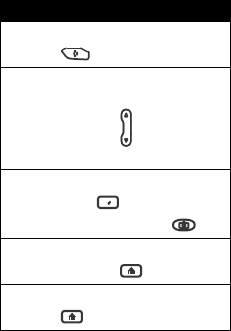
DRAFT
4
Resource Manager
• Task Manager
• Space Manager
Speed Dial
Tasks
Speech Recognition
#
Voice Recorder
Windows Media
Accessories
•Calculator
• Camcorder
• Modem Link
•Video Player
Games
•Jawbreaker
• Solitaire
Shortcuts
Go to dialed calls list:
Press (in idle).
Use Speech Recognition or
Voice Recorder:
Press and hold up or down
(in idle).
Take photos:
Press
Start
>
More
>
Camera
, and then press .
Open Quick List:
Press and hold (in idle).
Exit menu system:
Press .

DRAFT
5
Contents
Menu Map
. . . . . . . . . . . . . . . . . . . . . . . . . . . . . . . . . . . . . . 3
Safety and General Information
. . . . . . . . . . . . . . . . . . . . 9
Getting Started
. . . . . . . . . . . . . . . . . . . . . . . . . . . . . . . . . 17
What’s in the Box? . . . . . . . . . . . . . . . . . . . . . . . . . . . . . 17
About This Guide . . . . . . . . . . . . . . . . . . . . . . . . . . . . . . 17
Installing the SIM Card . . . . . . . . . . . . . . . . . . . . . . . . . . 18
Installing the Battery . . . . . . . . . . . . . . . . . . . . . . . . . . . . 19
Charging the Battery. . . . . . . . . . . . . . . . . . . . . . . . . . . . 20
Battery Use. . . . . . . . . . . . . . . . . . . . . . . . . . . . . . . . . . . 21
Turning Your Phone On/Off. . . . . . . . . . . . . . . . . . . . . . . 22
Adjusting Volume . . . . . . . . . . . . . . . . . . . . . . . . . . . . . . 23
Making a Call . . . . . . . . . . . . . . . . . . . . . . . . . . . . . . . . . 23
Answering a Call. . . . . . . . . . . . . . . . . . . . . . . . . . . . . . . 25
Learning to Use Your Phone
. . . . . . . . . . . . . . . . . . . . . . 26
Using the Internal Display. . . . . . . . . . . . . . . . . . . . . . . . 26
Using the External Display . . . . . . . . . . . . . . . . . . . . . . . 28
Using the Home Key . . . . . . . . . . . . . . . . . . . . . . . . . . . . 29
Using the 4-Way Navigation Key. . . . . . . . . . . . . . . . . . . 30
Using the Action Button . . . . . . . . . . . . . . . . . . . . . . . . . 31
Using the Soft Keys . . . . . . . . . . . . . . . . . . . . . . . . . . . . 31
Using the Back Button . . . . . . . . . . . . . . . . . . . . . . . . . . 33
Using Menus. . . . . . . . . . . . . . . . . . . . . . . . . . . . . . . . . . 33
Entering Text and Numbers . . . . . . . . . . . . . . . . . . . . . . 34
Viewing Phone Information. . . . . . . . . . . . . . . . . . . . . . . 38
Setting Up Your Phone
. . . . . . . . . . . . . . . . . . . . . . . . . . . 39
Setting the Time and Date . . . . . . . . . . . . . . . . . . . . . . . 39
Entering Owner Information . . . . . . . . . . . . . . . . . . . . . . 39
DRAFT
6
Configuring Power Management. . . . . . . . . . . . . . . . . . . 40
Calling Features
. . . . . . . . . . . . . . . . . . . . . . . . . . . . . . . . 41
Redialing a Number . . . . . . . . . . . . . . . . . . . . . . . . . . . . 41
Calling a Contacts Entry . . . . . . . . . . . . . . . . . . . . . . . . . 41
Making a Call with Voice Dialing . . . . . . . . . . . . . . . . . . . 44
Making a Call from the Call History List . . . . . . . . . . . . . 50
Calling a Number in a Message . . . . . . . . . . . . . . . . . . . 51
Calling an Emergency Number. . . . . . . . . . . . . . . . . . . . 51
Managing Call History. . . . . . . . . . . . . . . . . . . . . . . . . . . 52
Calling with Speed Dial. . . . . . . . . . . . . . . . . . . . . . . . . . 53
Using Voicemail . . . . . . . . . . . . . . . . . . . . . . . . . . . . . . . 55
Using Call Waiting. . . . . . . . . . . . . . . . . . . . . . . . . . . . . . 55
Putting a Call on Hold . . . . . . . . . . . . . . . . . . . . . . . . . . . 56
Muting a Call. . . . . . . . . . . . . . . . . . . . . . . . . . . . . . . . . . 57
Turning the Speaker On/Off . . . . . . . . . . . . . . . . . . . . . . 57
Messages and Chat
. . . . . . . . . . . . . . . . . . . . . . . . . . . . . 58
Composing an MMS Message . . . . . . . . . . . . . . . . . . . . 58
Sending Your MMS Message
. . . . . . . . . . . . . . . . . . . . . . .
62
Viewing Your MMS Message . . . . . . . . . . . . . . . . . . . . . 63
Configuring the MMS Setting . . . . . . . . . . . . . . . . . . . . . 64
Configuring an Email Account . . . . . . . . . . . . . . . . . . . . 65
Receiving Email from the Internet. . . . . . . . . . . . . . . . . . 67
Composing and Sending an Email/SMS Message . . . . . 70
Importing SMS Messages from Your SIM Card to
Messaging
. . . . . . . . . . . . . . . . . . . . . . . . . . . . . . . . . . . . . . . .
75
Opening Email/SMS Messages . . . . . . . . . . . . . . . . . . . 75
Receiving Meeting Requests . . . . . . . . . . . . . . . . . . . . . 79
Viewing Your Message Folders. . . . . . . . . . . . . . . . . . . . 80
Using Message Notifications. . . . . . . . . . . . . . . . . . . . . . 81
Communicating with MSN® Messenger . . . . . . . . . . . . . 82
Personalizing Your Phone
. . . . . . . . . . . . . . . . . . . . . . . . 88
Using Phone Settings . . . . . . . . . . . . . . . . . . . . . . . . . . . 88
DRAFT
7
Using Sound Settings . . . . . . . . . . . . . . . . . . . . . . . . . . . 90
Using Profiles . . . . . . . . . . . . . . . . . . . . . . . . . . . . . . . . . 91
Changing the Home Screen . . . . . . . . . . . . . . . . . . . . . . 94
Changing Regional Settings . . . . . . . . . . . . . . . . . . . . . . 95
Setting Font Size, Time-Out, and Alert Volume . . . . . . . 95
Using Advanced Phone Settings . . . . . . . . . . . . . . . . . . 95
Getting More Out of Your Phone
. . . . . . . . . . . . . . . . . . . 96
Making a Conference Call . . . . . . . . . . . . . . . . . . . . . . . 96
Forwarding Calls . . . . . . . . . . . . . . . . . . . . . . . . . . . . . . . 97
Barring Calls . . . . . . . . . . . . . . . . . . . . . . . . . . . . . . . . . . 98
Monitoring Phone Use . . . . . . . . . . . . . . . . . . . . . . . . . . 98
Opening Applications with Speed Dial . . . . . . . . . . . . . . 99
Using Voice Activation . . . . . . . . . . . . . . . . . . . . . . . . . 100
Making Data Calls. . . . . . . . . . . . . . . . . . . . . . . . . . . . . 104
Synchronizing Information among Devices. . . . . . . . . . 110
Using a Bluetooth® Connection . . . . . . . . . . . . . . . . . . 123
Using Your Phone as a Modem . . . . . . . . . . . . . . . . . . 126
Changing the Order of Applications Displayed on
the Start List . . . . . . . . . . . . . . . . . . . . . . . . . . . . . . . . . 132
Using File Viewer . . . . . . . . . . . . . . . . . . . . . . . . . . . . . 133
Managing Files . . . . . . . . . . . . . . . . . . . . . . . . . . . . . . . 138
Managing Phone System Resources . . . . . . . . . . . . . . 140
Removing Programs . . . . . . . . . . . . . . . . . . . . . . . . . . . 142
Personal Organizer
. . . . . . . . . . . . . . . . . . . . . . . . . . . . . 143
Using Contacts
. . . . . . . . . . . . . . . . . . . . . . . . . . . . . . . . . .
143
Using Calendar . . . . . . . . . . . . . . . . . . . . . . . . . . . . . . . 148
Using Schedule. . . . . . . . . . . . . . . . . . . . . . . . . . . . . . . 149
Using Tasks . . . . . . . . . . . . . . . . . . . . . . . . . . . . . . . . . 152
Using Voice Recorder . . . . . . . . . . . . . . . . . . . . . . . . . . 153
Using Calculator . . . . . . . . . . . . . . . . . . . . . . . . . . . . . . 154
DRAFT
8
Security
. . . . . . . . . . . . . . . . . . . . . . . . . . . . . . . . . . . . . . 156
Locking and Unlocking the Keypad. . . . . . . . . . . . . . . . 156
Locking and Unlocking Your Phone . . . . . . . . . . . . . . . 157
Locking and Unlocking Your SIM Card . . . . . . . . . . . . . 159
News and Entertainment
. . . . . . . . . . . . . . . . . . . . . . . . 160
Taking Pictures . . . . . . . . . . . . . . . . . . . . . . . . . . . . . . . 160
Managing Pictures . . . . . . . . . . . . . . . . . . . . . . . . . . . . 166
Creating Video Clips . . . . . . . . . . . . . . . . . . . . . . . . . . . 172
Playing Video Clips . . . . . . . . . . . . . . . . . . . . . . . . . . . . 174
Using Internet Explorer® . . . . . . . . . . . . . . . . . . . . . . . 177
Using Media Player . . . . . . . . . . . . . . . . . . . . . . . . . . . . 180
Managing Digital Rights Management (DRM) Content. 183
Playing Games . . . . . . . . . . . . . . . . . . . . . . . . . . . . . . . 185
Managing Java . . . . . . . . . . . . . . . . . . . . . . . . . . . . . . . 188
Troubleshooting
. . . . . . . . . . . . . . . . . . . . . . . . . . . . . . . 191
Specific Absorption Rate Data
. . . . . . . . . . . . . . . . . . . 196
Microsoft End User License Agreement
. . . . . . . . . . . 198
Index
. . . . . . . . . . . . . . . . . . . . . . . . . . . . . . . . . . . . . . . . 205

DRAFT
9
Safety and General Information
IMPORTANT INFORMATION ON SAFE AND EFFICIENT OPERATION.
READ THIS INFORMATION BEFORE USING YOUR PHONE.
The information provided in this document supersedes the general safety
information in user guides published prior to December 1, 2002.
Exposure To Radio Frequency (RF) Energy
Your phone contains a transmitter and a receiver. When it is ON, it
receives and transmits RF energy. When you communicate with your
phone, the system handling your call controls the power level at which
your phone transmits.
Your Motorola phone is designed to comply with local regulatory
requirements in your country concerning exposure of human beings to RF
energy.
Operational Precautions
To assure optimal phone performance and make sure human exposure to
RF energy is within the guidelines set forth in the relevant standards,
always adhere to the following procedures.
External Antenna Care
Use only the supplied or Motorola-approved replacement antenna.
Unauthorized antennas, modifications, or attachments could damage the
phone.
Do NOT hold the external antenna when the phone is IN USE. Holding
the external antenna affects call quality and may cause the phone to
operate at a higher power level than needed. In addition, use of
unauthorized antennas may result in non-compliance with the local
regulatory requirements in your country.
DRAFT
10
Phone Operation
When placing or receiving a phone call, hold your phone as you would a
wireline telephone.
Body-Worn Operation
To maintain compliance with RF energy exposure guidelines, if you wear
a phone on your body when transmitting, always place the phone in a
Motorola-supplied or approved clip, holder, holster, case, or body harness
for this phone, if available. Use of accessories not approved by Motorola
may exceed RF energy exposure guidelines. If you do not use one of the
body-worn accessories approved or supplied by Motorola, and are not
using the phone held in the normal use position, ensure the phone and its
antenna are at least 1 inch (2.5 centimeters) from your body when
transmitting.
Data Operation
When using any data feature of the phone, with or without an accessory
cable, position the phone and its antenna at least 1 inch (2.5 centimeters)
from your body.
Approved Accessories
Use of accessories not approved by Motorola, including but not limited to
batteries and antenna, may cause your phone to exceed RF energy
exposure guidelines. For a list of approved Motorola accessories, visit our
website at
www.Motorola.com
.
RF Energy Interference/Compatibility
Note:
Nearly every electronic device is susceptible to RF energy
interference from external sources if inadequately shielded, designed, or
otherwise configured for RF energy compatibility. In some circumstances
your phone may cause interference.
DRAFT
11
Facilities
Turn off your phone in any facility where posted notices instruct you to do
so. These facilities may include hospitals or health care facilities that may
be using equipment that is sensitive to external RF energy.
Aircraft
When instructed to do so, turn off your phone when on board an aircraft.
Any use of a phone must be in accordance with applicable regulations per
airline crew instructions.
Medical Devices
Pacemakers
Pacemaker manufacturers recommend that a minimum separation of
6 inches (15 centimeters) be maintained between a handheld wireless
phone and a pacemaker.
Persons with pacemakers should:
•
ALWAYS keep the phone more than 6 inches (15 centimeters) from
your pacemaker when the phone is turned ON.
•
NOT carry the phone in the breast pocket.
•
Use the ear opposite the pacemaker to minimize the potential for
interference.
•
Turn OFF the phone immediately if you have any reason to suspect
that interference is taking place.
Hearing Aids
Some digital wireless phones may interfere with some hearing aids. In the
event of such interference, you may want to consult your hearing aid
manufacturer to discuss alternatives.
Other Medical Devices
If you use any other personal medical device, consult the manufacturer of
your device to determine if it is adequately shielded from RF energy. Your
physician may be able to assist you in obtaining this information.
DRAFT
12
Use While Driving
Check the laws and regulations on the use of phones in the area where
you drive. Always obey them.
When using your phone while driving, please:
•
Give full attention to driving and to the road.
•
Use hands-free operation, if available.
•
Pull off the road and park before making or answering a call if driving
conditions so require.
Responsible driving best practices may be found in the “Wireless Phone
Safety Tips” at the end of this manual and at the Motorola website:
www.Motorola.com/callsmart
.
Operational Warnings
For Vehicles With an Air Bag
Do not place a phone in the area over an air bag or in the air bag
deployment area. Air bags inflate with great force. If a phone is placed in
the air bag deployment area and the air bag inflates, the phone may be
propelled with great force and cause serious injury to occupants of the
vehicle.
Potentially Explosive Atmospheres
Turn off your phone prior to entering any area with a potentially explosive
atmosphere, unless it is a phone type especially qualified for use in such
areas and certified as “Intrinsically Safe.” Do not remove, install, or
charge batteries in such areas. Sparks in a potentially explosive
atmosphere can cause an explosion or fire resulting in bodily injury or
even death.
Note:
The areas with potentially explosive atmospheres referred to above
include fueling areas such as below decks on boats, fuel or chemical
transfer or storage facilities, areas where the air contains chemicals or
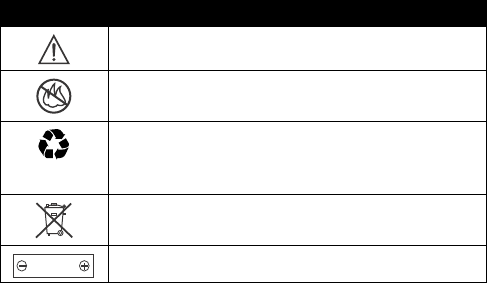
DRAFT
13
particles, such as grain, dust, or metal powders. Areas with potentially
explosive atmospheres are often but not always posted.
Blasting Caps and Areas
To avoid possible interference with blasting operations, turn OFF your
phone when you are near electrical blasting caps, in a blasting area, or in
areas posted “Turn off electronic devices.” Obey all signs and
instructions.
Batteries
Batteries can cause property damage and/or bodily injury such as burns if
a conductive material such as jewelry, keys, or beaded chains touch
exposed terminals. The conductive material may complete an electrical
circuit (short circuit) and become quite hot. Exercise care in handling any
charged battery, particularly when placing it inside a pocket, purse, or
other container with metal objects.
Use only Motorola original batteries
and chargers.
Your battery or phone may contain symbols, defined as follows:
Symbol Definition
Important safety information will follow.
Your battery or phone should not be disposed of in a
fire.
Your battery or phone may require recycling in
accordance with local laws. Contact your local
regulatory authorities for more information.
Your battery or phone should not be thrown in the
trash.
Your phone contains an internal lithium ion battery.
LiIon BATT
DRAFT
14
Seizures/Blackouts
Some people may be susceptible to epileptic seizures or blackouts when
exposed to blinking lights, such as when watching television or playing
video games. These seizures or blackouts may occur even if a person
never had a previous seizure or blackout.
If you have experienced seizures or blackouts, or if you have a family
history of such occurrences, please consult with your doctor before
playing video games on your phone or enabling a blinking-lights feature
on your phone. (The blinking-light feature is not available on all products.)
Parents should monitor their children's use of video game or other
features that incorporate blinking lights on the phones. All persons should
discontinue use and consult a doctor if any of the following symptoms
occur: convulsion, eye or muscle twitching, loss of awareness, involuntary
movements, or disorientation.
To limit the likelihood of such symptoms, please take the following safety
precautions:
•
Do not play or use a blinking-lights feature if you are tired or need
sleep.
•
Take a minimum of a 15-minute break hourly.
•
Play in a room in which all lights are on.
•
Play at the farthest distance possible from the screen.
Repetitive Motion Injuries
When you play games on your phone, you may experience occasional
discomfort in your hands, arms, shoulders, neck, or other parts of your
body. Follow these instructions to avoid problems such as tendonitis,
carpal tunnel syndrome, or other musculoskeletal disorders:
•
Take a minimum 15-minute break every hour of game playing.
•
If your hands, wrists, or arms become tired or sore while playing,
stop and rest for several hours before playing again.
DRAFT
15
•
If you continue to have sore hands, wrists, or arms during or after
play, stop playing and see a doctor.
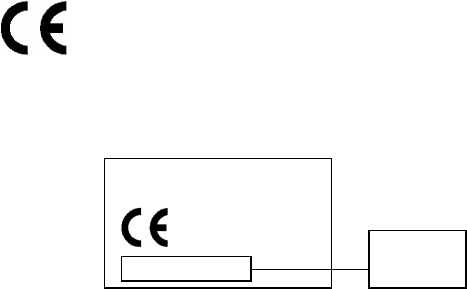
DRAFT
16
European Union Directives Conformance Statement
Hereby, Motorola declares that this product is in compliance
with
•
The essential requirements and other relevant provisions
of Directive 1999/5/EC
•
All other relevant EU Directives
The above gives an example of a typical Product Approval Number.
You can view your product's Declaration of Conformity (DoC) to Directive
1999/5/EC (the R&TTE Directive) at www.motorola.com/rtte - to find your
DoC, enter the product Approval Number from your product's label in the
"Search" bar on the Web site.
IMEI: 350034/40/394721/9
0168
Type: MC2-41H14
Product
Approval
Number

DRAFT
17
Getting Started
Getting Started
What’s in the Box?
Your wireless mobile phone comes with a battery,
travel charger, USB data cable, mono headset, companion
CD, user manual, product and service user data, and
cables*. You can purchase other accessories to customize
your phone for maximum performance and portability.
To purchase Motorola Original™ accessories, contact the
Motorola Customer Call Center at 1-800-331-6456 in the
United States or 1-800-461-4575 in Canada.
Note:
Additional accessories may be available depending
on product promotions.
* In-box content may vary by Regions.
About This Guide
This user guide describes how to use your Motorola phone
to its maximum potential.
Note:
In this user’s guide, “Find the Feature” always
indicates the feature's position from the Home screen.
Optional Features
This label identifies an optional network, SIM
card, or subscription-dependent feature that may
not be offered by all service providers in all
geographical areas.
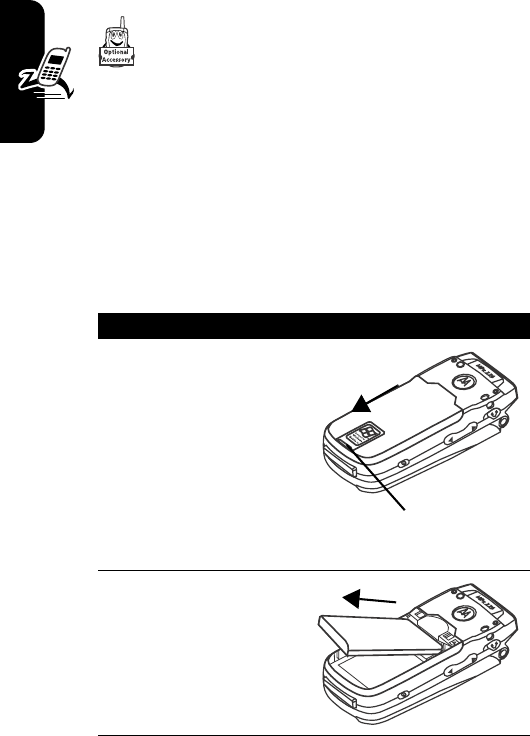
DRAFT
18
Getting Started
Optional Accessories
This label identifies a feature that requires an
optional Motorola Original™ accessory.
Installing the SIM Card
Your Subscriber Identity Module (SIM) card contains your
phone number, service details, and phonebook/message
information. It is stored in a recess in the battery
compartment.
Caution:
Do not bend or scratch your SIM card. Avoid
exposing your SIM card to static electricity, water, or dirt.
Action
1
If the phone’s battery
door is already in
place, push down the
battery door release
latch and lift the battery
door off the phone.
Note:
Tur n o f f yo u r
phone every time when
you remove/insert the SIM card.
2
Lift the battery up from
the bottom end and
remove it from the
phone.
Latch
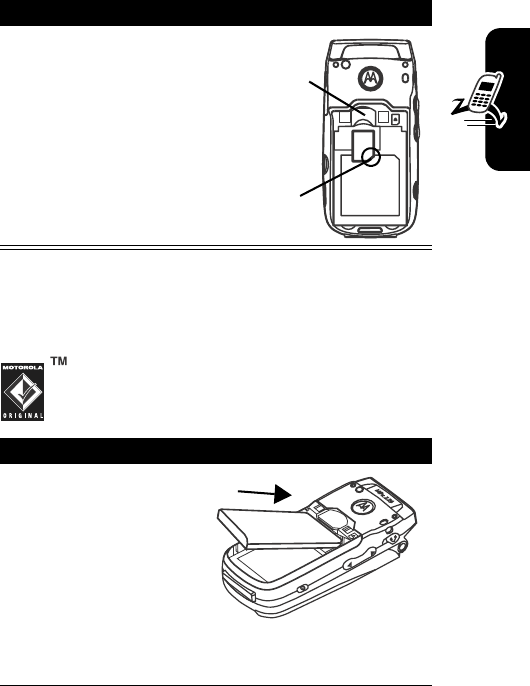
DRAFT
19
Getting Started
Installing the Battery
You must install and charge the battery to use your phone.
Your phone is designed to use only Motorola
Original™ batteries and accessories
3
Hold the SIM card
with the gold
contact side facing
down and the cut
corner on the
bottom right. Slide
the SIM card all the
way into the SIM
card holder.
Action
1
Insert the battery into
the back of the
phone, with the
contacts on the top
end of the battery in
alignment with the
contacts on the
phone. Push the bottom end of the battery into
the phone until it clicks into the compartment.
Action
MPx220
SIM card holder
Cut corner
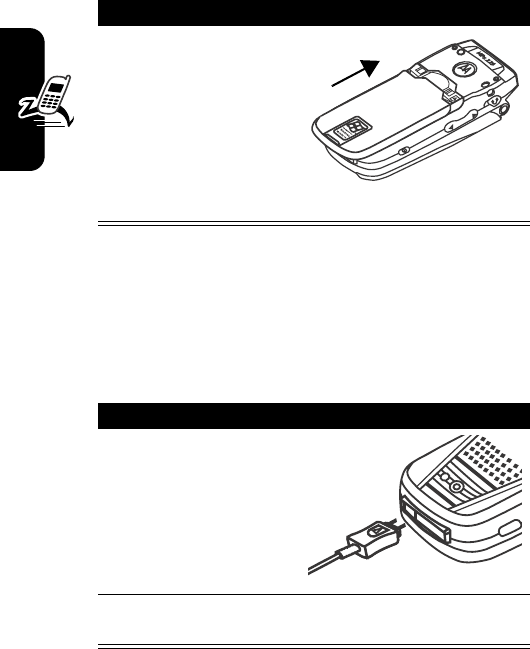
DRAFT
20
Getting Started
Charging the Battery
New batteries are partially charged. Before using your
phone, charge the battery as described below. Some
batteries perform best after several full charge/discharge
cycles.
Notes:
•
When you charge the battery, the battery power level
indicator in the external display shows how much of
2
Place the battery
cover back on the
phone, aligning the
tabs on the cover with
the groove on the
phone. Slide the
battery cover in the
direction shown until it locks into place.
Action
1
Plug battery charger
connector into the
sync/charger port.
Note:
The connector
is keyed and can only
be inserted 1 way.
2
Plug the other end of the charger into the
electrical outlet.
Action

DRAFT
21
Getting Started
the charging process is complete. At least 1 segment
of the battery power level indicator must be visible to
ensure full phone functionality while charging. You
can use the phone during the charging process.
However, the battery will take longer to fully
charge.
•
Your phone will indicate a full charge before 24 hours
have passed, however, allow your phone to charge for
the full 24 hours before 1st use.
•
When battery power is low, a low battery message
displays. Charge the battery immediately.
•
If battery power is completely drained, the phone
turns off automatically.
•
The charging indicator may take several minutes
before appearing in the external display.
Battery Use
To maximize your battery’s performance:
•
Always use Motorola Original™ batteries and battery
chargers. The phone warranty does not cover damage
caused from using non-Motorola batteries and/or
battery chargers.
•
Battery life would be shorter than normal if users play
games or use phones in low signal strength areas.
•
Maintain the battery at or near room temperature
when charging.
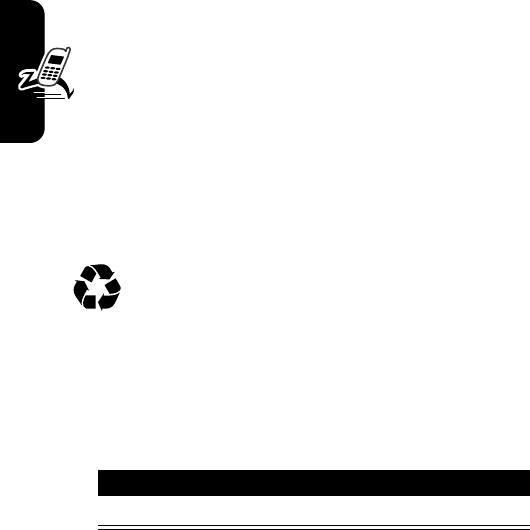
DRAFT
22
Getting Started
•
Do not expose batteries to temperatures below -10°C
(14°F) or above 45°C (113°F). Always take your
phone with you when you leave your vehicle.
•
When you do not intend to use a battery for a
while, store it uncharged in a cool, dark, dry place,
such as a refrigerator.
•
Over time, batteries gradually wear down and require
longer charging times. This is normal. If you charge
your battery regularly and notice a decrease in talk
time or an increase in charging time, then it is
probably time to buy a new battery.
The rechargeable batteries that power this phone
must be disposed of properly and may need to
be recycled. Contact your local recycling center
for proper disposal methods. Never dispose of batteries in
a fire because they may explode. Refer to your battery’s
label for battery type.
Turning Your Phone On/Off
Press To
Power
(
p
)turn on or off your phone
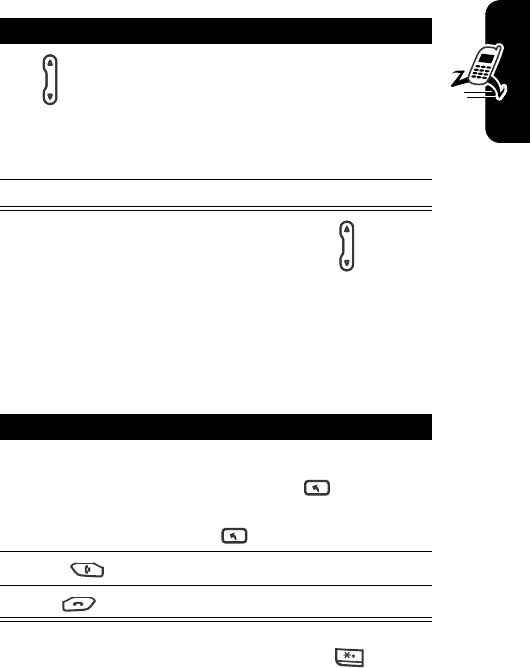
DRAFT
23
Getting Started
Adjusting Volume
Tip:
When a call is ringing/incoming, press to mute the
ring.
Making a Call
There are several ways to make a call. The easiest way is
to dial a phone number from the Home screen.
Tip:
To enter an extension, press and hold to insert a
“P” (pause character); then enter the extension following it.
Press To
1
up/down
increase/decrease earpiece
volume in idle or during a call
Note:
You can adjust the
volume only when the phone
flip is opened.
2
Action
(
A
) save the setting
Press To
1
keypad keys enter the phone number
Tip:
Press
Back
to delete
the last digit; press and hold
Back
to delete all digits.
2
Send
make the call
3
End
end the call
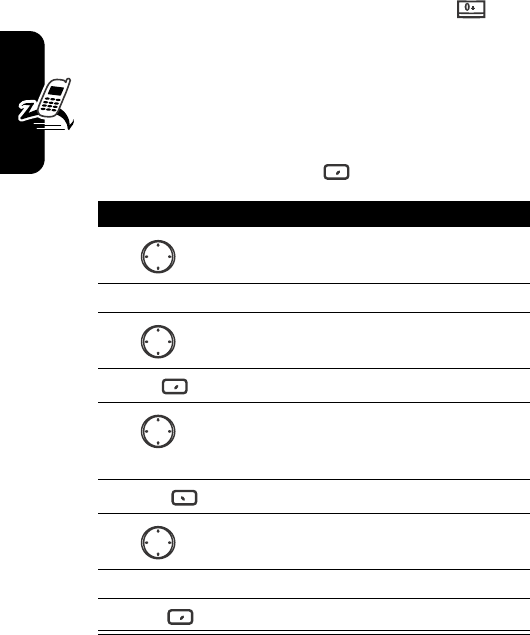
DRAFT
24
Getting Started
Tip:
To make an international call, press and hold to
insert a “+”; then enter the country code, area code
(omitting the starting 0), and phone number following it.
Some international calls require a 3-second pause in
the dialing sequence for the call to process
successfully. Follow the steps:
The letter “p” appears where the 3-second pause will occur
in the dialing sequence. You can also add a “p” via text
entry.
Find the Feature
Start
>
Contacts
Press To
1
scroll to a desired entry
2
Action
(
A
)
select the entry
3
scroll to a desired phone
number
4
Edit
edit the phone number
5
left/right move the cursor between the
numbers where you want to
insert a 3-second pause
6
Menu
open the options menu
7
scroll to
Insert Pause
8
Action
(
A
)
insert a 3-second pause
9
Done
save the setting
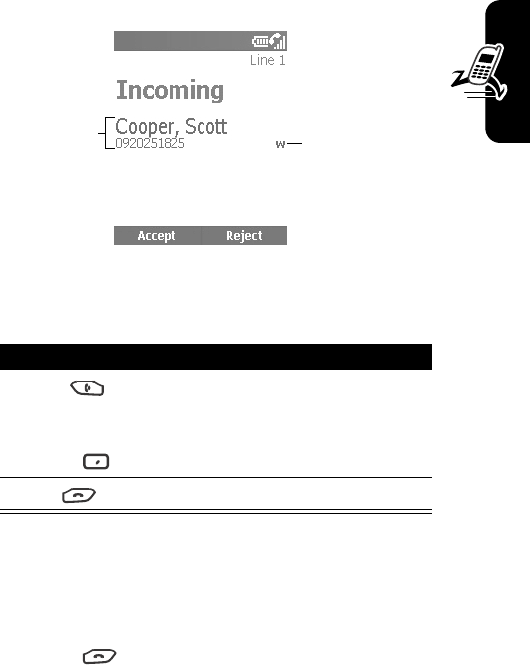
DRAFT
25
Getting Started
Answering a Call
When you receive a call, your phone rings and/or vibrates
and displays an incoming call message.
Tip:
When
Flip Answer
is active, open the flip to answer the
call. (To activate, see “Using Advanced Phone Settings” on
page 95.)
Tip:
When
Any key answer
is active, press any of the keys
except
End
to answer the call. (To activate, see “Using
Phone Settings” on page 88.)
Press To
1
Send
or
Accept
answer the call
2
End
end the call
Caller ID
information is
matched to a
contact
Phone number
is identified as
Work
number in
Contacts
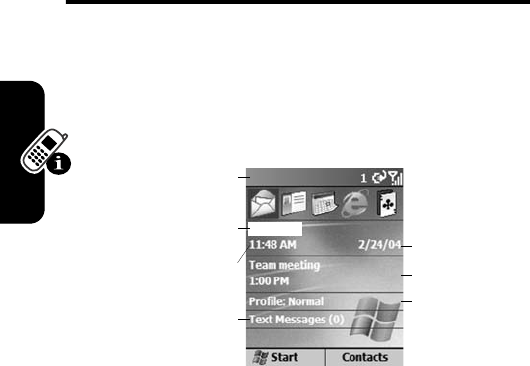
DRAFT
26
Learning to Use Your Phone
Learning to Use Your
Phone
Using the Internal Display
The Home screen (shown) is the standard display when
you are not on a call or using the menu.
On the Home screen, you will find:
•
The top of the display shows status indicators about
your phone’s current mode.
•
The center of the display shows the Home screen, as
well as
icons, appointments, other types of
information, and
messages.
•
The bottom of the display shows the soft key
commands.
Service provider
Number of unread
messages
Next appointme
Current date
Status indicators
Current time
Ring type or
volume profile
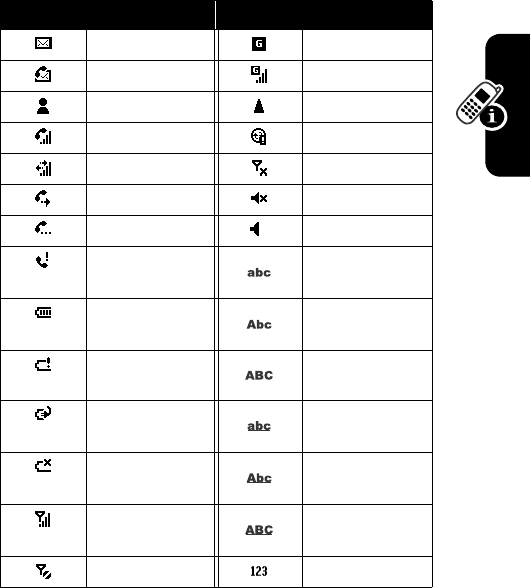
DRAFT
27
Learning to Use Your Phone
Note:
The display shown may be different based on the
specific Home screen configuration chosen.
Status indicators display at the top of your phone’s internal
screen. The following table lists common status indicators
and their meanings.
Icon Meaning Icon Meaning
New email or SMS GPRS available
New voicemail GPRS in use
New instant message Roaming
Voice call active Sync error
Data call active Radio off
Call forwarding Ringer off
Call on hold Speaker
Missed call Multi-Tap text input
mode, lowercase
Battery level Multi-Tap text input
mode, uppercase
Low battery Multi-Tap text input
mode, caps lock
Battery charging iTAP text input mode,
lowercase
No battery iTAP text input mode,
uppercase
Signal strength iTAP text input mode,
caps lock
No signal Numeric input mode
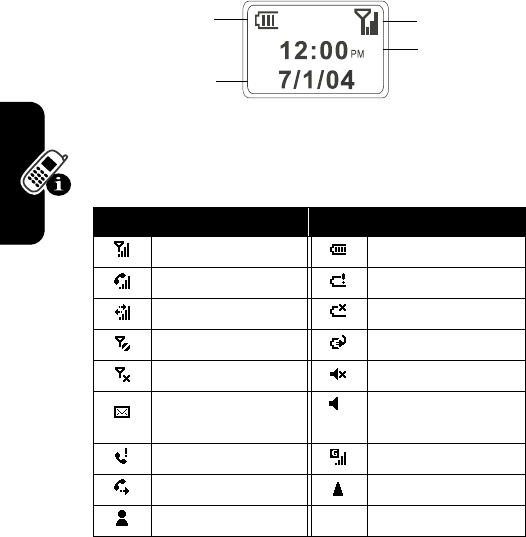
DRAFT
28
Learning to Use Your Phone
Using the External Display
The following table lists the icons and their meanings
that appear on the external display.
When enabled, the external display shows the incoming
photo Caller ID (see “Taking Pictures” on page 160).
Your phone’s display may differ based on the specific
external LCD style chosen (see “Using Advanced Phone
Settings” on page 95).
Icon Meaning Icon Meaning
Signal strength Battery level
Call in progress Battery low
Data call active No battery
No signal Charging
Radio off Ringer off
You have unread new
message(s)
Speaker
You have missed call(s) GPRS in use
Call forwarding Roaming
New instant message
Signal strength
Battery level
Current time
Current date
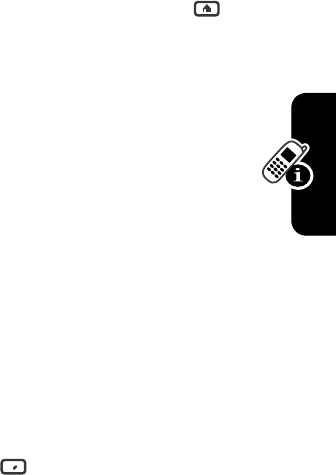
DRAFT
29
Learning to Use Your Phone
Using the Home Key
Use the Home key
to do the following:
•
From the Home screen, press and hold
Home
to
access the
Quick List
, or quickly press and release
Power
(
p
). The
Quick List
displays a list of available
profile types and commands, such as turn off your
phone, turn on/off the
Flight mode
feature, lock your
phone’s keypad, and lock your phone.
Note:
Be aware that when the
Flight mode
feature is turned
on, then your phone cannot receive and make a call,
including an emergency call. In order to receive and
make a call, you must turn off the
Flight mode
feature and re-
engage your phone’s RF capability. Always obey the
instructions of your airline crew.
•
Display the Home screen to dial a number.
•
The Home screen is your starting place for most
tasks. You can easily navigate to any program or
setting from this screen. The top of the Home screen
displays the last 10 icons you browsed. Just select a
program and press
Action
(
A
) to open the program. You
can also press
Start
to enter the programs on the
Start list. The Home screen also displays the current
time and date, your next appointment, your current
profile, and the number of unread messages in
Messaging
. Select your next appointment and press
Action
(
A
) to open
Calendar
, and you can see all of your
appointments for the day. To view
Messaging
, select the
messaging status showing the number of unread
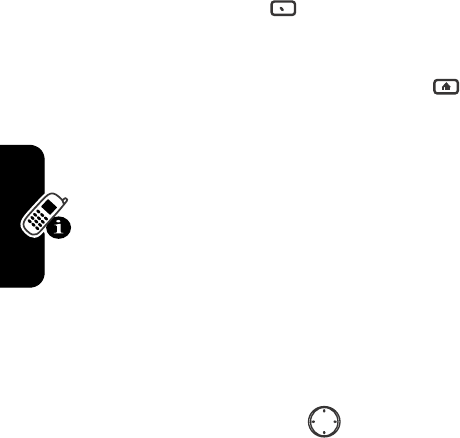
DRAFT
30
Learning to Use Your Phone
messages you have, and press
Action
(
A
). To view
Contacts
, press
Contacts
.
•
The Home screen automatically displays when you
turn on the phone or leave the phone idle, but you can
navigate to it at any time by pressing
Home
.
•
To change Home screen settings, see “Changing the
Home Screen” on page 94.
Using the 4-Way Navigation
Key
Use the 4-Way Navigation key to navigate the menu
system, change feature settings and play games.
Tip:
Down and up are your primary movements within
menus and navigation through contacts. Move left and
right to change feature settings and edit text.
From the Home screen, press to do the following:
•
Select a program at the top of the screen, and then
press
Action
(
A
) to open the program.
•
Select an item in the center of the Home screen, such
as your next appointment, your profile type, or your
messaging information, and then press
Action
(
A
) to
open the program or access the settings associated
with the item selected.
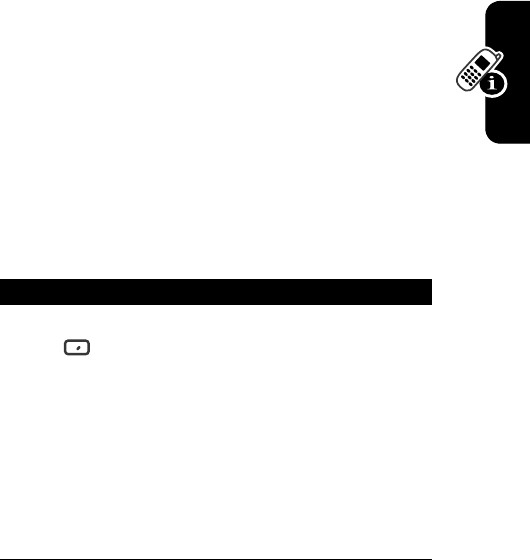
DRAFT
31
Learning to Use Your Phone
Using the Action Button
The Action button confirms your selection. Pressing
Action
(
A
) is similar to pressing “Enter” on a keyboard. In
some cases, confirming your selection accesses a
program or setting. You can also press
Action
(
A
) to check
or uncheck a feature.
Using the Soft Keys
The 2 Soft keys on your phone are located directly
below the display screen. Each soft key performs the
command displayed immediately above it on the
screen. Both soft keys are context sensitive — their
function changes according to the phone’s status, for
example, when in a particular application or making a
phone call.
On the Home screen:
Press To
1
Left soft
key
(
Start
)
access programs in the Start
list
Tip:
The phone comes pre-
installed with programs that
you can start using
immediately. To install
additional programs on your
phone, refer to the Motorola
MPx220 companion CD that
came with the phone.
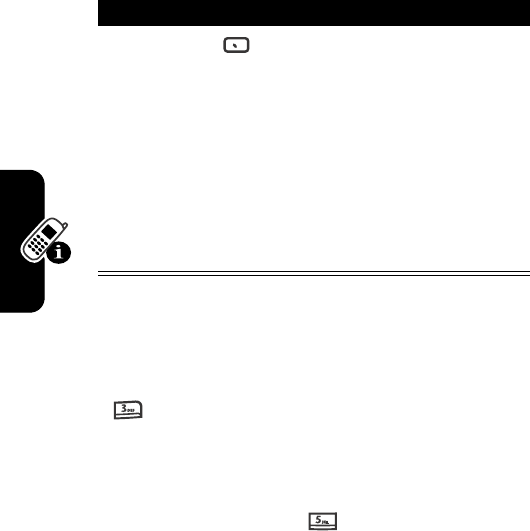
DRAFT
32
Learning to Use Your Phone
You can also use numbers to navigate quickly to programs
and settings on the phone. Press the number on the
keypad that corresponds to the number of the program or
setting you want. For example, in the Start list,
press to open
Calendar
.
You can also use numbers to select menu options by
pressing the number that corresponds to the menu option
in descending order. For example, to select
Filter
in the list
of
Contacts
menu options, press .
2
Right soft key
access the following during
normal use:
•
Contacts
: displays to open
your contacts list.
•
Voicemail
: displays to play
a received voicemail.
•
Messages
: displays to read
new messages in
Messaging
.
Press To
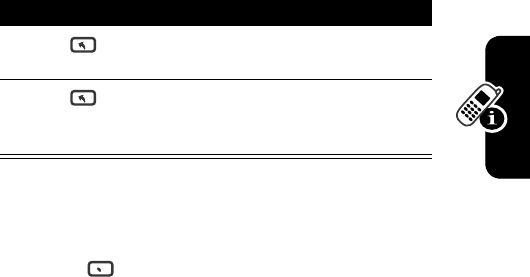
DRAFT
33
Learning to Use Your Phone
Using the Back Button
Press the Back button
to navigate to the previous screen,
or move the cursor back to delete 1 or more characters in a
text field.
Using Menus
On many screens, the Menu soft key
is the Right soft key.
Press
Menu
to display a list of options that are relevant
to the screen you are viewing. Selecting a menu option will
either perform the command or take you to another part of
Press To
1
Back
backspace and remove 1
character in a text field
2
Back
for a
while
backspace and remove
multiple characters in a text
field
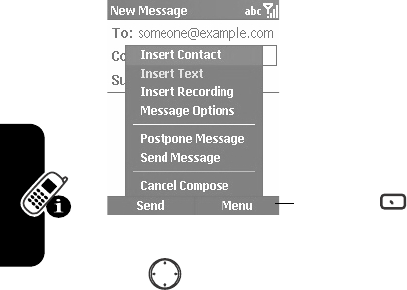
DRAFT
34
Learning to Use Your Phone
the user interface where you can perform the command.
Tip:
Press up to move to the bottom of the menu.
Entering Text and Numbers
You can enter text and numbers on the phone using the
keypad. The phone supports 3 input modes for entering
text and numbers:
Multi-Tap
,
iTAP
, and
Numeric
. The
Multi-Tap
and
iTAP
modes are used for entering text, and the
Numeric
mode
is used for entering numbers. When you select a field that
requires text or numeric entry, the phone automatically
defaults to the appropriate input mode. The status
indicator on the top of the display shows the input mode
you are currently using.
Press
Menu
to display
menu options
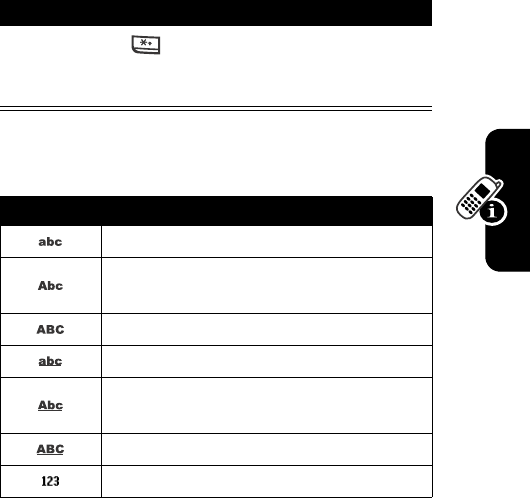
DRAFT
35
Learning to Use Your Phone
Changing Input Modes
The following table shows the complete list of input
mode status indicators.
Entering Text in Multi-Tap Mode
You can enter a letter in
Multi-Tap
mode by pressing the
number key on which the letter appears. To enter the 1st
letter on the number key, press the key once. To enter the
2nd letter, press the key twice, and so on. The letter
entered remains underlined until you complete the
Action
Press and hold until the status indicator for the
input mode you want is shown at the top of the
display.
Indicator Mode
Multi-Tap
text input mode, lower case
Multi-Tap
text input mode, temporarily
upper case
Multi-Tap
text input mode, caps lock
iTAP
text input mode, lower case
iTAP
text input mode, temporarily upper
case
iTAP
text input mode, caps lock
Numeric
input mode
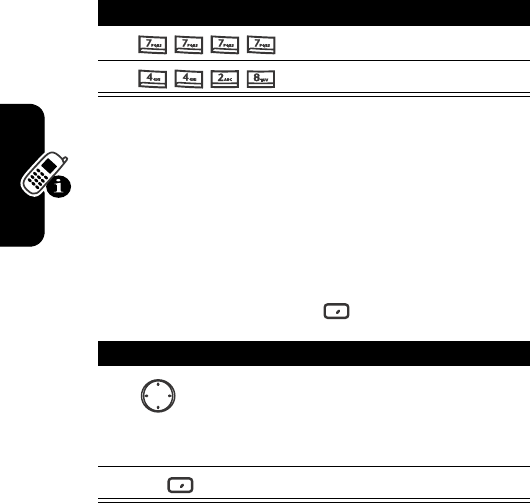
DRAFT
36
Learning to Use Your Phone
keypresses and the cursor moves to the next position. For
example:
When you enter letters that are on the same number
key, wait until the underline disappears before entering
the next letter so that your phone can process the 1st
letter. This pause is called the
Multi-Tap
time out, and you
can adjust the length of the pause between keypresses.
To change the
Multi-Tap
time out:
Press To
1
enter the letter
s
2
enter the word
hat
Find the Feature
Start
>
Settings
>
Accessibility
Press To
1
left/right select the time interval you
want for the pause between
keypresses under
Multipress
time out
2
Done
save the setting
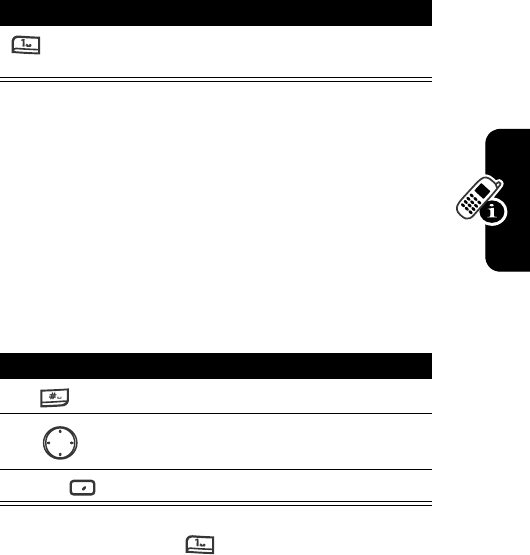
DRAFT
37
Learning to Use Your Phone
Entering Punctuation in Multi-Tap Mode
Entering Numbers in Numeric Mode
When you are in
Numeric
mode, press the number(s) you
want to enter on the keypad. If a field permits a
numerical entry only, such as the
Work
phone field in
Contacts
, the input mode will automatically default to
Numeric
mode. To enter an asterisk (
*
) or a hash sign (
#
),
press the corresponding key on the keypad.
Inserting Symbol
Tip:
You can also press to select and enter a symbol.
Using Special Key Functions
The following is a list of the keys and their corresponding
functions in input mode.
Press To
repetitively scroll through common
punctuation:
.,?! - @:1
Press To
1
for a while open the
Pick a symbol
list
2
scroll to a symbol
3
Done
select and enter the symbol
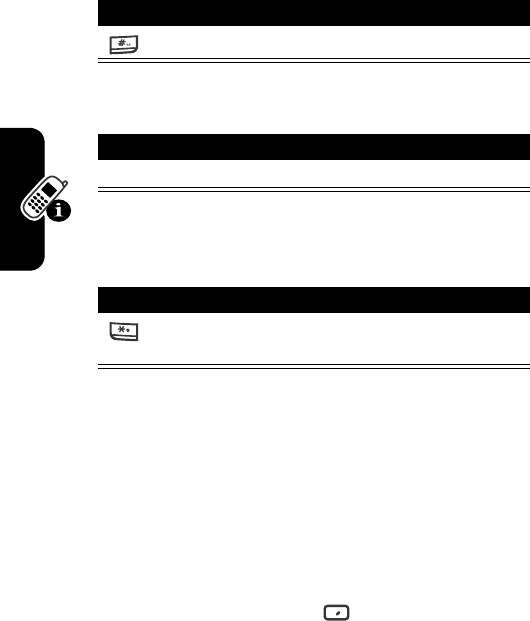
DRAFT
38
Learning to Use Your Phone
To enter a space in
Multi-Tap
mode:
To start a new line:
To change among uppercase, lowercase, and caps
lock:
Tip:
In text mode, the 1st letter of a sentence is
automatically capitalized.
Viewing Phone Information
Use
About
settings to display information about your
phone’s operating system, including version numbers,
copyright information and available storage.
Press To
enter a space
Press To
Action
(
A
)
start a new line
Press To
change among uppercase,
lowercase, and caps lock
Find the Feature
Start
>
Settings
>
About
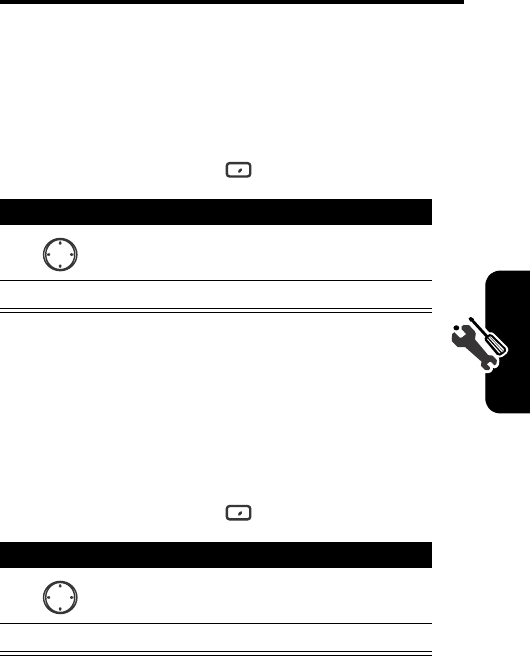
DRAFT
39
Setting Up Your Phone
Setting Up Your Phone
Setting the Time and Date
Use
Date and Time
settings to change the local time zone and
the current date and time, and to set the alarm.
Entering Owner Information
Use
Owner Information
settings to enter and display personal
information, such as your name, phone number, and email
address. In the event that you lose your phone and it is
found, you can be contacted.
Find the Feature
Start
>
Settings
>
More
Press To
1
scroll to
Date and Time
2
Action
(
A
)
set
Date and Time
settings
Find the Feature
Start
>
Settings
>
More
Press To
1
scroll to
Owner Information
2
Action
(
A
)
set
Owner Information
settings
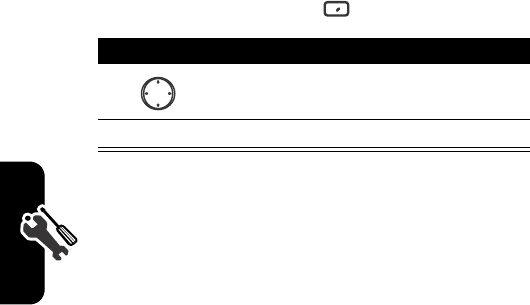
DRAFT
40
Setting Up Your Phone
Configuring Power
Management
Use
Power Management
settings to change the backlight and
display time-outs, and to check the battery level.
Find the Feature
Start
>
Settings
>
More
Press To
1
scroll to
Power Management
2
Action
(
A
)
set
Power Management
settings
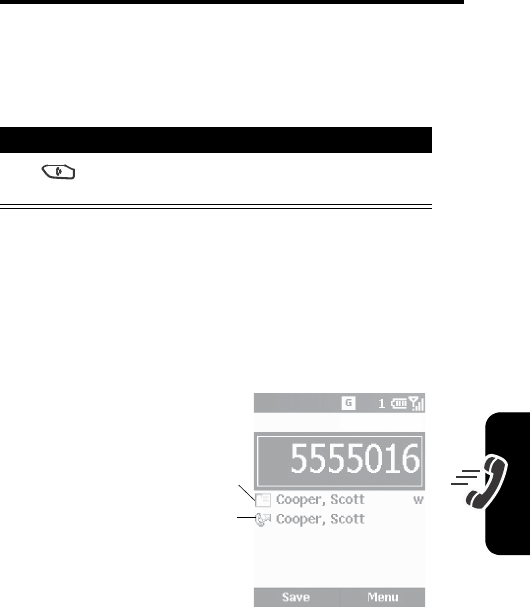
DRAFT
41
Calling Features
Calling Features
Redialing a Number
To redial the last number called from the Home screen:
Calling a Contacts Entry
As you enter a contact name, the phone searches
Contacts
,
Call History
,
Speed Dial
lists, and the SIM card to find a matching
name and number.
Press To
Send
twice place a call to the last dialed
number
Number matches contact
Number matches entry
in Call History
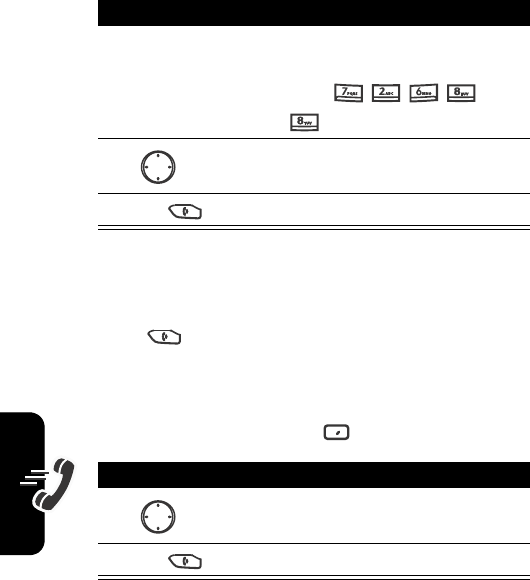
DRAFT
42
Calling Features
Making a Call from the Home Screen
Making a Call from Contacts
You can select a person’s name from your contacts list and
press
Send
to place the call. If a contact has more than
1 phone number, such as
Work
,
Home
, and
Fax
, the
Work
phone number is set as the default.
Tip:
If you have a long list of contacts, enter the 1st few
letters of a contact’s name. Your phone searches the entire
contacts list to display the name.
Press To
1
keypad keys enter the contact name
(For example, to call Scott,
press
.)
2
select the name from your
contacts list
3
Send
make the call
Find the Feature
Start
>
Contacts
Press To
1
scroll to the contact name to
call
2
Send
make the call

DRAFT
43
Calling Features
Changing the Default Number for a Contact
Making a Call to a Desired Phone Number
Find the Feature
Start
>
Contacts
Press To
1
scroll to a desired contact
2
left/right change the default number
(For example, if you change
w
to
m
, the default number
changes from
Work
phone to
Mobile
phone.)
Find the Feature
Start
>
Contacts
Press To
1
scroll to the contact to call
2
Action
(
A
)
open the contact
3
scroll to the number you want
to call
4
Send
place the call
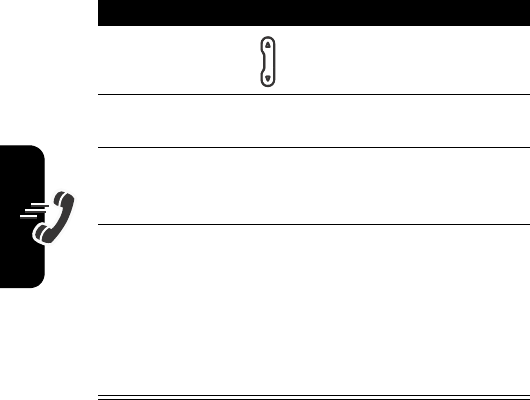
DRAFT
44
Calling Features
Making a Call with Voice
Dialing
You can dial a phone number by speaking a word.
Note:
The voice recognition application works only via the
phone directly or a wired headset attached to the phone,
but not with a Bluetooth headset.
Dialing a Phone Number by Saying the
Name Exactly Saved in Contacts
On the Home screen:
Action
1
Press and hold up to open
Speech Recognition
.
2
Wait for the audio and visual cue and begin
saying
Voice Dial
.
3
Wait for the audio and visual cue and begin
saying the name exactly stored in your contacts
list.
4
If there is only 1 number for this contact, the
phone dials the number automatically. If there
are multiple numbers, the phone displays the
different locations and asks you which 1 to call.
Say the name of the location you want to call, for
example,
Work
. The phone repeats the location
and then dials the number.
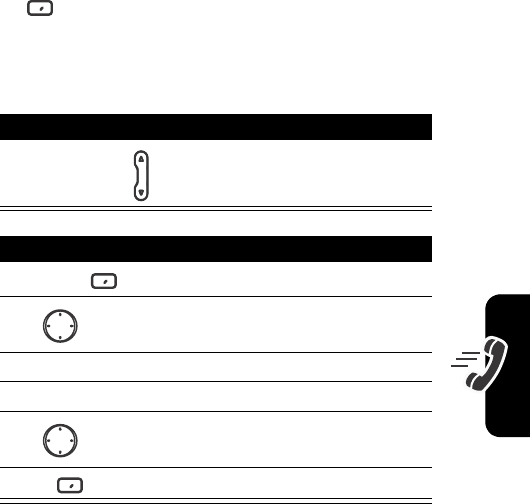
DRAFT
45
Calling Features
Changing How Voice Dial Works with Names
If you want to review and confirm names before dialing the
associated numbers, you must enable
Choice Lists
. After you
say a name, your phone prompts you
Did you say
followed by
the name that most nearly matches the name you spoke.
You can confirm the name by saying
Yes
or pressing
Yes
, or by selecting the correct name from a list of up
to 3 names displayed on the screen.
Choice Lists
is disabled
by default. To enable it, follow the steps from the Home
screen:
Action
Press and hold up to open
Speech Recognition
.
Press To
1
Settings
open the settings menu
2
scroll to
Choice Lists
3
Action
(
A
)
select
Choice Lists
4
Action
(
A
)
select
Name dialing
5
scroll to
Always On
6
OK
save the setting
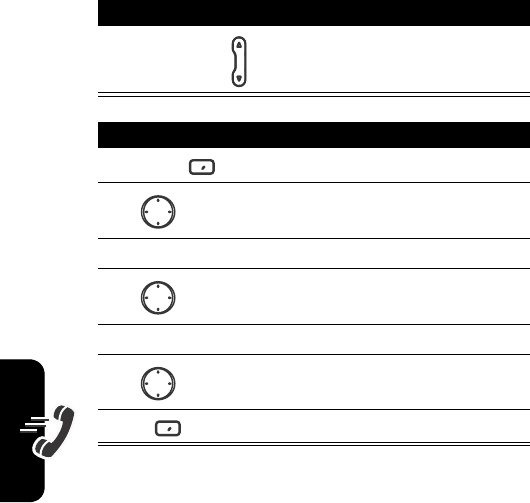
DRAFT
46
Calling Features
Adjusting the Name Sensitivity Setting
If the phone seldom recognizes your name commands,
follow the steps from the Home screen:
Changing How Speech Recognition Updates
Contacts
When you start
Speech Recognition
, it checks to see if you have
added or changed names in your contacts list. If the
contacts list has changed,
Speech Recognition
automatically
reloads the entire list of names. You can also turn off
Action
Press and hold up to open
Speech Recognition
.
Press To
1
Settings
open the settings menu
2
scroll to
Sensitivity
3
Action
(
A
)select
Sensitivity
4
scroll to
Names
5
Action
(
A
)select
Names
6
down adjust the
Names
setting
toward
Reject Less
7
OK
save the setting
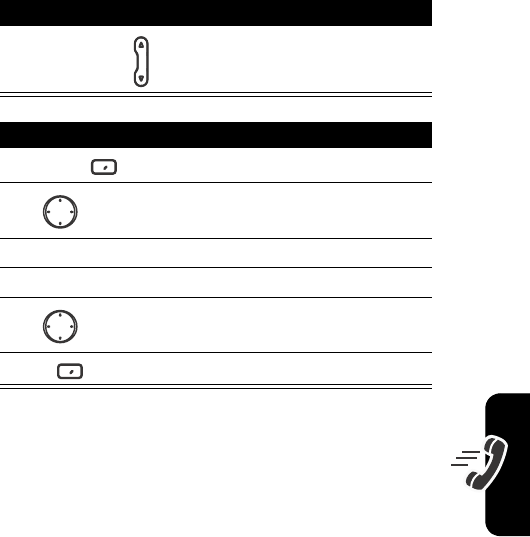
DRAFT
47
Calling Features
automatic update and then update the list manually at your
convenience. To turn off automatic update:
Dialing a Phone Number by Speaking the
Number Continuously
You can dial valid 7-digit or 10-digit phone numbers
simply by speaking the number continuously, without
pausing between the digits.
Note:
The phone recognizes the digits “one,” “two,” “three,”
“four,” “five,” “six,” “seven,” “eight,” “nine,” “zero,” and “oh.”
The phone cannot recognize numbers such as “1 eight
hundred” for “1 800.” Say “one eight zero zero” instead.
Action
Press and hold up to open
Speech Recognition
.
Press To
1
Settings
open the settings menu
2
scroll to
Contacts Update
3
Action
(
A
)
select
Contacts Update
4
Action
(
A
)
select
Configure
5
scroll to
Manual
6
OK
save the setting
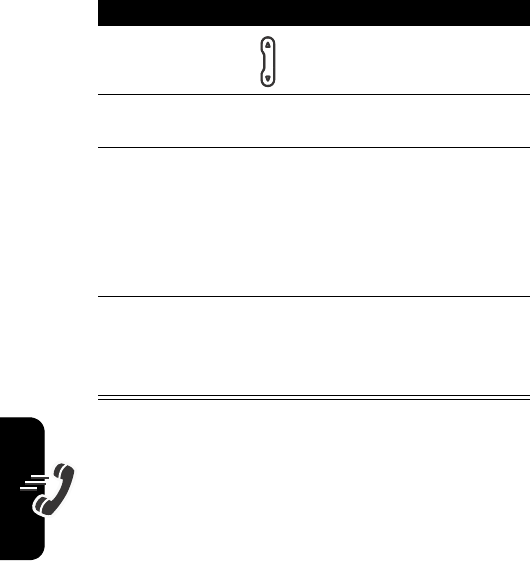
DRAFT
48
Calling Features
On the Home screen:
Changing How Voice Dial Works with Phone
Numbers
By default,
Choice Lists
for
Digit Dialing
is enabled, which
allows you to review and confirm numbers before
dialing them. If you disable
Choice Lists
, the phone
automatically dials the recognized number, without
Action
1
Press and hold up to open
Speech Recognition
.
2
Wait for the audio and visual cue and begin
saying
Voice Dial
.
3
Say a valid 7-digit or 10-digit number
distinctively, without pausing between digits.
Optionally, you can say the 1st digit of the
number and the phone displays a list of up to 3
numbers and prompts you
Did you say
followed by
the 1st number in the list.
4
If the number is correct, say
Yes
to initiate dialing.
If the number is not correct, say
No
to hear the
next match or select the correct number from the
list.
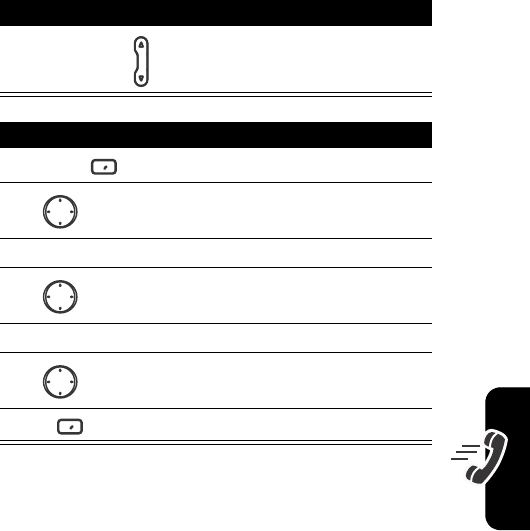
DRAFT
49
Calling Features
requiring you to confirm it. To disable
Choice Lists
from the
Home screen:
Customizing Digit Dialing to Your Voice
You can adapt
Digit Dialing
to your personal accent, if
necessary. Adaptation involves recording 12 sequences of
4 digits each to teach the system your voice.
Action
Press and hold up to open
Speech Recognition
.
Press To
1
Settings
open the settings menu
2
scroll to
Choice Lists
3
Action
(
A
)
select
Choice Lists
4
scroll to
Digit Dialing
5
Action
(
A
)
select
Digit Dialing
6
scroll to
Always On
7
OK
save the setting
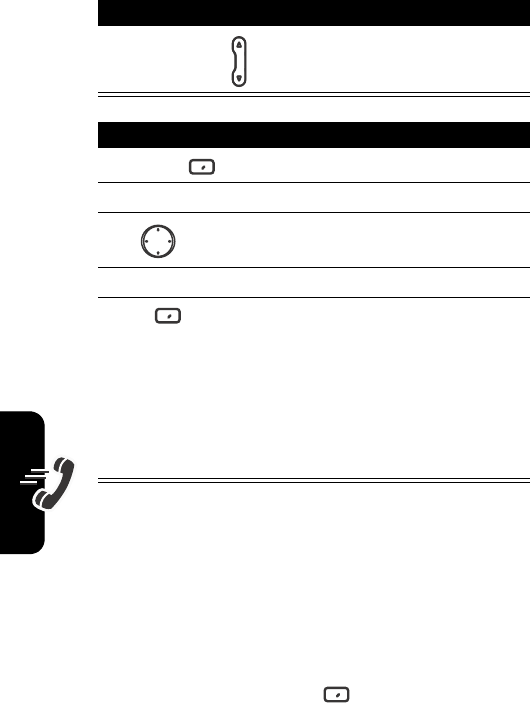
DRAFT
50
Calling Features
On the Home screen:
Making a Call from the Call
History List
The
Call History
list displays the last 25 calls you made,
received, or missed. Choose a name or number to call
from the list.
Action
Press and hold up to open
Speech Recognition
.
Press To
1
Settings
open the settings menu
2
Action
(
A
)
select
Digit Dialing
3
scroll to
Adapt Digits
4
Action
(
A
)
select
Adapt Digits
5
OK
to start recording
Tip:
Wait for the beep and
then repeat the digits of the
1st sequence displayed on
the screen. Then follow the
instructions on the screen to
complete the adaptation.
Find the Feature
Start
>
Call History
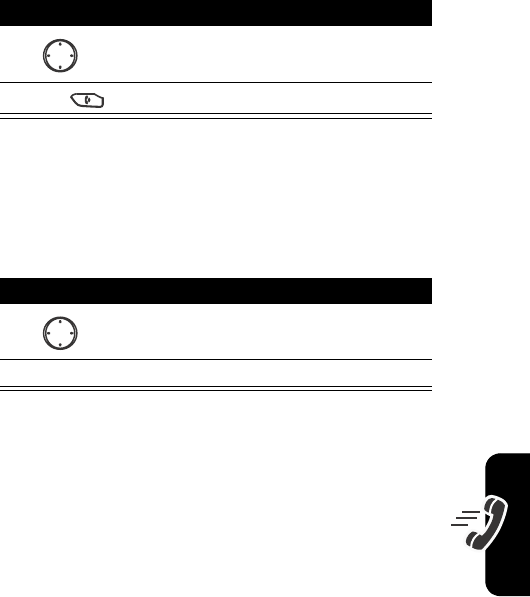
DRAFT
51
Calling Features
Calling a Number in a Message
When you see an underlined phone number as a hyperlink
in a message, you can place a call to the phone number.
After opening a message:
Calling an Emergency Number
Calls to emergency service numbers can be made under
any circumstances, even if you have locked the SIM
card and/or the phone.
Note:
Be aware that when the
Flight mode
feature is turned
on, the phone cannot receive and make a call, including an
emergency call. In order to receive and make a call, you
must turn off the
Flight mode
feature and re-engage the
phone’s RF capability. Always obey the instructions of your
airline crew.
Press To
1
scroll to the number or entry
to call
2
Send
place the call
Press To
1
scroll to the phone number as
a hyperlink
2
Action
(
A
)
place the call
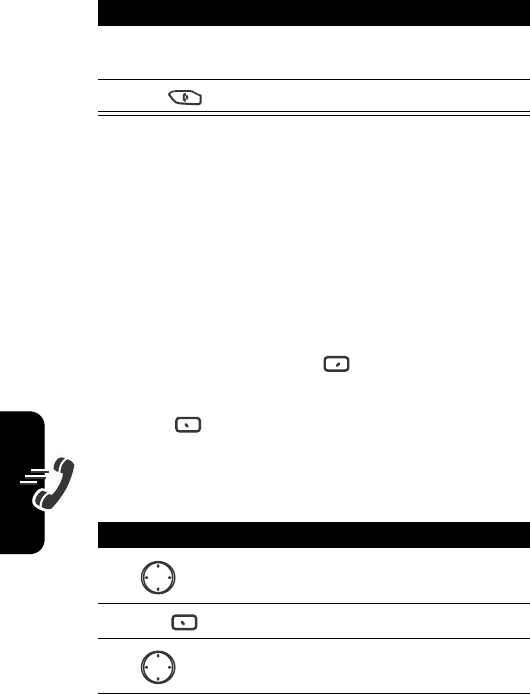
DRAFT
52
Calling Features
On the Home screen:
Managing Call History
Call History
displays the last 25 calls you have made,
received, and missed. Each entry in
Call History
contains the
start time of the call, the duration, the caller’s name, if
available, and the caller’s number. The oldest calls are
automatically deleted from the list to make room for new
calls.
Tip:
You can filter
Missed Calls
,
Incoming Calls
, and
Outgoing Calls
by
pressing
Menu
, selecting
Filter
, and selecting the filter
you want.
Sending an Email from Call History
Press To
1
keypad keys dial your local emergency
number
2
Send
place the call
Find the Feature
Start
>
Call History
Press To
1
scroll to a desired entry
2
Menu
open the options menu
3
scroll to
E-mail
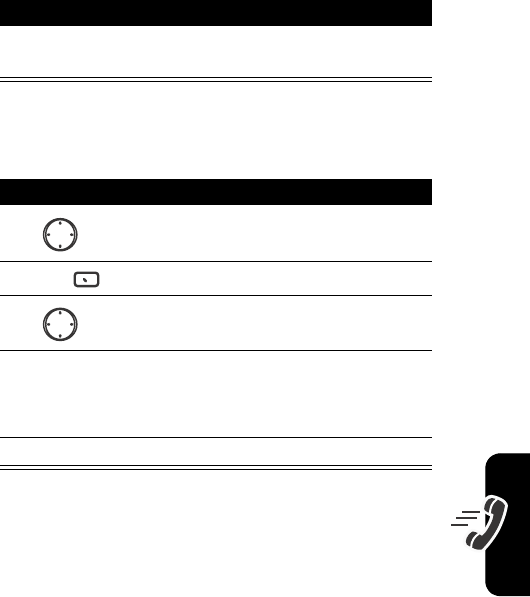
DRAFT
53
Calling Features
Creating a New Contact from a Number in
Call History
Calling with Speed Dial
You can quickly dial phone numbers by assigning
speed dial numbers. Press and hold 1 or 2 keys from the
Home screen to make a speed dial call. Choose speed dial
entries from 2-99. The speed dial entry 1 is often reserved
to set up or dial your voicemail after initial setup.
Note:
The
Speed Dial
setting is available only for a phone
number stored in the phone memory.
4
Action
(
A
)
edit and send an email to the
entry’s recipient
Press To
1
scroll to a desired entry
2
Menu
open the options menu
3
scroll to
Save to Contacts
4
Action
(
A
)
select
Save to Contacts
Note:
Make sure
<New Item>
is
highlighted.
5
Action
(
A
)
enter the contact information
Press To
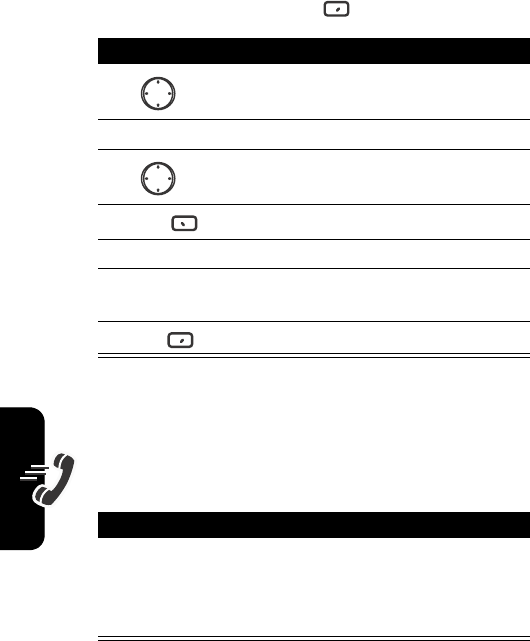
DRAFT
54
Calling Features
To create a speed dial shortcut 1st:
Tip:
You can also assign speed dial numbers to Web
addresses and email addresses that are stored in
Contacts
of your phone.
To make a speed dial call from the Home screen:
Find the Feature
Start
>
Contacts
Press To
1
scroll to a desired contact
2
Action
(
A
)
open the contact
3
scroll to a desired phone
number
4
Menu
open the options menu
5
Action
(
A
)
select
Add Speed Dial
6
keypad keys enter the speed dial number
under
Keypad assignment
7
Done
save the setting
Action
Press and hold the keypad number that you have
assigned as a speed dial number. If the keypad
assignment has 2 digits, press the 1st digit, then
press and hold the 2nd digit.
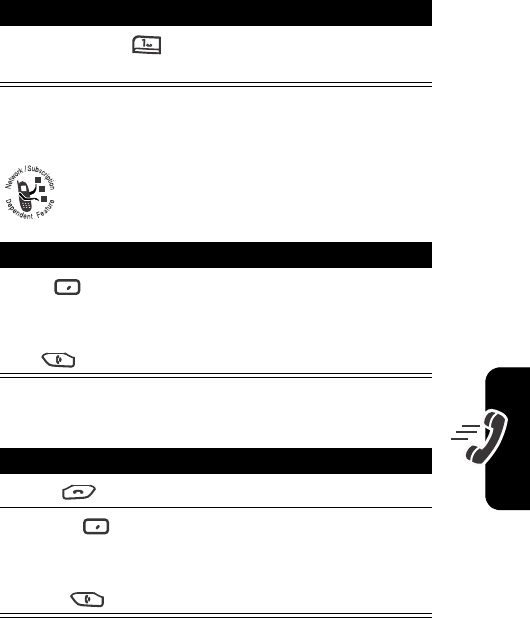
DRAFT
55
Calling Features
Using Voicemail
On the Home screen:
Using Call Waiting
To answer the incoming call when you are talking
on the phone:
To end the 1st call before answering the incoming call:
Action
Press and hold to automatically call voicemail
after initial setup.
Press To
Accept
or
Send
place the 1st call on hold, and
answer the 2nd call
Press To
1
End
end the 1st call
2
Accept
or
Send
answer the 2nd call
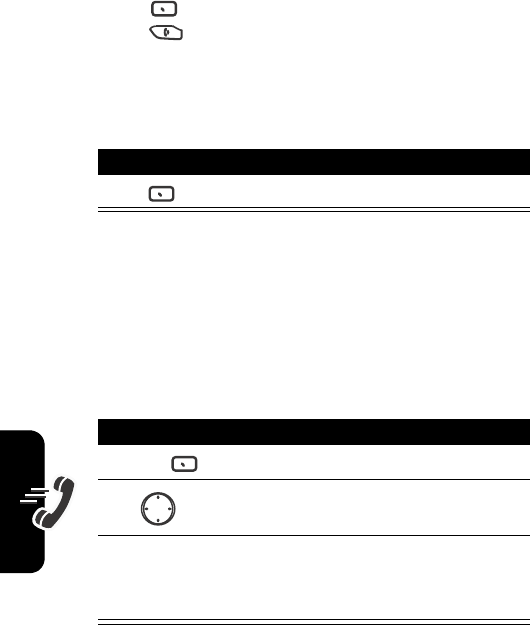
DRAFT
56
Calling Features
Tip:
If the 2nd call is answered but the caller hangs up,
press
Menu
and select
Unhold
to rejoin the original call.
Press
Send
to change between an active call and a call
that is on hold.
To reject the incoming call when you are talking on the
phone:
This will keep your current call in progress, but will reject
the
Call Waiting
call.
Putting a Call on Hold
While a call is in progress, you can hold the call and then
reconnect it.
Press To
Reject
reject the 2nd call
Press To
1
Menu
open the options menu
2
scroll to
Hold
3
Action
(
A
)
place the active call on hold
Tip:
Select
Unhold
to activate
the call on hold.
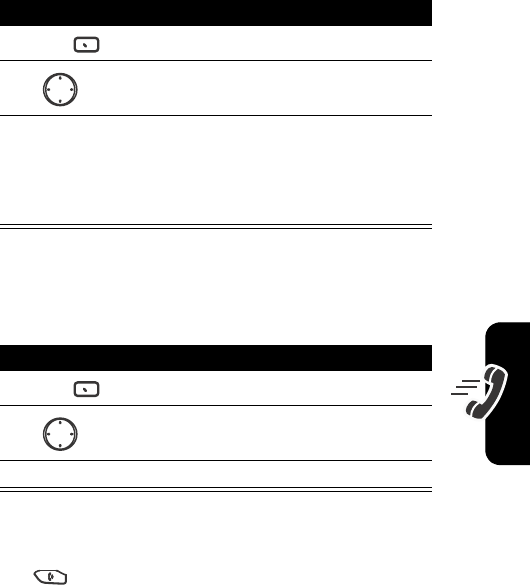
DRAFT
57
Calling Features
Muting a Call
You can mute the microphone for the active call. The other
party will not hear anything you say, but you can still hear
the other party.
Turning the Speaker On/Off
You can turn the speaker on or off during a call.
Tip:
During an incoming or outgoing call, you can toggle
between the earpiece and speakerphone by holding down
Send
.
Press To
1
Menu
open the options menu
2
scroll to
Mute
3
Action
(
A
)
mute the active call
Tip:
Select
Unmute
to turn the
microphone back on for the
active call.
Press To
1
Menu
open the options menu
2
scroll to
Speakerphone
/
Speakerphone Off
3
Action
(
A
)
turn the speaker on/off
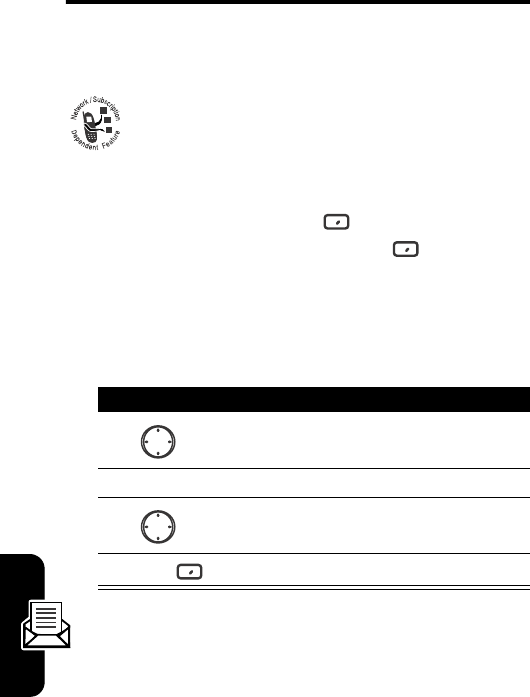
58
Messages and Chat
DRAFT
Messages and Chat
Composing an MMS Message
MMS messages are created by combining
various slides. Each slide can consist of a photo
or video, audio (only when photos are used), and
text.
Adding a Photo/Video
You can add a still image or video clip to each slide in your
MMS message.
Find the Feature
Start
>
Messaging
>
Media
Messages
>
New
Press To
1
highlight the
Picture/Video
area
2
Action
(
A
)
open
My Pictures
3
scroll to a desired photo or
video clip
4
Select
add the photo or video clip
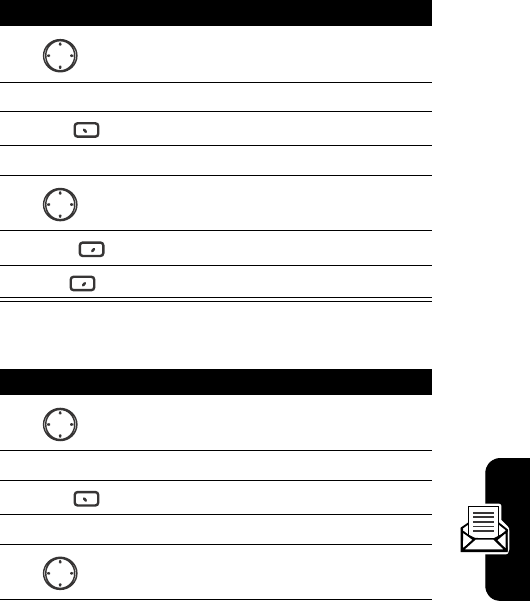
DRAFT
59
Messages and Chat
Adding Text
You can add new text or preset words/phrases to each
slide in your MMS message.
Using Preset Words or Phrases
Editing Preset Words or Phrases
Press To
1
highlight the
Text
area
2
Action
(
A
)
open the text field
3
Menu
open the options menu
4
Action
(
A
)
select
Insert Canned Text
5
scroll to a desired phrase
6
Select
select the phrase
7
Done
add the phrase
Press To
1
highlight the
Text
area
2
Action
(
A
)
open the text field
3
Menu
open the options menu
4
Action
(
A
)
select
Insert Canned Text
5
scroll to a desired phrase
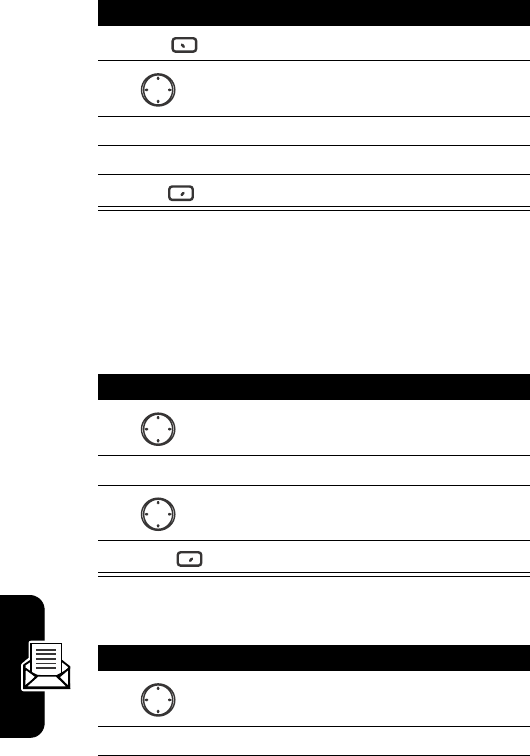
60
Messages and Chat
DRAFT
Adding Audio
You can add preset or recorded audio clips to each slide,
except when videos are used.
Using a Preset Audio Clip
Using a Recorded Audio Clip
6
Menu
open the options menu
7
scroll to
Edit
8
Action
(
A
)
select
Edit
9
keypad keys edit the phrase
10
Save
save the phrase
Press To
1
highlight the
Audio
area
2
Action
(
A
)
open
My Sounds
3
scroll to a desired audio clip
4
Select
add the audio clip
Press To
1
highlight the
Audio
area
2
Action
(
A
)
open
My Sounds
Press To
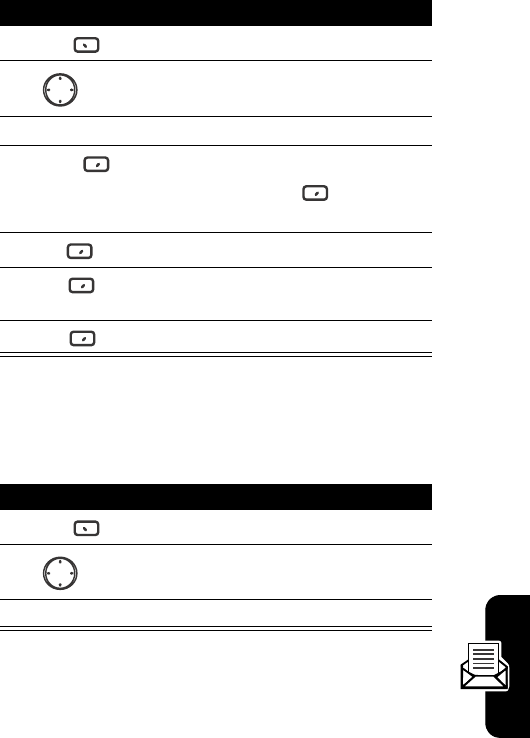
DRAFT
61
Messages and Chat
Managing Slides
You can add, remove, or jump to additional slides in your
MMS message.
3
Menu
open the options menu
4
scroll to
Capture Audio
5
Action
(
A
)
select
Capture Audio
6
Record
record your audio clip
Tip:
Press
Stop
to stop
recording, if necessary.
7
Play
play your audio clip
8
Stop
stop playing your audio clip or
confirm your audio clip
9
Done
add the audio clip
Press To
1
Menu
open the options menu
2
scroll to
Slides
3
Action
(
A
)
select
Slides
Press To
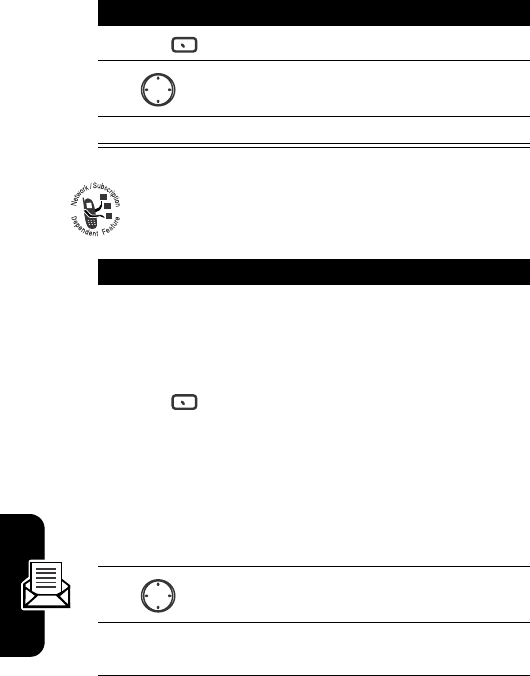
62
Messages and Chat
DRAFT
Previewing Your MMS Message
You can preview your message before sending it.
Sending Your MMS
Message
Press To
1
Menu
open the options menu
2
scroll to
Preview Message
3
Action
(
A
)
preview your MMS message
Press To
1
keypad keys
or
Menu
>
Recipients
>
Add
enter in your recipient’s
phone number/email address
in the
To
field
or
select a recipient from your
contacts list.
Tip:
You can add other phone
numbers/email addresses/
recipients separated by
semicolons.
2
down highlight the
Subject
field
3
keypad keys enter in a subject of your
message
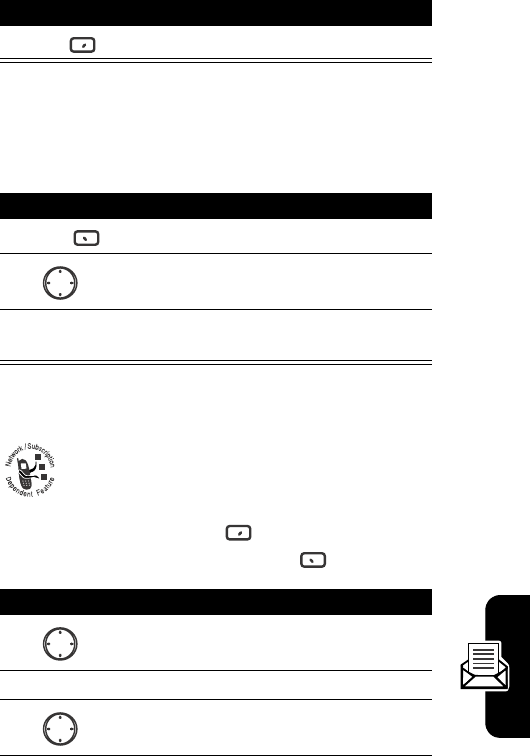
DRAFT
63
Messages and Chat
Configuring the Sending Performance
You can customize how your MMS message is going to be
sent using the menu options.
Viewing Your MMS Message
You can view MMS messages in different
message boxes.
4
Send
send your MMS message
Press To
1
Menu
open the options menu
2
scroll to
Send Options
3
Action
(
A
)
configure the sending
performance
Find the Feature
Start
>
Messaging
>
Media
Messages
>
Menu
>
Folders
Press To
1
scroll to a desired message
box
2
Action
(
A
)
select the message box
3
scroll to a desired message
Press To
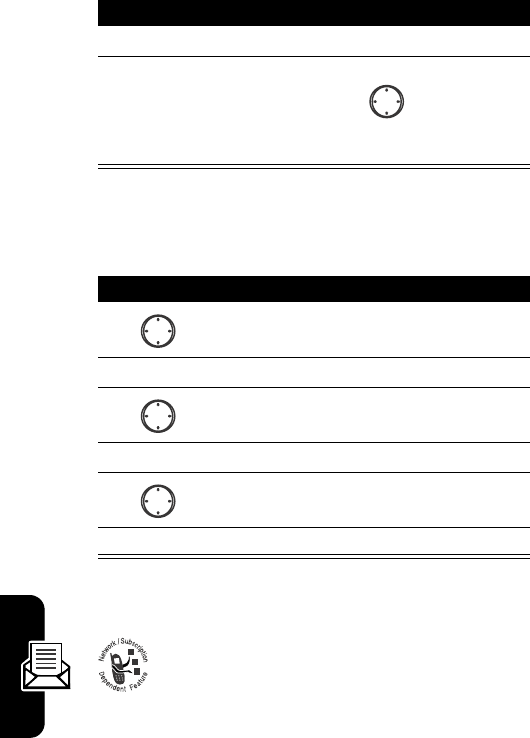
64
Messages and Chat
DRAFT
Viewing Objects in an MMS Message
You can view objects included in an MMS message.
Configuring the MMS Setting
You can save the messages you sent,
download new messages automatically, sort
messages by different ways, define the
maximum size limit for messages that you send and
receive, set the number of times you attempt to send your
4
Action
(
A
)
select the message
5
Action
(
A
)
view the message
Tip:
Press to navigate to
other slides if more than one
are present.
Press To
1
scroll to a desired message
box
2
Action
(
A
)
select the message box
3
scroll to a desired message
4
Action
(
A
)
select the message
5
scroll to a desired object
6
Action
(
A
)
view the object
Press To
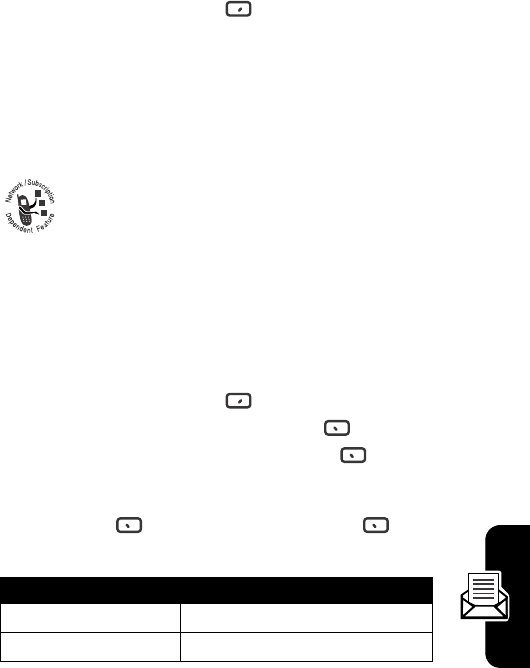
DRAFT
65
Messages and Chat
messages before stopping, and select your type of Internet
connection.
Tip:
You might view and edit your MMSC URL and WAP
gateway using the menu options. You will likely never need
to change these settings.
Configuring an Email Account
Before sending and receiving email messages,
you may have to complete the email account
setup. You can send email messages by
synchronizing, or by connecting directly to an email server
through your Internet Service Provider (ISP) or a corporate
network. Your service provider may have configured email
settings for your phone before you received it; otherwise,
you must configure your phone to send/receive emails.
Fill in the blanks with the appropriate information.
Tip:
Press
Next
to continue and press
Finish
to
complete the email setup.
Find the Feature
Start
>
More
>
MMSSettings
Find the Feature
Start
>
Messaging
>
Outlook E-Mail
>
Menu
>
Options
>
Account Setup
>
Menu
>
New
Option Description
Your name
enter in your name
E-mail address
enter in your email address
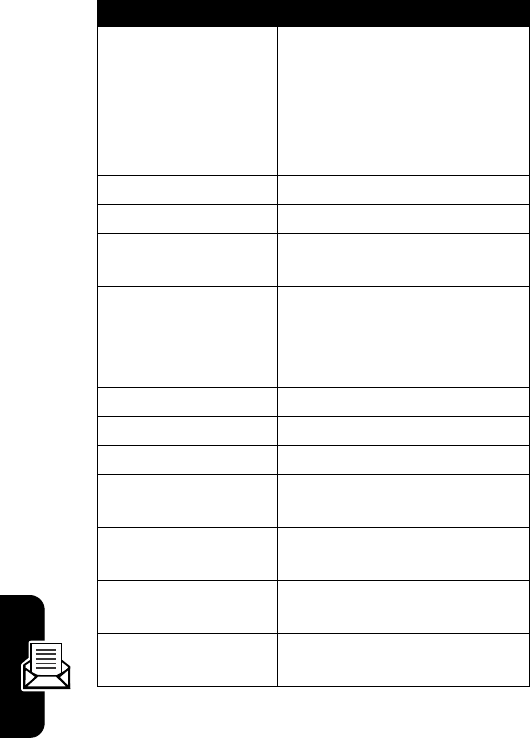
66
Messages and Chat
DRAFT
Automatic setup
If you check this feature, your
phone will obtain email
settings from the Internet. If
you uncheck this feature,
continue the following
options.
User name
enter in your user name
Password
enter in your password
Domain (if necessary)
enter in your domain name, if
necessary
Save password
Check this feature and you
need not to enter your
password repeatedly before
you can send/receive emails.
Server type
select either
POP3
or
IMAP4
Account name
enter in your account name
Network
select
The Internet
Incoming mail server
enter in your incoming mail
server
Require SSL connection
check this feature, if
necessary
Outgoing mail server
enter in your outgoing mail
server
Outgoing server requires
authentication
check this feature, if
necessary
Option Description
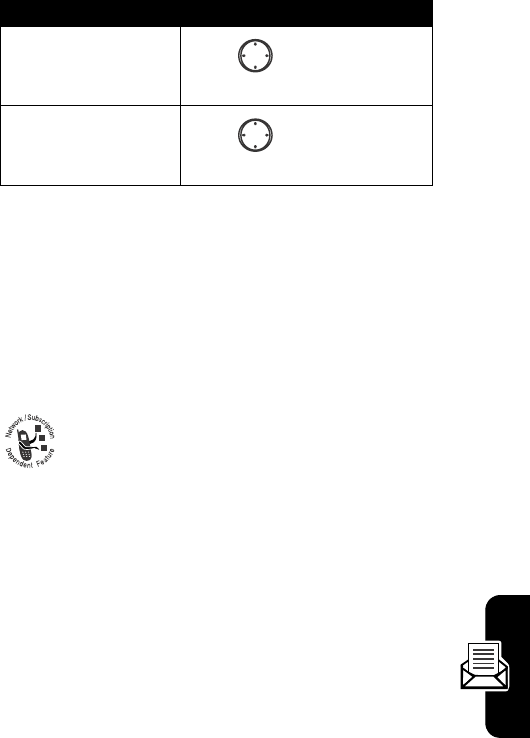
DRAFT
67
Messages and Chat
Note:
You can only have one configurable
Outlook
E-Mail
at
one time and therefore only synchronize one type of email,
either POP3 or desktop. If you choose to synchronize your
desktop email, it will wipe out your POP3 settings.
Receiving Email from the
Internet
You can receive email messages through
Inbox
synchronization or by connecting to your email
server. You can then view all of your email
messages in
Messaging
>
Outlook E-Mail
. When you connect to
the email server or synchronize
Inbox
with your desktop
computer, only the first 5 KB of each new message are
downloaded by default to your phone. If you are using an
IMAP4 or POP3 server, only the first 1 KB of each new
message is downloaded by default. Small attachments are
downloaded and the original messages remain on the
email server or your desktop computer.
Download the following
messages
press left/right to select
features
Connect automatically and
check for messages
press left/right to select
a feature
Option Description
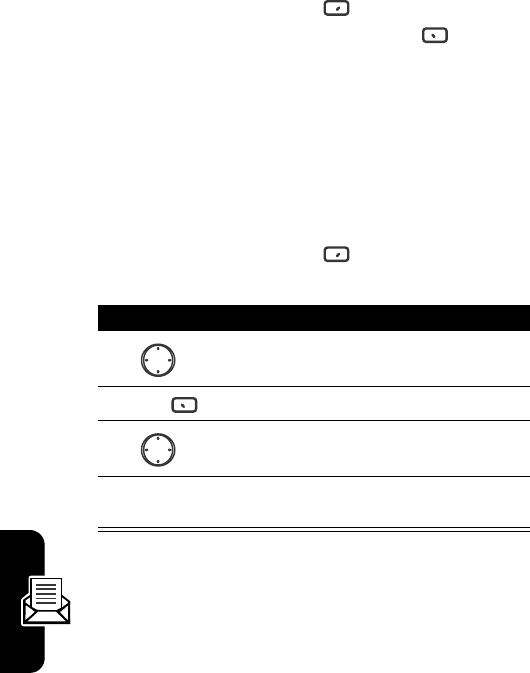
68
Messages and Chat
DRAFT
Tip:
For more information about synchronizing
Inbox
, see
“Synchronizing Information among Devices” on page 110.
Receiving Complete Email Messages
You can specify to receive email messages in full, instead
of receiving only the first 5 KB set by default. The complete
message will be retrieved the next time you synchronize or
connect to your email server.
Tip:
When you delete an email message on your
phone, it will also be deleted from the email server the
next time you connect.
Find the Feature
Start
>
Messaging
>
Outlook E-Mail
>
Menu
>
Send/
Receive
Find the Feature
Start
>
Messaging
>
Outlook E-Mail
Press To
1
scroll to a desired email
message
2
Menu
open the options menu
3
scroll to
Mark for Download
4
Action
(
A
)
receive the email message in
full
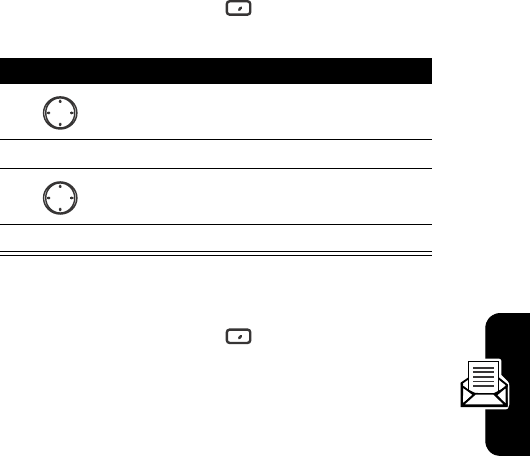
DRAFT
69
Messages and Chat
Receiving Email Attachments
You can download email attachments to your phone.
Attachments display as a list of hyperlinks at the bottom of
the email message, and are preceded by an attachment
icon. The text of the hyperlink contains the file name
followed by the size of the attachment, so that you can
determine whether to download the attachment. The
attachment icon has 3 states:
Not downloaded
,
Downloaded
, and
Marked for Download
.
Tip:
On POP3 messages, the attachment size is omitted.
Viewing a Downloaded Attachment
Find the Feature
Start
>
Messaging
>
Outlook E-Mail
Press To
1
scroll to a message that
contains an attachment(s)
2
Action
(
A
)
select the message
3
scroll to a desired attachment
4
Action
(
A
)
receive the attachment
Find the Feature
Start
>
Messaging
>
Outlook E-Mail
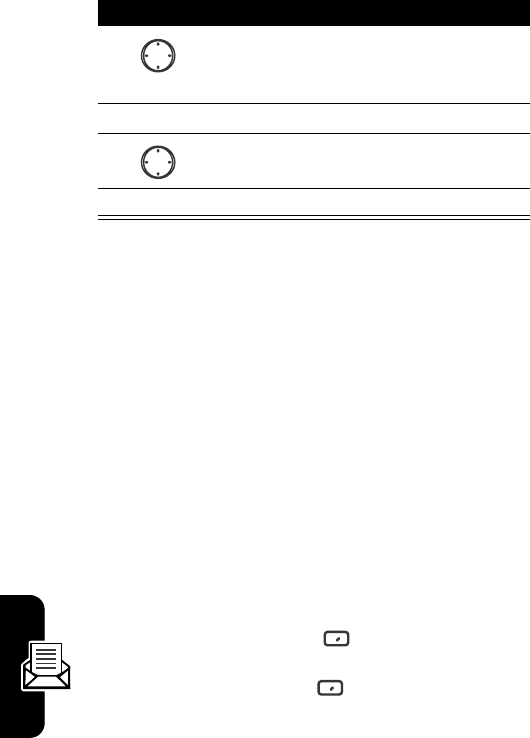
70
Messages and Chat
DRAFT
Note:
You can view attachments only for file types that are
supported by your phone, such as .txt, .JPEG, .asf, .asx,
.wax, .wm, .wma, .wmv, .wmx, .wvx, .mp3. A third party
application must be downloaded to your phone to view
attachment in other formats.
Composing and Sending an
Email/SMS Message
There are several ways to edit and send email and SMS
messages with your phone. The most common way is from
Messaging
or from
Contacts
.
Composing and Sending an Email/SMS
Message from Messaging
Press To
1
scroll to a message that
contains a downloaded
attachment(s)
2
Action
(
A
)
select the message
3
scroll to a desired attachment
you downloaded
4
Action
(
A
)
view the attachment
Find the Feature
Start
>
Messaging
>
Text Messages
/
Outlook E-Mail
>
New
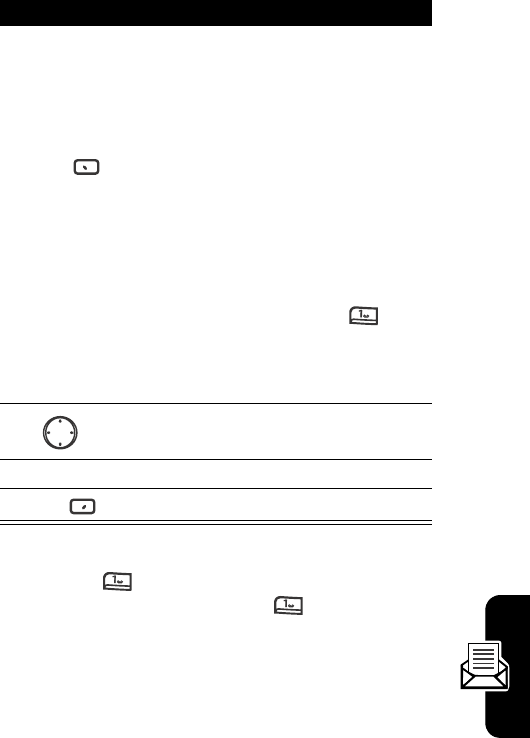
DRAFT
71
Messages and Chat
Tip:
To insert the @ sign in an email address in
Multi-Tap
mode, press once. Then, when you need to insert the
period in the email address, press again.
Press To
1
keypad keys
or
Menu
>
Insert
Contact
enter in your recipient’s
(SMS) phone number/email
address in the
To
field
or
select a recipient from your
contacts list.
Tip:
To add multiple recipients
either in
To
and/or
Cc
field
(
Outlook E-Mail
only), separate
each with a semicolon by
repeatedly pressing in
Multi-Tap
mode. Enter in your
subject in the
Subj
field for your
email message.
2
down highlight the body text field
3
keypad keys enter in your message
4
Send
send your message
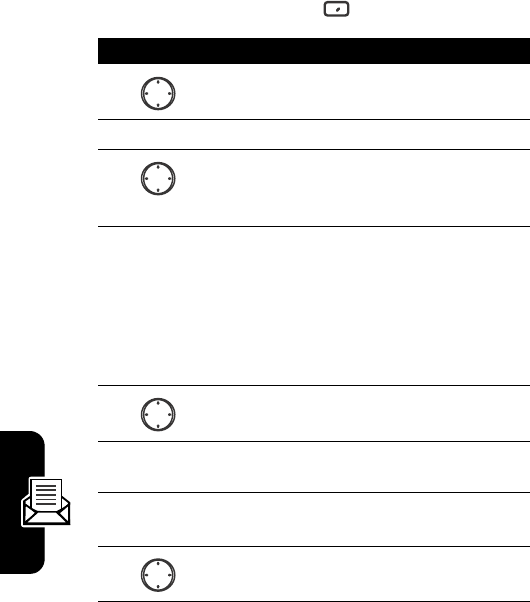
72
Messages and Chat
DRAFT
Composing and Sending an Email/SMS
Message from Contacts
You can quickly edit and send a message to a contact if
you have an email address or SMS number (phone
number) included in
Contacts
.
Find the Feature
Start
>
Contacts
Press To
1
scroll to a desired contact
2
Action
(
A
)
select the contact
3
scroll to a desired email
address or (SMS) phone
number
4
Action
(
A
)
select the email address or
(SMS) phone number
Tip:
Skip steps 5-8 if you
select a (SMS) phone
number for your SMS
message.
5
scroll to
Text Messages
or
Outlook
E-Mail
for your email message
6
Action
(
A
)
select
Text Messages
or
Outlook E-
Mail
7
keypad keys enter in your subject in the
Subj
field
8
down highlight the body text field
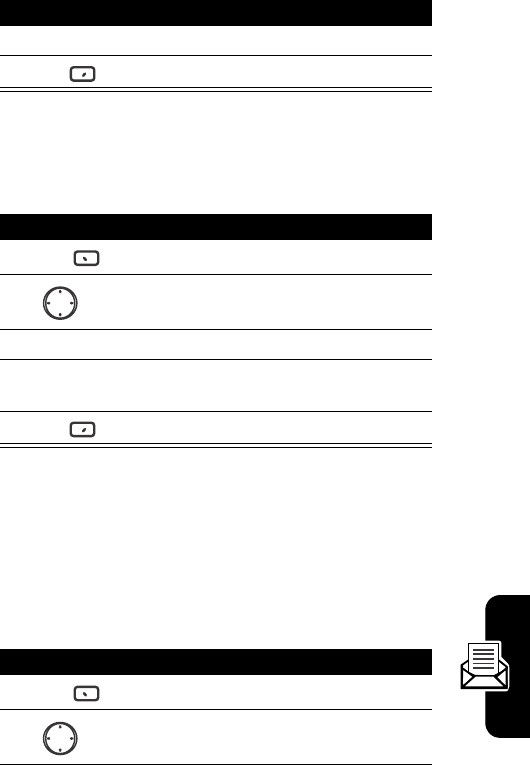
DRAFT
73
Messages and Chat
Requesting a Delivery Receipt for Your Message
Before You Send It
In the body text field:
Inserting Predefined Text into Your Message
Save time when composing messages by inserting
predefined text into your messages. You can edit the
predefined text to create words or phrases that you
frequently use in messages. In the body or subject text
field:
9
keypad keys enter in your message
10
Send
send your message
Press To
1
Menu
open the options menu
2
scroll to
Message Options
3
Action
(
A
)
select
Message Options
4
Action
(
A
)
check
Request message delivery
notification
5
Done
save the setting
Press To
1
Menu
open the options menu
2
scroll to
Insert Text
Press To
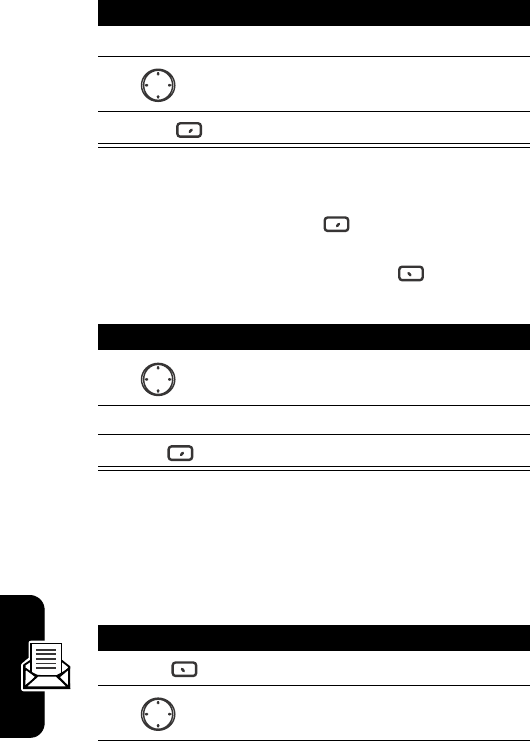
74
Messages and Chat
DRAFT
Editing Predefined Text
Inserting a Voice Recording into Your Email
Insert a voice recording into an email message when you
want to verbally explain information that is contained in the
email message. In the body text field:
3
Action
(
A
)
select
Insert Text
4
scroll to a desired preset text
5
Insert
insert the preset text
Find the Feature
Start
>
Messaging
>
Text Messages
/
Outlook E-Mail
/
Media
Messages
>
Menu
>
Options
>
Edit My Text
Press To
1
scroll to a desired preset text
to modify
2
keypad keys edit the text
3
Done
save the text
Press To
1
Menu
open the options menu
2
scroll to
Insert Recording
Press To
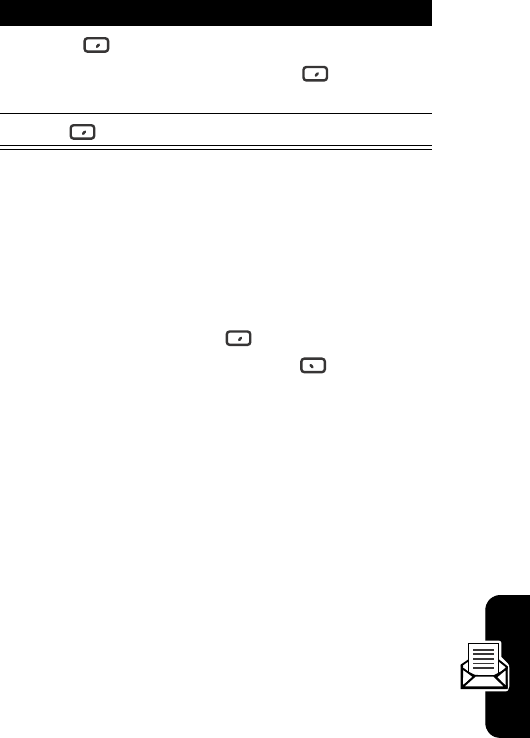
DRAFT
75
Messages and Chat
Note:
You can create only one voice recording at a time. A
new voice recording replaces the prior recording.
Importing SMS Messages from
Your SIM Card to Messaging
Note:
You cannot export messages from your phone to a
SIM card. SMS messages are not removed from the SIM
card after they are imported to
Messaging
of your phone.
Opening Email/SMS Messages
Email and SMS messages that are sent to you are stored
in
Messaging
. By default, the most recently received
messages display at the top of the
Inbox
list. Use the menu
options to quickly compose, delete, forward, and reply
to messages. You can also customize
Messaging
settings
to control the way you send, receive, and view
messages.
3
Record
start recording
Tip:
Press
Stop
to stop
recording.
4
Done
insert the recording
Find the Feature
Start
>
Messaging
>
Text
Messages
>
Menu
>
Options
>
Import SIM Messages
Press To
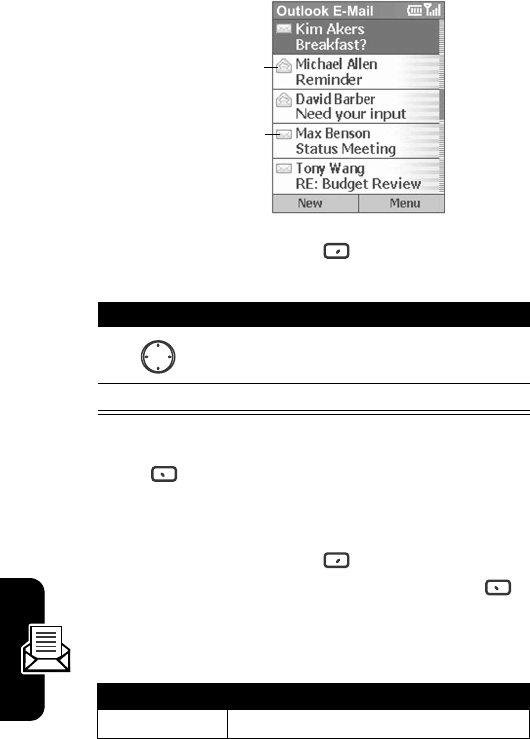
76
Messages and Chat
DRAFT
Tip:
If you want to create a contact card for the sender,
press
Menu
and select
Save to Contacts
.
Using Messaging Menu Options
The following table lists
Messaging
menu options and their
functions.
Find the Feature
Start
>
Messaging
>
Text
Messages
/
Outlook E-Mail
Press To
1
scroll to a desired message
2
Action
(
A
)
view the message
Find the Feature
Start
>
Messaging
>
Text
Messages
/
Outlook E-Mail
>
Menu
Option Description
Delete
delete the selected message
Indicates
opened
email
Indicates
new
email
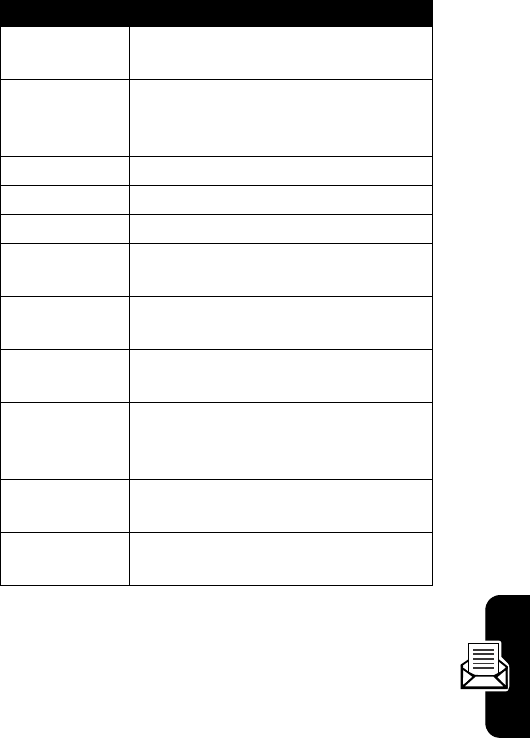
DRAFT
77
Messages and Chat
Reply
reply to an open or selected
message
Reply All
reply to the sender and all recipients
included in an open or selected
message
Forward
forward the selected message
Folders
display all
Messaging
folders
Switch Accounts
change among
Messaging
accounts
Move
move the selected message to a
desired folder
Mark as Read
change the selected unread
message to a read message
Mark as Unread
change the selected read message
to an unread message
Mark for Download
retrieve the entire email message
from the email server the next time
you connect
Options
display a list of
Messaging
options that
you can customize (see below)
Send/Receive
connect to your email server to
send and receive messages
Option Description
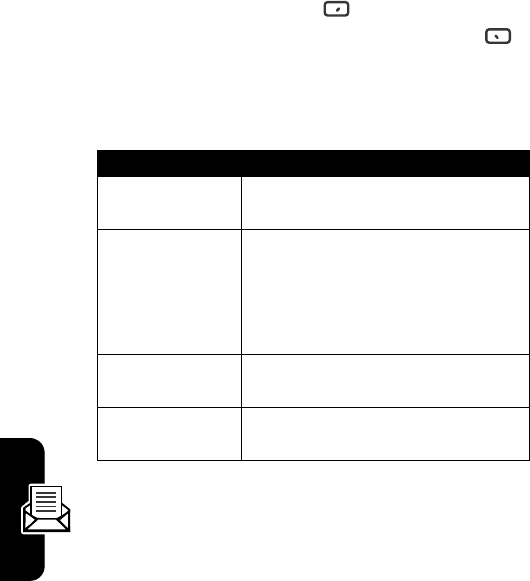
78
Messages and Chat
DRAFT
Customizing Messaging Options
You can optimize your phone’s
Messaging
by changing the
way your messages display and send, specifying how to
sort your messages, creating your text phrase and
signature, and more.
The following table lists the
Messaging
options and their
functions.
Find the Feature
Start
>
Messaging
>
Text
Messages
/
Outlook E-Mail
>
Menu
>
Options
Option Description
Display
change the message information
displayed on the screen
Sending
specify whether you want to
include an original copy of the
message in your reply, save a
copy of your sent messages, or
use Unicode for SMS messages
Edit My Text
edit the predefined text that you
can insert in messages
Signatures
edit your own signature that you
can insert in messages
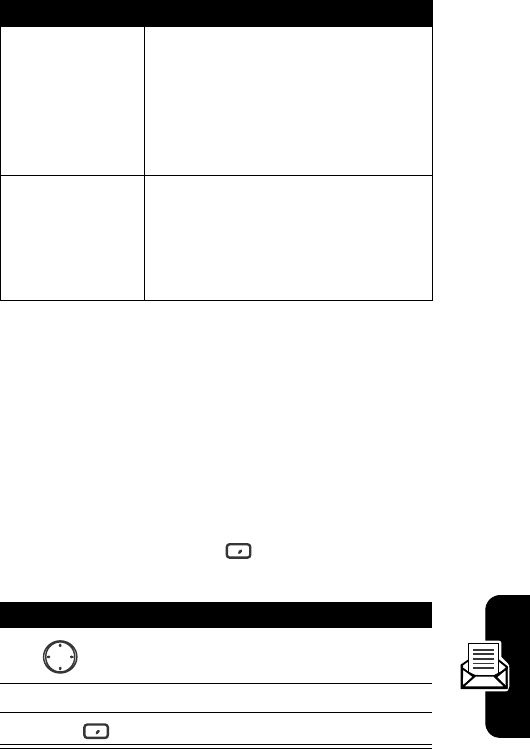
DRAFT
79
Messages and Chat
Receiving Meeting Requests
When you accept a meeting request that arrives in
Messaging
, the meeting immediately appears in
Calendar
on
your phone, and a message will be sent back to the
meeting organizer the next time you synchronize
Calendar
.
Tip:
For more information about synchronizing
Calendar
, see
“Synchronizing Information among Devices” on page 110.
Account Setup
configure your phone to send and
receive email messages (Your
service provider or network
administrator can provide you with
the necessary information to
connect to your email server.)
Import SIM Messages
import SMS messages from your
SIM card to
Messaging
>
Text Messages
(The messages are not removed
from the SIM card after they are
imported.)
Find the Feature
Start
>
Messaging
>
Text
Messages
/
Outlook E-Mail
Press To
1
scroll to a desired meeting
request
2
Action
(
A
)
select the meeting request
3
Accept
accept the meeting request
Option Description
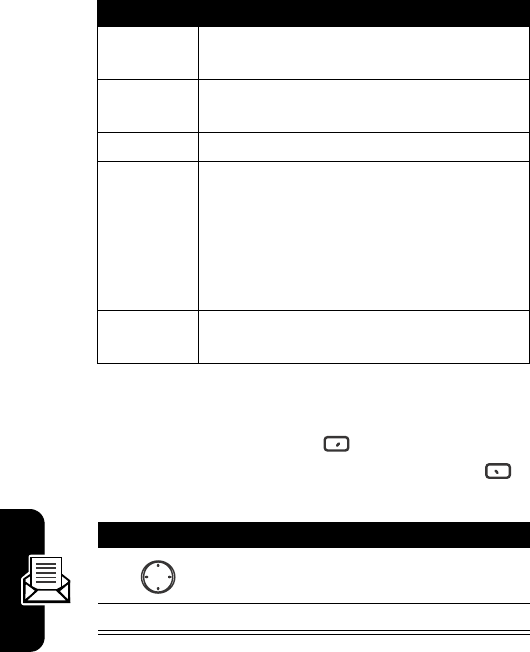
80
Messages and Chat
DRAFT
Viewing Your Message Folders
Your phone stores messages in the following folders:
To view your message folder:
Folder Description
Deleted Items
Deleted messages are stored until you
empty this folder.
Drafts
Messages that you save before
sending are stored.
Inbox
All received messages arrive by default.
Outbox
Sent email messages are stored until
you synchronize or connect to your
email server. SMS messages are sent
immediately over the network and will
appear in your
Outbox
folder for only a
few seconds.
Sent Items
Copies of email messages that you
send are stored.
Find the Feature
Start
>
Messaging
>
Text
Messages
/
Outlook E-Mail
>
Menu
>
Folders
Press To
1
scroll to a desired folder
2
Action
(
A
)
view the folder
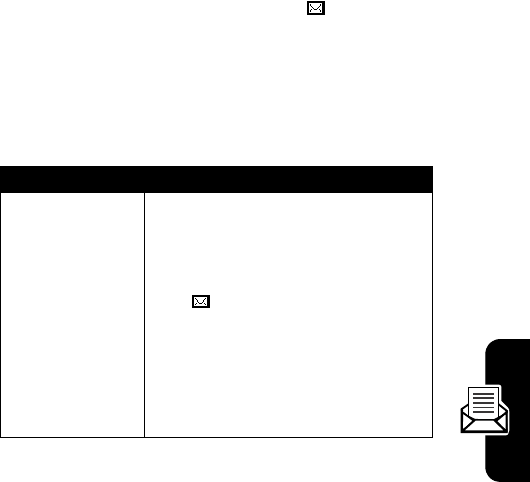
DRAFT
81
Messages and Chat
Tip:
If your email account supports folders, you can view
multiple folders that reflect the folder structure you have
created on your email server. Messages you download
from the server will automatically be placed in the
appropriate folders on your phone.
Using Message Notifications
Your phone makes a sound to alert you when new
messages arrive. The number of unopened messages
displays on the Home screen, depending on your Home
screen settings, and an envelope icon is shown on the
top of the display. You are notified in different ways for the
types of messages you receive.
Note:
SMS messages that are sent to you instantly appear
in
Messaging
>
Text Messages
, and are not synchronized. You
cannot use them to send or receive attachments.
Message Description
Email/SMS Message
When you connect to your email
server or service provider, you are
notified of new email or SMS
messages by the closed envelope
icon shown at the top of the
display, accompanied by an email
or SMS sound alert. You can view
new email or SMS messages in
Messaging
>
Outlook E-Mail
or
Text
Messages
.
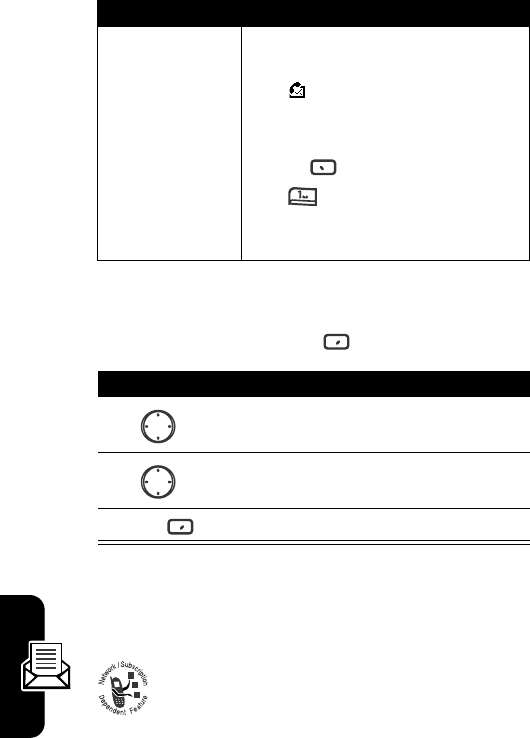
82
Messages and Chat
DRAFT
Modifying a Sound Alert for Notifications
Communicating with MSN
®
Messenger
You can use
MSN
Messenger
on your phone to
send instant messages.
MSN
Messenger
on your
phone provides the same chat environment as
Voicemail Message
You are notified of new voicemail
messages by the new voicemail
icon shown at the top of the
display. To listen to your new
voicemail messages, press
Voicemail
, or press and
hold from the Home screen to
dial your voicemail service
number.
Find the Feature
Start
>
Settings
>
Sounds
Press To
1
scroll to a desired option to
modify
2
left/right select a new sound
3
Done
save the setting
Message Description

DRAFT
83
Messages and Chat
MSN
Messenger
on your desktop computer. With the
features of this environment you can:
•
Send and receive instant messages.
•
View the status of others in your messenger contacts
list, or change your own status (
Available
,
Busy
,
Out To
Lunch
).
•
Invite others to a chat conversation.
•
Block contacts from seeing your status or sending you
messages.
Getting Started with MSN Messenger
To use
MSN
Messenger
, you need a Microsoft.NET
®
Passport
account unless you already have a hotmail account. To set
up a Microsoft.NET Passport account, go to:
http://
www.passport.net
.
Once you have this account, you will
need:
•
To connect to the Internet with a modem or wireless
connection on your phone.
•
To sign in to
MSN
Messenger
using your Microsoft.NET
Passport.
Signing In and Out of MSN
®
Messenger
Find the Feature
Start
>
MSN Messenger
Press To
1
Sign In
prepare to sign in
MSN
Messenger
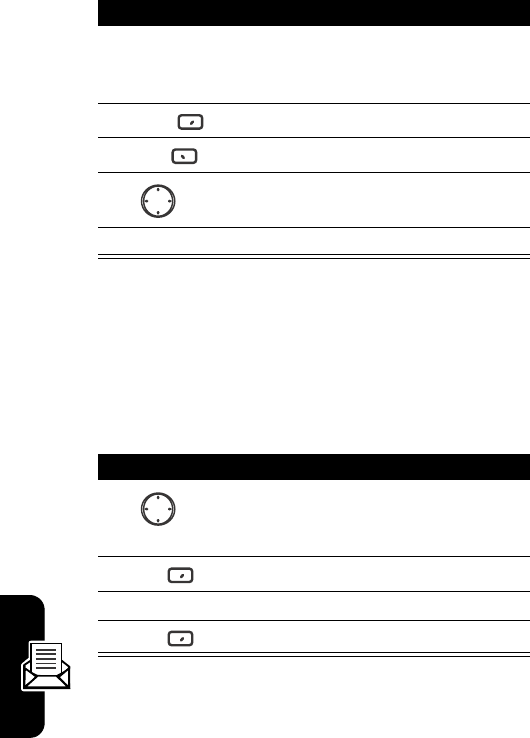
84
Messages and Chat
DRAFT
Note:
If you do not sign out of
MSN
Messenger
, you remain on a
data connection, which may result in additional charges
from your service provider.
Sending an Instant Message
After signing into
MSN
Messenger
:
2
keypad keys enter your sign-in name
(for example, name_123@
hotmail.com) and password
3
Sign In
sign in
MSN
Messenger
4
Menu
open the options menu
5
scroll to
Sign out
6
Action
(
A
)
sign out of
MSN
Messenger
Press To
1
scroll to the person to whom
you want to send an instant
message
2
Send
select the person
3
keypad keys enter your message
4
Send
send your message
Press To
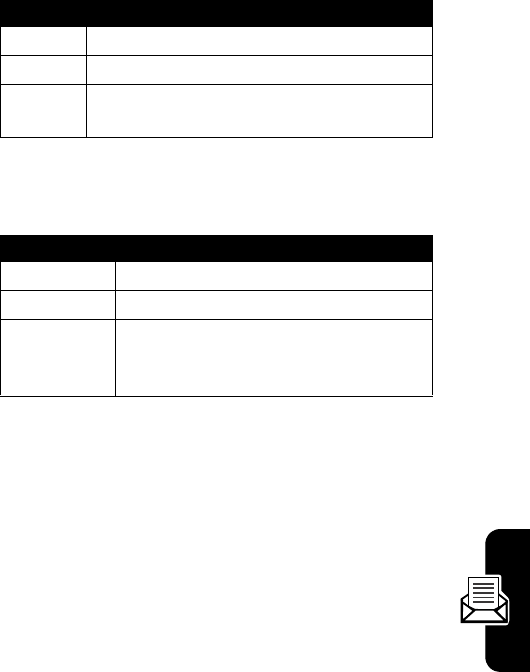
DRAFT
85
Messages and Chat
The menu options when you edit an instant message are
described in the following table.
In the messenger contacts list, there are several menu
options for you to use.
Option Description
My Text
add common text messages
Invite
invite a contact to an ongoing chat
Chats
see who is already chatting, or change
between chats
Option Description
Add Contact
create a contact
Delete Contact
delete the selected contact
Block/Unblock
block/unblock the selected contact
from seeing your status and sending
you messages
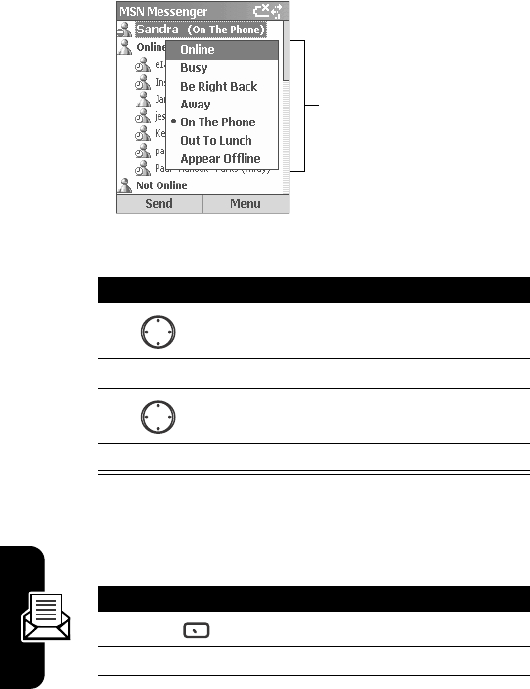
86
Messages and Chat
DRAFT
Changing Your Status
In the messenger contacts list:
Changing Your Displayed Name
After signing into
MSN
Messenger
:
Press To
1
scroll to your name
2
Action
(
A
)
select your name
3
scroll to a desired status
description
4
Action
(
A
)
select the status description
Press To
1
Options
open the options menu
2
Action
(
A
)
select
Passport Account
Highlight your status
and press
Action
(
A
)

DRAFT
87
Messages and Chat
Note:
You must sign into
MSN
Messenger
to change your
display name. When using
MSN
Messenger
, the session will
not time out or end unless one of the following occurs:
•
User ends instant messenger session.
•
User “Accepts” an incoming voice call.
•
An outgoing voice call is placed.
•
The device is turned off or moves out of range.
3
keypad keys enter the name you want
others to see when you send
instant messages
Press To
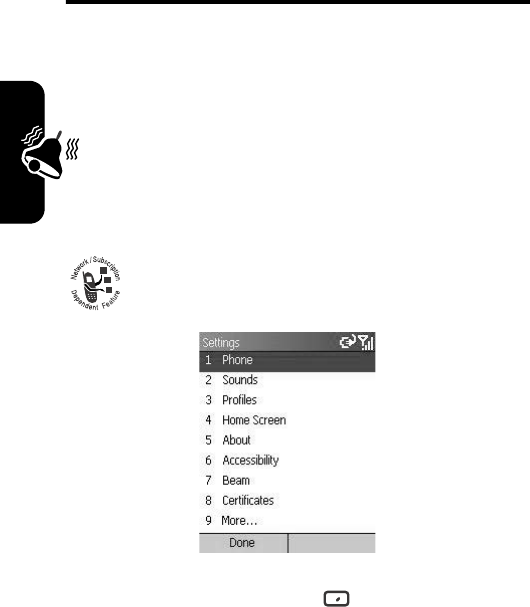
DRAFT
88
Personalizing Your Phone
Personalizing Your
Phone
You can view and change settings to personalize your
phone for the way you work. For example, you can change
the sounds or use your own sounds for ring tones,
notifications and reminders. You can also set up
Call
Forwarding
and
Call Waiting
, as well as download your own
images to customize the Home screen background.
Using Phone Settings
Use
Phone
settings to set options for
Call Forwarding
,
Call Waiting
, and
Caller ID
.
Find the Feature
Start
>
Settings
>
Phone
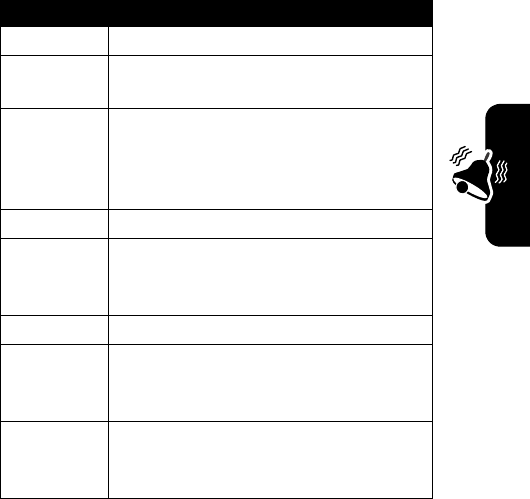
DRAFT
89
Personalizing Your Phone
The following table lists the
Phone
settings and their
functions.
Option Description
Call Barring
block incoming and/or outgoing calls
Call Forwarding
forward all or selected calls to another
number
Call Options
change phone numbers, such as your
voicemail and SMS service center,
answer incoming calls by pressing any
key, use advanced call options
Call Waiting
turn
Call Waiting
on or off
Caller ID
let your identification be known to all
callers, only your contacts, or no
callers
Channels
configure cell broadcast
Fixed Dialing
limit your calling area to one or more
specific phone numbers and/or area
codes
Networks
identify your current network and
change your network selection from
Automatic
to
Manual
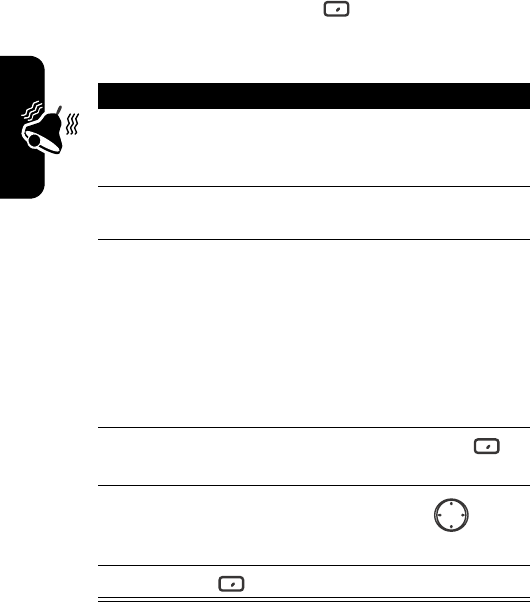
DRAFT
90
Personalizing Your Phone
Using Sound Settings
Sounds
settings are used to customize the sounds for ring
tones, notifications, and reminders.
Using Your Own Sound
Find the Feature
Start
>
Settings
>
Sounds
Action
1
Locate the sound file on your desktop computer
and copy the file. The file format must be .wav
or .mid (MIDI type 0).
2
Connect the phone to your desktop computer via
the USB data cable or infrared.
3
Open
ActiveSync
®
on your desktop computer,
click
Explore
, double-click
My Smartphone
, double-
click
IPSM
, double-click
Application Data
, double-
click
Sounds
, and then paste the sound file into
the
Sounds
folder.
Note:
If a
Sounds
folder does not exist in this
directory, create a new one.
4
On your phone’s Home screen, press
Start
,
select
Settings
, and then select
Sounds
.
5
Select the option to customize, press left/
right to select the sound.
6
Press
Done
to save the setting.
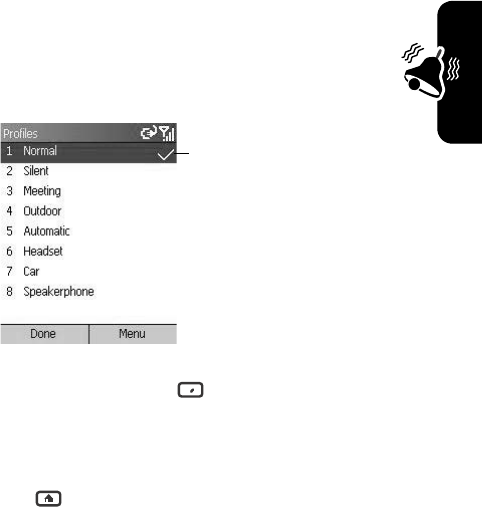
DRAFT
91
Personalizing Your Phone
Using Profiles
Use
Profiles
settings to configure how your phone notifies
you about an incoming call, an approaching appointment,
or an arriving message. You can use
Profiles
to change
notifications quickly based on your situation. For example,
you may want the phone to ring louder if a client is calling,
or you may not want the phone to ring at all, but want to
hear calendar reminders. The default profile used with
your phone is the
Normal
profile. The name of the current
profile displays on the Home screen.
Tip:
You also can either assign
Profiles
settings by selecting
Profile: [Type]
from the Home screen, or select a different
profile using the
Quick List
by pressing
Power
(
p
) or holding
down
Home
from the Home screen.
Note:
When a headset is plugged into the phone, the
Headset
profile is used automatically.
Find the Feature
Start
>
Settings
>
Profiles
Indicates your current
profile
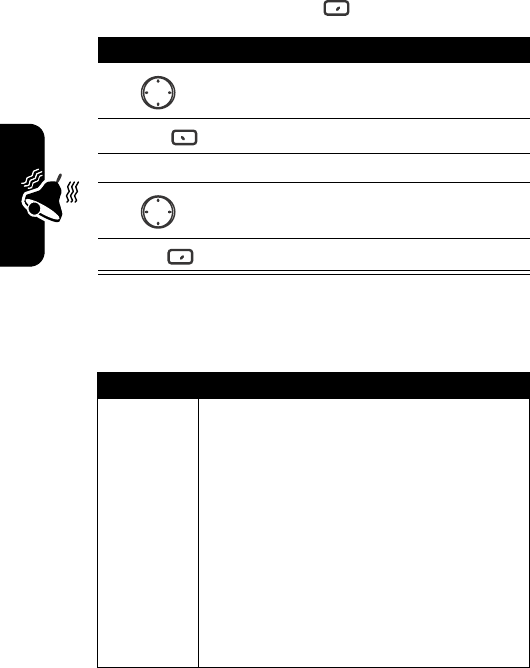
DRAFT
92
Personalizing Your Phone
Modifying a Profile
Observe the following from your phone when in the
following modes:
Find the Feature
Start
>
Settings
>
Profiles
Press To
1
scroll to a desired profile
2
Menu
open the options menu
3
Action
(
A
)
select
Edit
4
scroll to a desired option to
modify
5
Done
save the settings
Profile Description
Headset
This can only be activated when a
headset is connected to your device.
The
Headset
profile is deactivated when
you remove the headset from your
device. You cannot select or unselect
Headset
from the
Profile
item on the Home
screen. It has been placed in the
Profiles
menu in order to allow you to confirm
(via a check mark) that it has been
automatically selected upon connecting
to the headset.
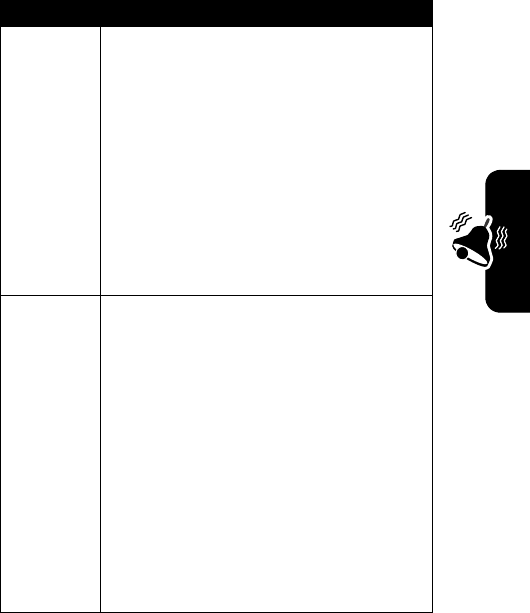
DRAFT
93
Personalizing Your Phone
Car
This can only be activated when a car
kit specifically designed for your phone
is connected to your device. The
Car
profile is deactivated when you remove
the car kit from your device. You cannot
select or unselect
Car
from the
Profile
item on the Home screen. It has been
placed in the
Profiles
menu in order to
allow you to confirm (via a check mark)
that it has been automatically selected
upon connecting to a car kit.
Speakerphone
This is automatically selected by the
device while you are in a call and after
you have activated the speakerphone.
The
Speakerphone
profile is deactivated
when you turn off speakerphone during
or just as you are ending a call. You
cannot select or unselect
Speakerphone
from the
Profile
item on the Home
screen. It has been placed in the
Profiles
menu in order to allow you to confirm
(via a check mark) that it has been
automatically selected upon turning on
the speakerphone.
Profile Description
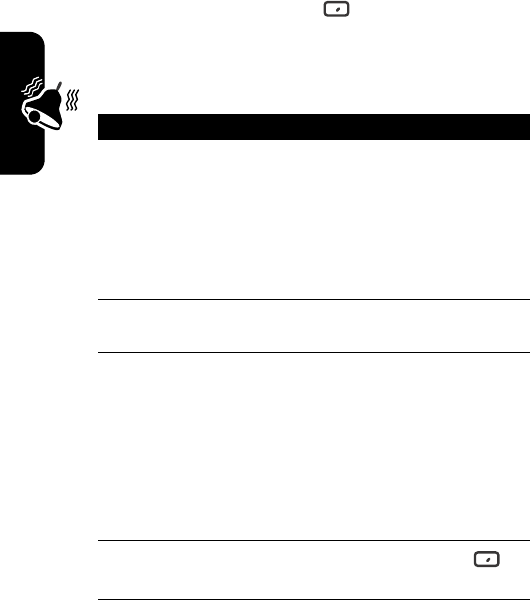
DRAFT
94
Personalizing Your Phone
Changing the Home Screen
Use
Home Screen
settings to change the Home screen layout,
the color scheme, the background image, and the time
delay in the idle display.
Customizing the Home Screen with Your
Own Image
Find the Feature
Start
>
Settings
>
Home Screen
Action
1
Locate your image file on your desktop computer
and copy the image file. The file format must
be .gif, .jpg, or .bmp.
Tip:
For best results, use images with a 176 x
200 screen resolution to fit on your phone’s
Home screen.
2
Connect the phone to your desktop computer via
the USB data cable or infrared.
3
Open
ActiveSync
®
on your desktop computer,
click
Explore
, double-click
My Smartphone
, double-
click
IPSM
, double-click
Application Data
, double-
click
Home
, and then paste the image file into the
Home
folder.
Note:
If a
Home
folder does not exist in this
directory, create a new one.
4
On your phone’s
Home screen, press
Start
,
select
Settings
, and then select
Home Screen
.
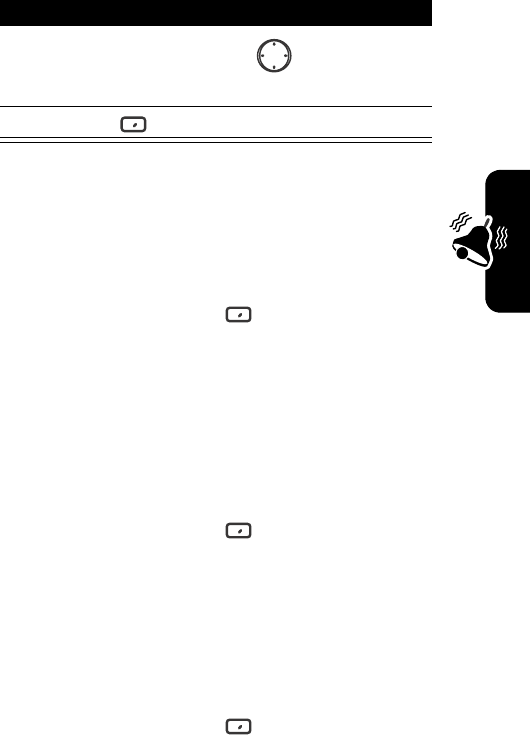
DRAFT
95
Personalizing Your Phone
Changing Regional Settings
Use
Regional Settings
to change the language, date, and
time style of the phone, as well as number and
currency formatting options.
Setting Font Size, Time-Out,
and Alert Volume
Use
Accessibility
to configure the system font size, Multi-Tap/
confirmation time-out, and in-call alert volume.
Using Advanced Phone
Settings
Use
Phone Settings
to customize flip answer on/off control,
display style, and screen contrast.
5
Under
Background image
, press left/right to
select your image.
6
Press
Done
to save the setting.
Find the Feature
Start
>
Settings
>
More
>
Regional Settings
Find the Feature
Start
>
Settings
>
Accessibility
Find the Feature
Start
>
Settings
>
More
>
More
>
Phone Settings
Action
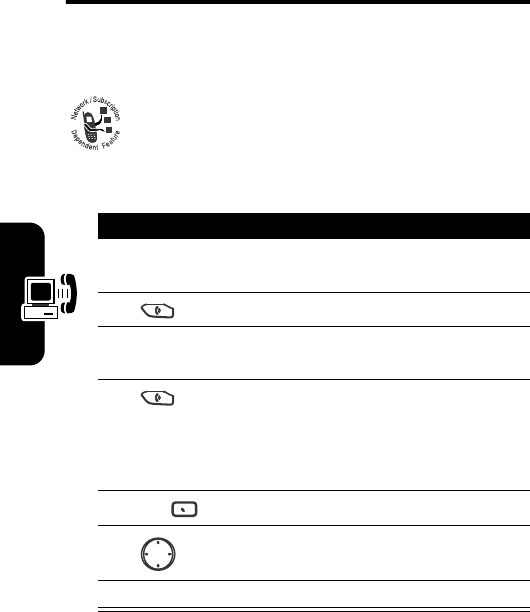
96
Getting More Out of Your Phone
DRAFT
Getting More Out of
Your Phone
Making a Conference Call
You can join together all existing calls to make a
conference call, if you have subscribed to this
service.
On the Home screen:
Press To
1
keypad keys enter a phone number for the
1st call
2
call the number
3
keypad keys enter a phone number for the
2nd call
4
call the 2nd number
Note:
The 1st call is
automatically put on hold
when the 2nd call is active.
5
Menu
open the options menu
6
scroll to
Conference
7
Action
(
A
)
make a conference call
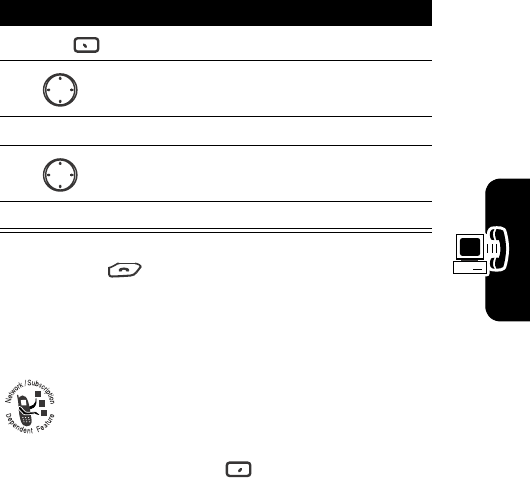
97
Getting More Out of Your Phone
DRAFT
Making a Call from a Conference Active
You can break 1 call out of a conference and make this call
active while the rest of the conference is on hold.
In a conference call:
Tip:
Press
End
to end an active call when multiple
parties are connected.
Forwarding Calls
You can forward all or selected calls to another
number.
Press To
1
Menu
open the options menu
2
scroll to
Private
3
Action
(
A
)
select
Private
4
scroll to a desired call
5
Action
(
A
)
make the call active
Find the Feature
Start
>
Settings
>
Phone
>
Call
Forwarding
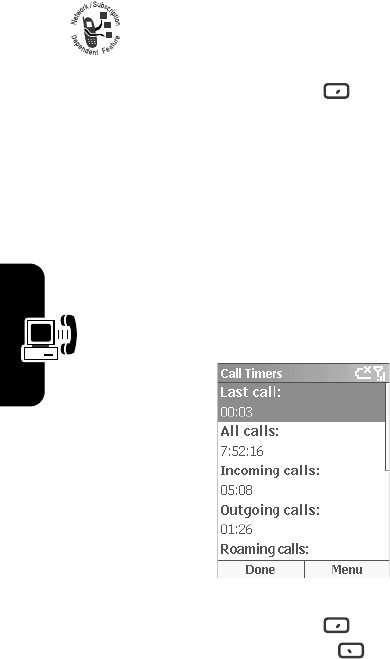
98
Getting More Out of Your Phone
DRAFT
Barring Calls
You can block incoming and/or outgoing calls.
Monitoring Phone Use
Call Timers
contains the length of your last call, the total
number of calls made and received, calls by type (
Incoming
,
Outgoing
,
Roaming
, and
Data
), and a lifetime counter. You can
use
Call Timers
to keep track of your calling patterns, to help
you choose a calling plan or estimate your monthly
billing.
Find the Feature
Start
>
Settings
>
Phone
>
Call
Barring
Find the Feature
Start
>
Call History
>
Menu
>
View Timers
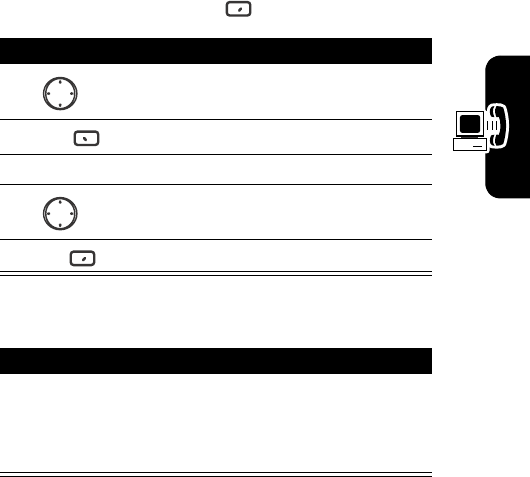
99
Getting More Out of Your Phone
DRAFT
Opening Applications with
Speed Dial
You can quickly launch applications by assigning speed
dial numbers. Press and hold 1 or 2 keys from the Home
screen to make a speed dial command. Choose speed dial
entries from 2-99. The speed dial entry 1 is often reserved
to set up or dial your voicemail after initial setup.
To assign an application a speed dial number:
To quickly open an application from the Home screen:
Find the Feature
Start
Press To
1
scroll to a desired application
2
Menu
open the options menu
3
Action
(
A
)select
Add Speed Dial
4
left/right select a speed dial entry
under
Keypad assignment
5
Done
save the setting
Action
Press and hold the keypad number that you have
assigned as a speed dial command. If the keypad
assignment has 2 digits, press the 1st digit, then
press and hold the 2nd digit.
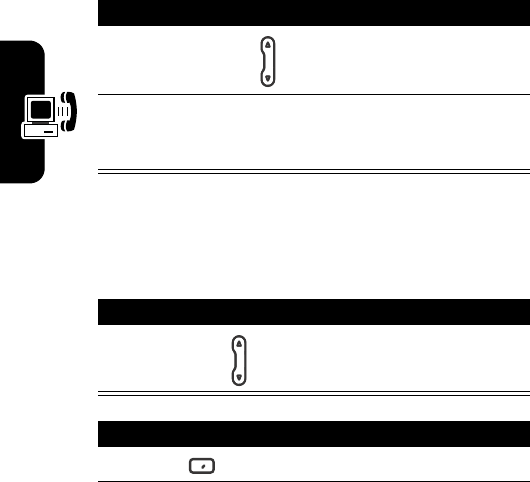
100
Getting More Out of Your Phone
DRAFT
Using Voice Activation
You can open an application or contact card by speaking a
word.
Note:
The voice recognition application works only via the
phone directly or a wired headset attached to the phone,
but not with a Bluetooth headset.
Opening an Application by Voice
On the Home screen:
Customizing the List of Applications That Can Be
Opened by Voice
On the Home screen:
Action
1
Press and hold up to open
Speech Recognition
.
2
Say the name of the application you want to
open preceded by
Open
(for example, saying
“Open Calendar”).
Action
Press and hold up to open
Speech Recognition
.
Press To
1
Settings
open the settings menu
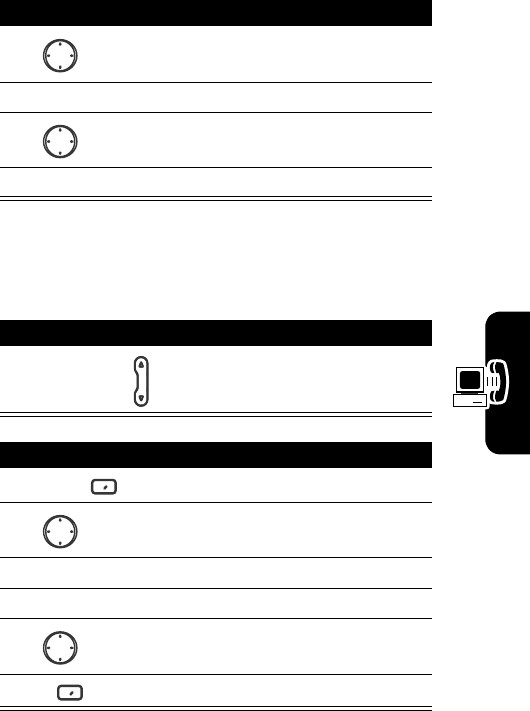
101
Getting More Out of Your Phone
DRAFT
Adjusting the Command Sensitivity Setting
If the phone seldom recognizes your commands, follow
the steps from the Home screen:
2
scroll to
Application Launcher
3
Action
(
A
)select
Application Launcher
4
scroll to an application you
want to open by voice
5
Action
(
A
) check the application
Action
Press and hold up to open
Speech Recognition
.
Press To
1
Settings
open the settings menu
2
scroll to
Sensitivity
3
Action
(
A
)select
Sensitivity
4
Action
(
A
)select
Commands
5
down adjust the
Commands
setting
toward
Reject Less
6
OK
save the setting
Press To
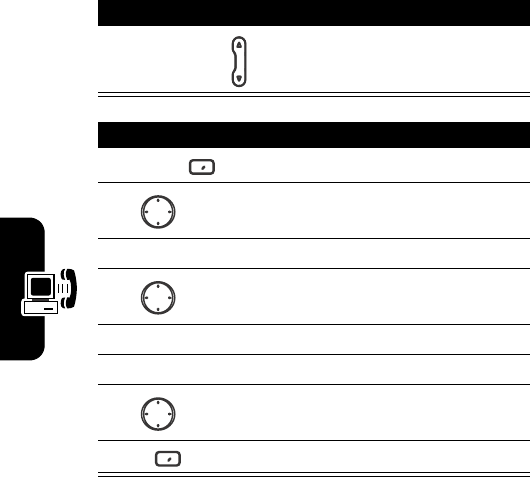
102
Getting More Out of Your Phone
DRAFT
Adjusting the Speed Setting
If you want the phone to initiate your commands faster,
follow the steps from the Home screen:
Action
Press and hold up to open
Speech Recognition
.
Press To
1
Settings
open the settings menu
2
scroll to
Sound
3
Action
(
A
)select
Sound
4
scroll to
Name Settings
5
Action
(
A
)select
Name Settings
6
Action
(
A
)select
Speed
7
up adjust the
Speed
setting toward
Faster
8
OK
save the setting
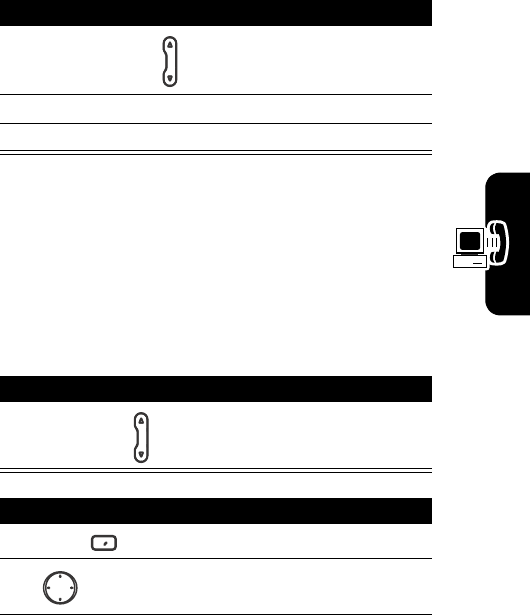
103
Getting More Out of Your Phone
DRAFT
Viewing Your Contact Card by Voice
Name Lookup
lets you view any contact card saved in
Contacts
by voice.
On the Home screen:
Changing How Phone Book Works with Your
Contact Card
By default,
Name Lookup
automatically retrieves contact
information for any name in your contacts list by saying
that name. If you want to review and confirm names before
retrieving contact information, you must enable
Name Lookup
Choice Lists
. Follow the steps from the Home screen:
Action
1
Press and hold up to open
Speech Recognition
.
2
Say
Name Lookup
.
3
Say the name exactly saved in your contacts list.
Action
Press and hold up to open
Speech Recognition
.
Press To
1
Settings
open the settings menu
2
scroll to
Choice Lists
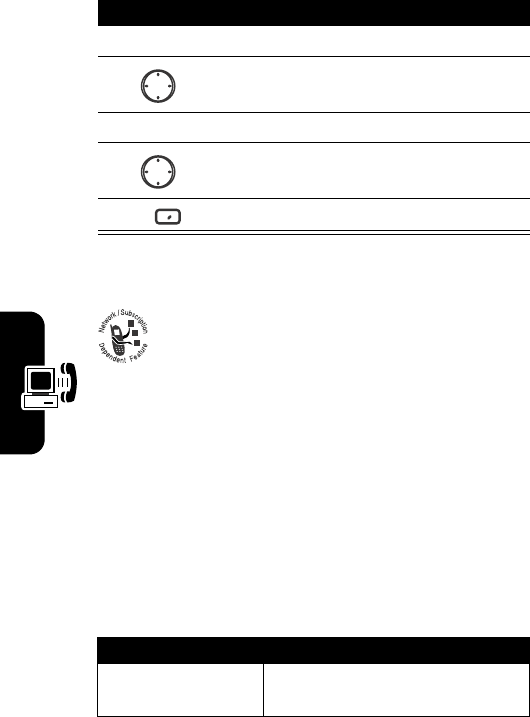
104
Getting More Out of Your Phone
DRAFT
Making Data Calls
Use
Data Connections
settings to set up General
Packet Radio Service (GPRS), dial-up, Virtual
Private Network (VPN), and proxy
connections so you can connect to the Internet or your
corporate network. With a data connection, you can
browse the Web, download email, chat using
MSN® Messenger
or
IM Chat
, or synchronize wirelessly with the server.
Note:
Your phone has already been configured to allow you
to browse and chat. Contact your IT manager for
information on mobile Internet plans, configuring email or
wireless synchronizing with the server.
There are 4 main data connections:
3
Action
(
A
)select
Choice Lists
4
scroll to
Name Lookup
5
Action
(
A
)select
Name Lookup
6
scroll to
Always On
7
OK
save the setting
Data connection Description
Internet connection
connect to your Internet service
provider
Press To
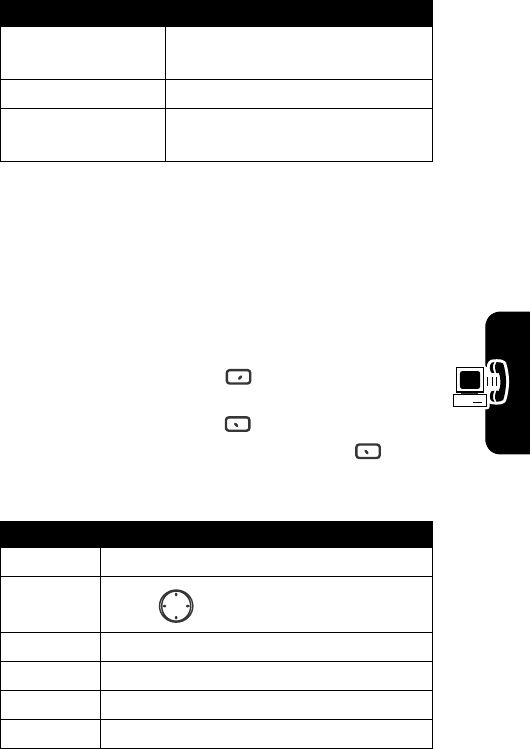
105
Getting More Out of Your Phone
DRAFT
Using Dial-Up Connection
You need to set up a dial-up connection to connect directly
to the Internet or your corporate network.
Creating a Dial-Up Connection to the Internet
On the Home screen:
Fill in the blanks with the appropriate information:
Work connection
connect to your work place
network
WAP connection
use WAP connection settings
Secure WAP connection
use secure WAP (WAPS)
connection settings
Find the Feature
Start
>
Settings
>
More
>
Data Connections
>
Menu
>
Edit Connections
>
Dial-up Connections
>
Menu
>
Add
Option Description
Description
enter a name for the connection
Connects to
press left/right to select
The Internet
Phone number
enter in your phone number
User name
enter in your user name
Password
enter in your password
Domain
enter in your domain name
Data connection Description
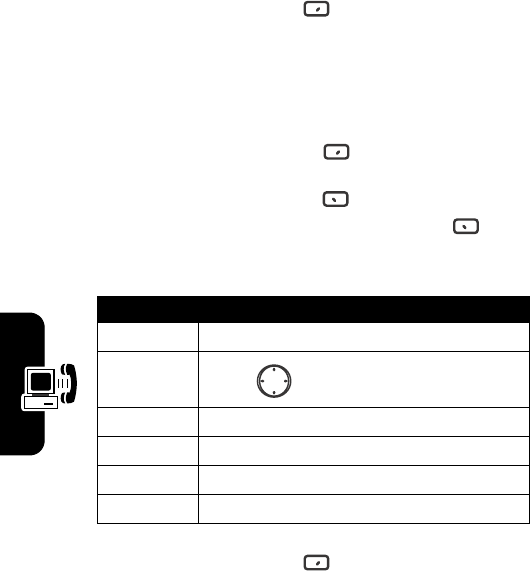
106
Getting More Out of Your Phone
DRAFT
Note:
Remember to press
Done
when you are ready.
Creating a Dial-Up Connection to Your Corporate
Network
On the Home screen:
Fill in the blanks with the appropriate information:
Note:
Remember to press
Done
when you are ready.
Find the Feature
Start
>
Settings
>
More
>
Data Connections
>
Menu
>
Edit Connections
>
Dial-up Connections
>
Menu
>
Add
Option Description
Description
enter a name for the connection
Connects to
press left/right to select
Work
Phone number
enter in your phone number
User name
enter in your user name
Password
enter in your password
Domain
enter in your domain name
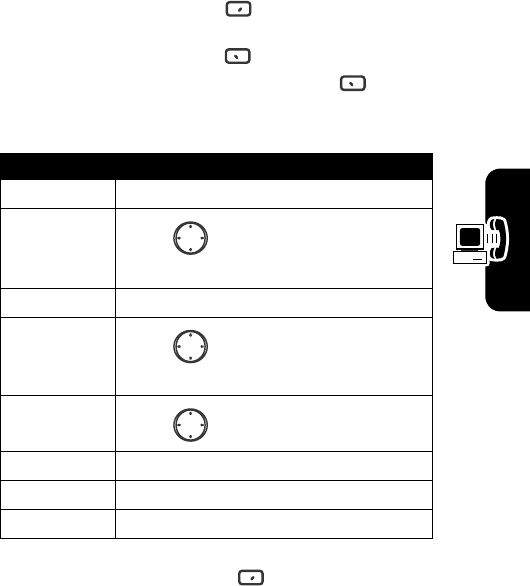
107
Getting More Out of Your Phone
DRAFT
Creating VPN Connection
A VPN connection accesses your corporate network by
using an existing Internet connection.
On the Home screen:
Fill in the blanks with the appropriate information:
Note:
Remember to press
Done
when you are ready.
Find the Feature
Start
>
Settings
>
More
>
Data Connections
>
Menu
>
Edit Connections
>
VPN Connections
>
Menu
>
Add
Option Description
Description
enter a name for the connection
VPN type
press left/right to select a VPN
type
Server
enter in your server name
Connects from
press left/right to select
The
Internet
Connects to
press left/right to select
Work
User name
enter in your user name
Password
enter in your password
Domain
enter in your domain name
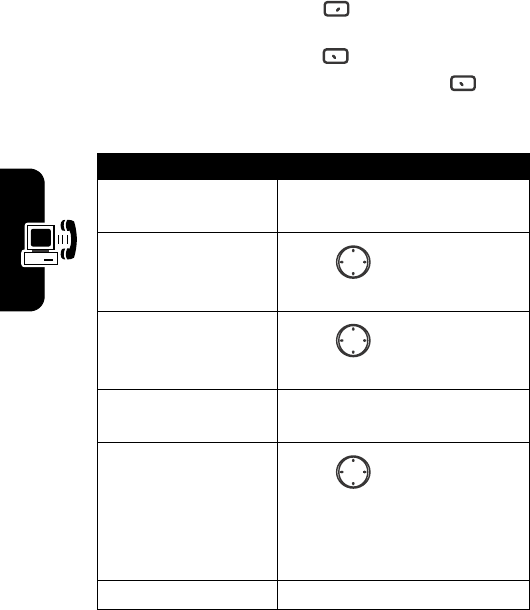
108
Getting More Out of Your Phone
DRAFT
Creating Proxy Connection
A proxy connection accesses the Internet using an existing
connection to your corporate network.
On the Home screen:
Fill in the blanks with the appropriate information:
Find the Feature
Start
>
Settings
>
More
>
Data Connections
>
Menu
>
Edit Connections
>
Proxy Connections
>
Menu
>
Add
Option Description
Description
enter a name for the
connection
Connects from
press left/right to select
Work
Connects to
press left/right to select
The Internet
Proxy (name:port)
enter in your proxy server
name and port
Type
press left/right to select
a proxy server type
Tip:
Select
Socks4
to use
MSN®
Messenger
or
IM Chat
.
User name
enter in your user name
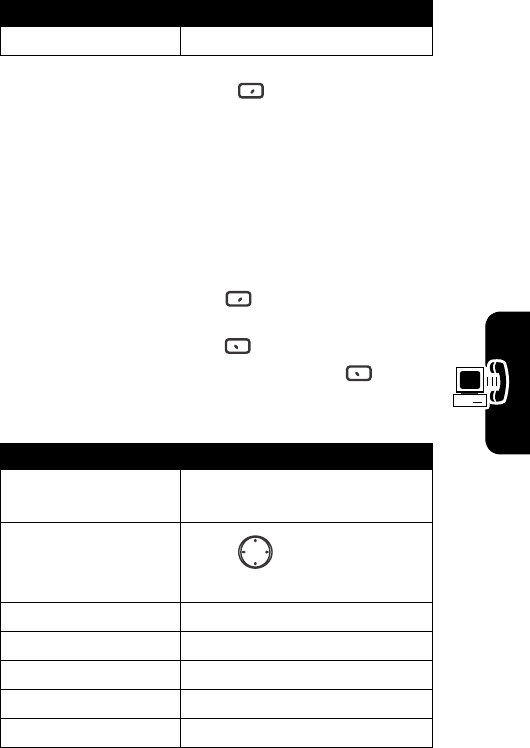
109
Getting More Out of Your Phone
DRAFT
Note:
Remember to press
Done
when you are ready.
Creating GPRS Connection
A GPRS connection accesses the Internet, MMS network,
(secure) WAP network, or corporate network by using an
access point your service provider provides.
On the Home screen:
Fill in the blanks with the appropriate information:
Password
enter in your password
Find the Feature
Start
>
Settings
>
More
>
Data Connections
>
Menu
>
Edit Connections
>
GPRS Connections
>
Menu
>
Add
Option Description
Description
enter a name for the
connection
Connects to
press left/right to select
a network connection
Access point
enter in your access point
User name
enter in your user name
Password
enter in your password
Primary DNS
enter in your primary DNS
Secondary DNS
enter in your secondary DNS
Option Description
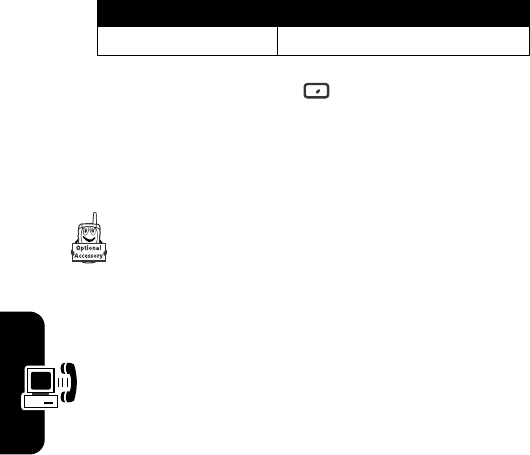
110
Getting More Out of Your Phone
DRAFT
Note:
Remember to press
Done
when you are ready.
Synchronizing Information
among Devices
You can use Microsoft
®
ActiveSync
to synchronize
information on your desktop computer and/or a
Microsoft Exchange Server with the information on
your phone.
ActiveSync®
compares your phone’s information
with the information on the desktop computer and/or the
server, and then updates all locations with the most
recent information. Connecting to a company server
requires assistance from an Information Technology
(IT) professional. With
ActiveSync
, you can:
•
Keep your Outlook
®
information up-to-date by
synchronizing your phone with your desktop
computer.
•
Synchronize
Inbox
,
Calendar
, and
Contacts
with a server so
that you have the latest information, even when your
desktop computer is turned off.
•
Copy (rather than synchronize) files between your
phone and your desktop computer.
•
Control when synchronization occurs by selecting a
synchronization schedule.
•
Select which information types are synchronized and
control how much information is synchronized. For
IP address
enter in your IP address
Option Description

111
Getting More Out of Your Phone
DRAFT
example, you can choose how many weeks of past
appointments to synchronize.
Tip:
Using
ActiveSync
, you can synchronize information
directly with a Microsoft Exchange Server if your computer
is running
Microsoft
Mobile Information Server
2002 or later.
For more information about
ActiveSync
, see
ActiveSync
Help
on your desktop computer.
Installing ActiveSync on Your PC
ActiveSync
is already installed on your phone. Install
ActiveSync
(3.7.1 or later) using the companion CD included in your
box or download from the Microsoft
®
website (
http://
www.microsoft.com
) by entering the word ActiveSync in the
search dialogue box.
Creating a Partnership
After the installation is complete, the
New Partnership
Wizard
helps you set up a partnership between your phone
and your desktop computer and/or a server so that you
can start synchronizing information and customizing your
synchronization settings. Your first synchronization
process automatically begins when you finish using the
wizard. After the first synchronization, your Outlook
information appears on your phone.
Note:
If you have a firewall on your desktop, the wizard
may cause difficulties establishing your partnership with
your phone. To prevent synchronization problems, select
Synchronize with Microsoft
Mobile Information Server
and/or
this desktop computer in the
New Partnership Wizard
only if
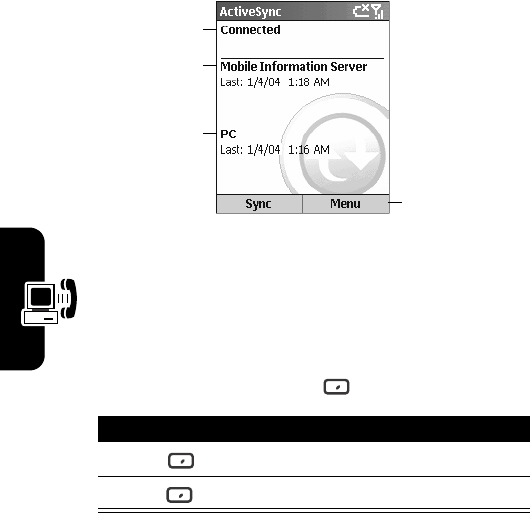
112
Getting More Out of Your Phone
DRAFT
your computer is running
Microsoft
Mobile Information Server
2002 or later and you know the server name.
Starting and Stopping Synchronization
Connect your phone and desktop computer using the
infrared port on your phone or using the USB data
cable before you begin to synchronize information.
Setting Up Server ActiveSync
Before you can synchronize information with a server, you
may need to request server configuration information,
such as your user name, password, and the name of the
Microsoft
®
Mobile Information Server, either from your
Find the Feature
Start
>
ActiveSync
Press To
1
Sync
start synchronization
2
Stop
stop synchronization
Connection
status
Server
synchronization
Desktop
synchronization
Select to
synchronize via
IR or change
synchronization
settings
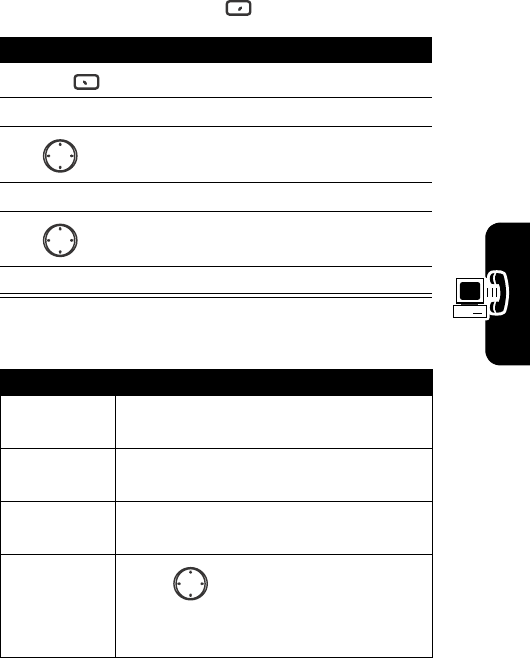
113
Getting More Out of Your Phone
DRAFT
service provider or network administrator. This
configuration information may have already been set up on
your phone.
Fill in the blanks with the appropriate information:
Find the Feature
Start
>
ActiveSync
Press To
1
Menu
open the options menu
2
Action
(
A
)
select
Options
3
scroll to
Server Settings
4
Action
(
A
)
select
Server Settings
5
scroll to
Connection
6
Action
(
A
)
select
Connection
Option Description
User name
enter in your Microsoft Exchange user
name
Password
enter in your Microsoft Exchange
password
Domain
enter in your Microsoft Exchange
Server domain name (if required)
Save password
press left/right to check this
feature so that you need not enter it
repeatedly
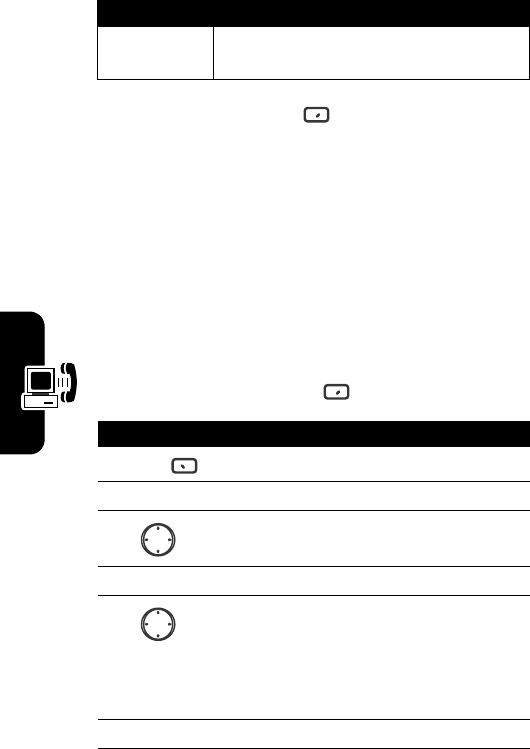
114
Getting More Out of Your Phone
DRAFT
Note:
Remember to press
Done
when you are ready.
Stopping Synchronizing an Information
Type with a Server
You can stop your phone synchronizing an information
type with a server. However, to change to synchronizing
with your desktop computer instead, you need to change
the synchronization settings on the desktop computer. For
more information about synchronization, see
ActiveSync
Help
on the desktop computer.
Server Name
enter in your Microsoft Mobile
Information Server name
Find the Feature
Start
>
ActiveSync
Press To
1
Menu
open the options menu
2
Action
(
A
)
select
Options
3
scroll to
Server Settings
4
Action
(
A
)
select
Server Settings
5
scroll to the information type
that you no longer want to
synchronize with a server,
such as
Calendar
,
Contacts
, or
Inbox
6
Action
(
A
)
select the information type
Option Description
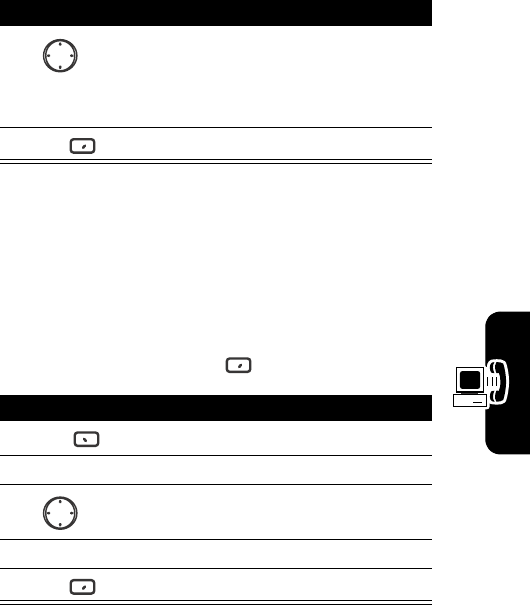
115
Getting More Out of Your Phone
DRAFT
Synchronizing Remotely
You can synchronize remotely with your computer or
server after setting up server
ActiveSync
.
Synchronizing Remotely with a Desktop
Computer
7
left/right clear the check box next to
the information type that you
no longer want to
synchronize with a server
8
Done
save the setting
Find the Feature
Start
>
ActiveSync
Press To
1
Menu
open the options menu
2
Action
(
A
)
select
Options
3
scroll to
PC Settings
4
Action
(
A
)
select
PC Settings
5
Done
save the settings
Press To
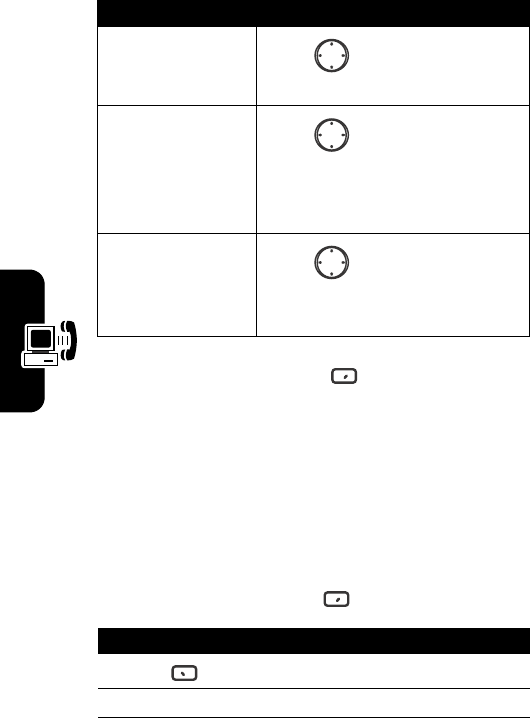
116
Getting More Out of Your Phone
DRAFT
Fill in the blanks with the appropriate information:
Note:
Remember to press
Done
when you are ready.
Tip:
To synchronize remotely with a desktop computer, first
turn on the computer.
Synchronizing Remotely with a Server
You can also set up a connection to synchronize remotely
with a server when you first create a partnership between
your phone and desktop computer.
Option Description
Use
press left/right to select the
appropriate computer name
Use mobile schedule to
sync with this PC
press left/right to check
this feature if you want to use a
synchronization schedule to
sync with your PC
Sync with this PC during
manual sync
press left/right to check
this feaute if you want to sync
with your PC manually
Find the Feature
Start
>
ActiveSync
Press To
1
Menu
open the options menu
2
Action
(
A
)
select
Options
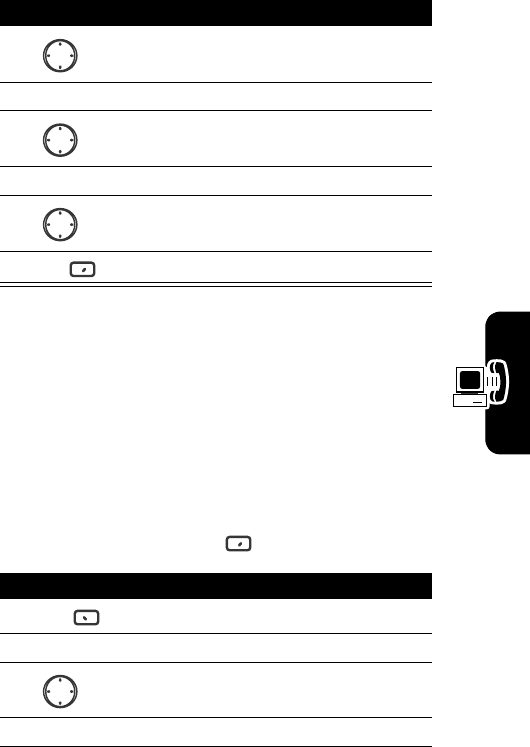
117
Getting More Out of Your Phone
DRAFT
Creating a Server Synchronization
Schedule
You can create a server synchronization schedule so
that your information is automatically synchronized with
the server at specified time intervals.
Creating a Schedule to Sync with a Server When
Your Phone Is Connected to a Desktop Computer
3
scroll to
Server Settings
4
Action
(
A
)
select
Server Settings
5
scroll to the information type
to sync with the server
6
Action
(
A
)
select the information type
7
left/right check the check box next to
the information type
8
Done
save the settings
Find the Feature
Start
>
ActiveSync
Press To
1
Menu
open the options menu
2
Action
(
A
)
select
Options
3
scroll to
Server Settings
4
Action
(
A
)
select
Server Settings
Press To
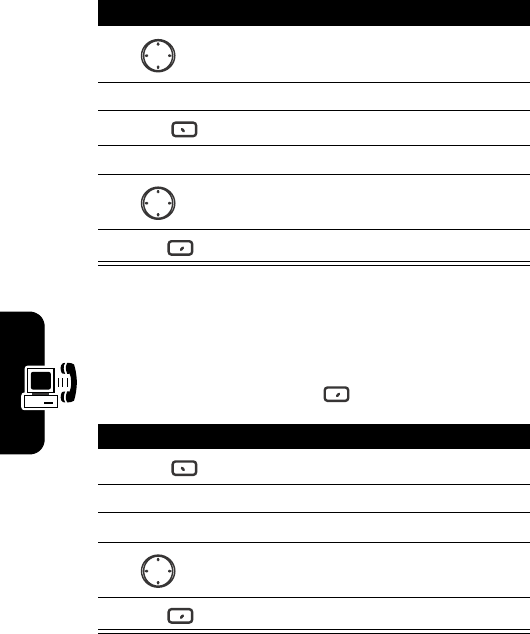
118
Getting More Out of Your Phone
DRAFT
Creating a Schedule to Sync with a Server When
Your Phone Is Not Connected to a Desktop
Computer (Synchronizing Wirelessly)
5
scroll to
Connection
6
Action
(
A
)
select
Connection
7
Menu
open the options menu
8
Action
(
A
)
select
Rules
9
left/right select a time interval to sync
with your server
10
Done
save the setting
Find the Feature
Start
>
ActiveSync
Press To
1
Menu
open the options menu
2
Action
(
A
)
select
Options
3
Action
(
A
)
select
Mobile Schedule
4
left/right select a length of time
5
Done
save the settings
Press To
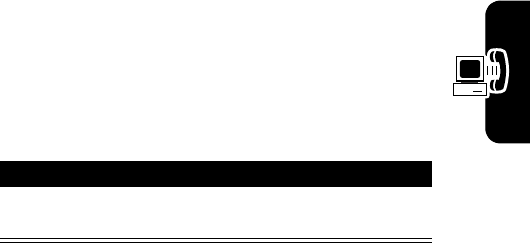
119
Getting More Out of Your Phone
DRAFT
Synchronizing Using an Infrared
Connection
You can use an infrared connection to quickly create a
direct connection between your phone and another mobile
device or desktop computer. This method is ideal for
changing between multiple devices, because there are no
cables or adapters to change. For more information about
synchronizing using an infrared connection, see
ActiveSync
Help
on your desktop computer.
Note:
Align your phone to your personal computer or
mobile device when using an infrared connection to
synchronize information.
Viewing the Information on ActiveSync
Errors
Whenever
ActiveSync
cannot successfully synchronize
your information, an error displays on your phone.
Note:
Some types of errors can interfere with automatic
synchronization. If you suspect that a scheduled automatic
synchronization has not occurred, you should attempt to
manually synchronize your information. Successfully
completing manual synchronization resets automatic
synchronization.
Press To
Action
(
A
)
display more information
about the error that occurred
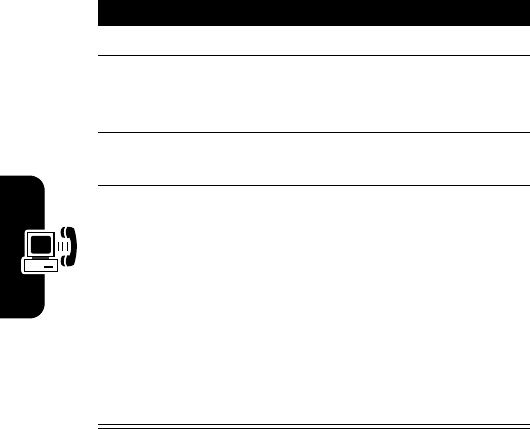
120
Getting More Out of Your Phone
DRAFT
Exchanging Files between Your Phone and
Desktop PC
With
ActiveSync
, you can exchange files between your phone
and desktop PC.
Beaming Information
You can use your phone’s infrared port to send and
receive (beam) calendar appointments and contact cards
between your devices and synchronize information with
another mobile device or desktop computer that has an
infrared port.
Action
1
Connect your phone to your desktop computer.
2
On your computer, open
ActiveSync
and click
Explore
.
Windows
Explorer
opens the
Mobile Device
window for your phone.
3
In
Windows
Explorer
, browse to the file that you
want to copy to your phone or desktop computer.
4
To copy the file to your phone, right-click the file
and select
Copy
. Place the cursor in the desired
folder for your phone, right-click, and select
Paste
.
or
To copy the file to your desktop computer, right-
click the file and select
Copy
. Place the cursor in
the desired folder for your desktop computer,
right-click, and select
Paste
.
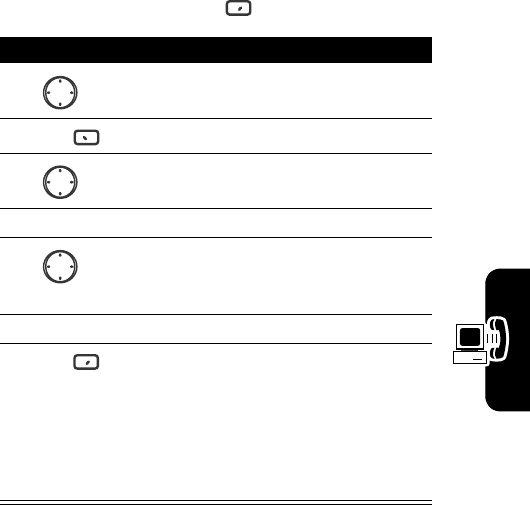
121
Getting More Out of Your Phone
DRAFT
Beaming a Contact Card
Status information then displays the name of the device
your phone is beaming to, and whether the beaming
process is pending, done, or failed.
Find the Feature
Start
>
Contacts
Press To
1
scroll to a desired contact to
beam
2
Menu
open the options menu
3
scroll to
Beam Contact
4
Action
(
A
)
select
Beam Contact
5
scroll to a desired IR device
your phone searches in it’s
range
6
Action
(
A
)
select the device
7
Beam
beam the contact
Note:
To beam the contact
over IR, align the infrared
ports so that they are
unobstructed and within close
range of each other.
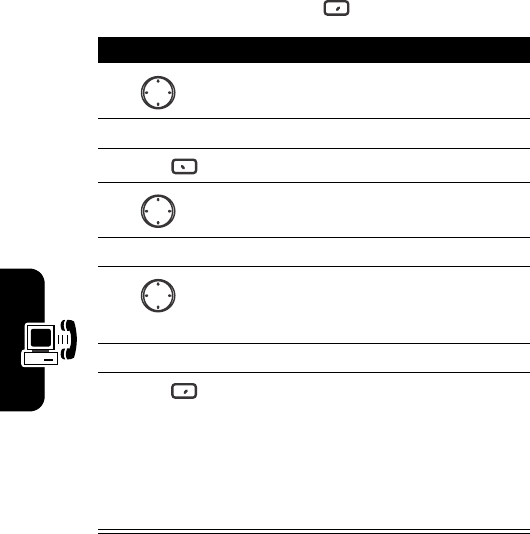
122
Getting More Out of Your Phone
DRAFT
Beaming an Appointment
Status information displays the name of the device your
phone is beaming to, and whether the beaming process is
pending, done, or failed.
Find the Feature
Start
>
Calendar
Press To
1
scroll to a desired
appointment to beam
2
Action
(
A
)
open the appointment
3
Menu
open the options menu
4
scroll to
Beam Appointment
5
Action
(
A
)
select
Beam Appointment
6
scroll to a desired IR device
your phone searches in it’s
range
7
Action
(
A
)
select the device
8
Beam
beam the appointment
Note:
To beam the
appointment over IR, align
the infrared ports so that they
are unobstructed and within
close range of each other.
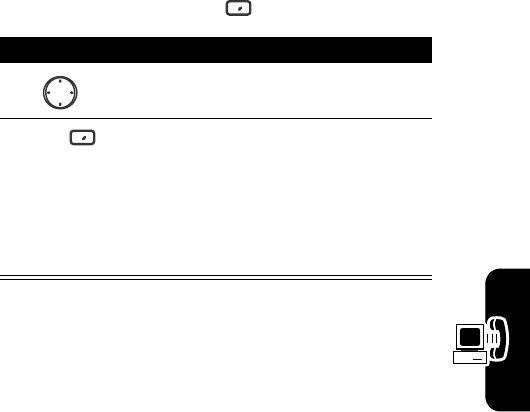
123
Getting More Out of Your Phone
DRAFT
Receiving Beamed Information
Note:
Your phone can receive beamed files of any type,
but some files must need to be copied to your desktop
computer for viewing.
Using a Bluetooth® Connection
You can use a Bluetooth connection to quickly create a
direct connection between your phone and another
Bluetooth-enabled mobile device or desktop computer.
This method is ideal for changing between multiple
devices, because there are no cables or adapters to
change.
Find the Feature
Start
>
Settings
>
Beam
Press To
1
left/right check
Receive incoming beams
2
Done
receive beamed information
Note:
To receive beamed
information over IR, align the
infrared ports so that they are
unobstructed and within close
range of each other.
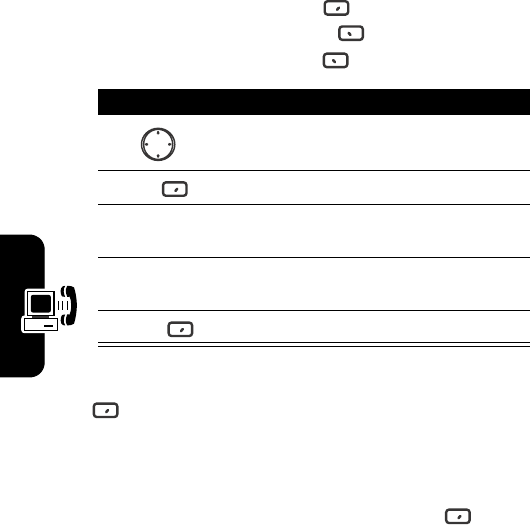
124
Getting More Out of Your Phone
DRAFT
Creating a Partnership from Your Phone
with a Bluetooth Device
Tip:
You can stop a search if a device is found by pressing
Add
.
Note:
When your phone is creating a bond with a device
that has headset or handsfree capabilities, you are notified
through the dialog boxes to set up that device as your
Bluetooth headset or handsfree by pressing
Yes
.
When you are on a call using your Bluetooth headset, you
can transfer audio to your phone’s earpiece by using the
menu options. If you want to transfer audio again to the
headset, push the headset hardware button.
Find the Feature
Start
>
Settings
>
Bluetooth
>
Menu
>
Devices
>
Menu
>
New
Press To
1
scroll to the Bluetooth device
you want to pair with
2
Add
select the device
3
keypad keys enter a PIN on your phone to
create the partnership
4
keyboard keys enter the same PIN on the
Bluetooth device
5
Done
save the setting
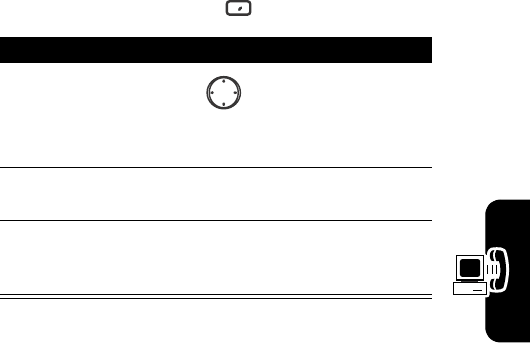
125
Getting More Out of Your Phone
DRAFT
Accepting a Partnership from Your Phone
On a Bluetooth device, you can configure a partnership
with your phone.
The partnership is created. Your phone can now be used
as a data modem. The phone automatically becomes a
data modem over Bluetooth if a paired device attempts to
connect to it.
Find the Feature
Start
>
Settings
>
Bluetooth
Action
1
Under
Bluetooth
, press left/right to select
Discoverable
. The Bluetooth radio turns on and
makes your phone discoverable for 3 minutes.
2
On the Bluetooth device, select your phone and
attempt to pair with it.
3
Enter the same PIN both on your Bluetooth
device and on your phone to create the
partnership.
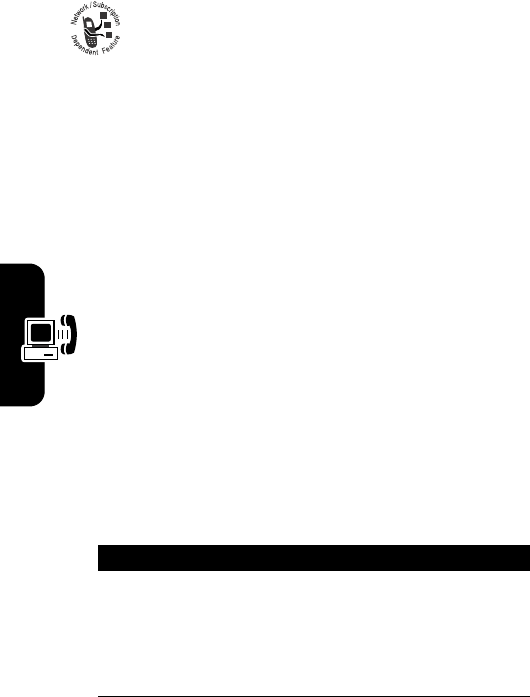
126
Getting More Out of Your Phone
DRAFT
Using Your Phone as a Modem
Using
Modem Link
, you can use your phone as an
external modem for another device or computer
by using an infrared or USB connection.
Note:
When you connect your phone to your personal
computer using a USB data cable, the screens shown and
the step-by-step instructions are specific to Windows 2000
users. The screens may vary slightly by the Windows
version. If you have a different version of Windows and
have any further questions, please contact the computer’s
respective
Help
menu.
Installing Motorola a Wireless USB Modem
Downloading the .inf File to Your PC
You can download the USB driver (
Smartfon.inf
) to your
C:\ drive from the Motorola MPx220 companion CD
included in your retail box.
Manually Installing the Device Driver
Note:
If your computer has automatically added Motorola
MPx220 as a new modem device, you can skip the
following steps.
Action
1
Connect your phone to your computer. Your
computer may prompt you for the Motorola
MPx220 wireless USB modem driver with a
New
Hardware Wizard
menu screen. If it does not,
proceed to
To Set Up a USB Modem Connection
.
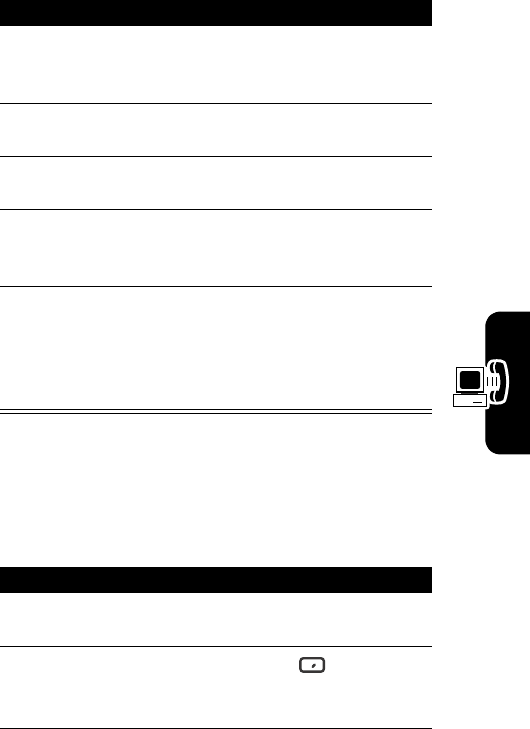
127
Getting More Out of Your Phone
DRAFT
Setting Up a Modem Connection
You can specify a type of connection (via USB or infrared)
for your phone to link with another device.
Setting Up a USB Modem Connection
2
If the
Install Wizard
appears, click
Next
from the
opening screen of the
Install Wizard
that states
Welcome to the New Found Hardware Wizard
.
3
Click on
Search for a suitable driver for my device
(recommended).
4
Next click
Specify a Location
and browse to the
folder in which you downloaded the driver.
5
Click
Next
to allow your computer to
automatically search and download the driver file
and click
Finish
.
6
After installing the modem, disconnect your
handset from the computer, and proceed to
To
Set Up a USB Modem Connection
. The
Smartphone
2003 Wireless USB Modem
should now be properly
listed in the
Device Manager
window.
Action
1
Make sure that your phone is not connected to
another device.
2
On the Home screen, press
Start
, select
More
, select
More
, select
More
, select
Accessories
,
and select
Modem Link
.
Action
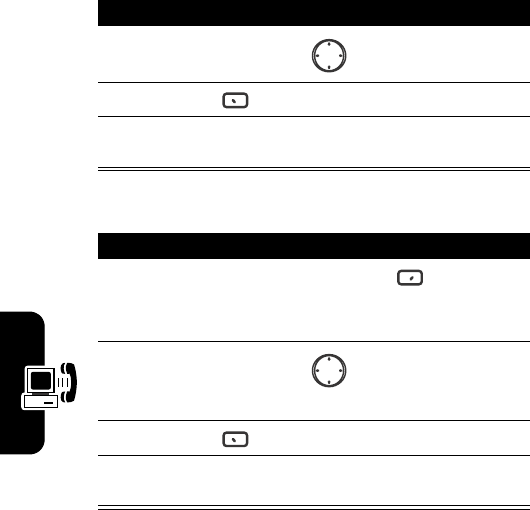
128
Getting More Out of Your Phone
DRAFT
Setting Up an Infrared Modem Connection
Querying a Modem
A modem query is necessary to establish a PC and
modem connection.
3
Under
Connection
, press left/right to select
USB
.
4
Press
Menu
and select
Activate
.
5
Now connect your phone to your computer with
the USB data cable.
Action
1
On the Home screen, press
Start
, select
More
, select
More
, select
More
, select
Accessories
,
and select
Modem Link
.
2
Under
Connection
, press left/right to select
IrCOMM
.
3
Press
Menu
and select
Activate
.
4
Now connect your phone to your computer with
the infrared port.
Action
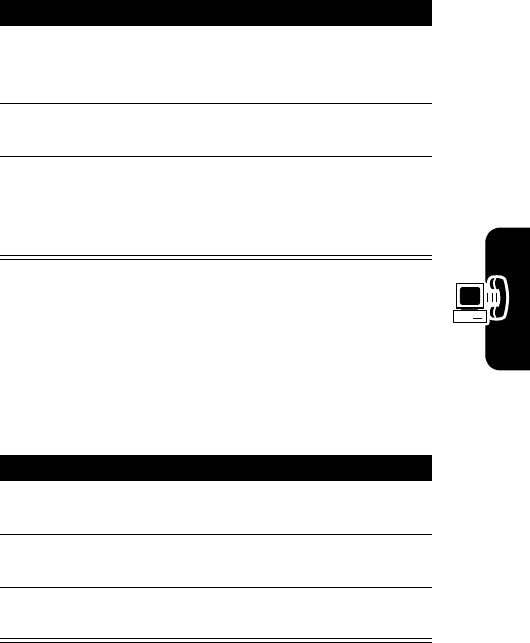
129
Getting More Out of Your Phone
DRAFT
Note:
If the PC and modem connection is not established in
approximately 30 seconds,
ActiveSync®
will take over the
USB port.
Adding an Initialization String
Add an extra initialization string to
Modem Properties
(change APN as needed). An extra initialization string is
needed on your phone for setting up the GPRS server
configuration. Contact your wireless service provider for
the APN name, user name, and password.
Action
1
On your computer, click on
Start
>
Settings
>
Control Panel
>
System
>
Hardware
>
Device
Manager
>
Modems
.
2
In the
Device Manager
window, double click on
Smartphone 2003 Wireless USB Modem
.
3
Select the
Diagnostics
tab and click
Query Modem
.
The PC sends AT commands and if the modem
replies back without an error, the modem is
properly installed.
Action
1
After querying the modem, click the
Advanced
tab
in the
Modem Properties
dialogue window.
2
Type in your initialization string and change the
APN name as needed.
3
For network’s initialization string use the
following:
+CGDCONT=1,“IP”,“apnname”,“”,0,0
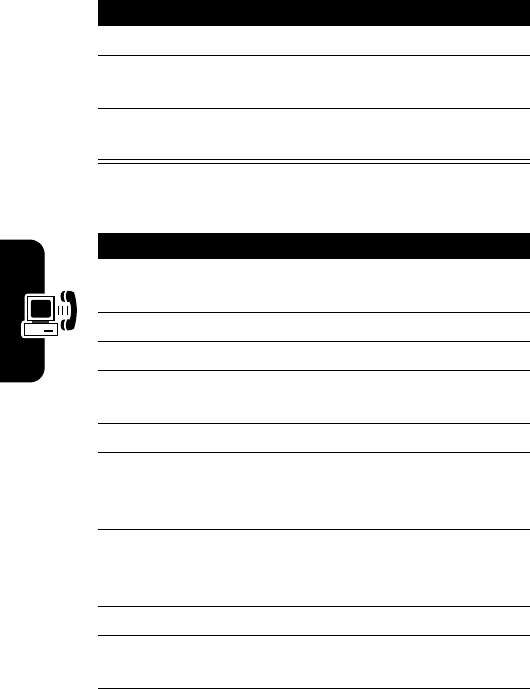
130
Getting More Out of Your Phone
DRAFT
Using the Motorola MPx220 Wireless USB
Modem for Cable GPRS
Adding a New Dial-Up Connection
Action
1
Activate the USB modem on your handset.
2
Establish a PC and modem connection (modem
query or hyper terminal AT commands).
3
Add a dial-up connection using the wireless USB
modem.
Action
1
From the
Control Panel
select
Network and Dial-up
Connection
.
2
Double click
Make New Connection
then click
Next
.
3
Select
Dial-up to Internet
then click
Next
.
4
From the
Internet Connection Wizard
select
Internet
Connection Manually
then click
Next
.
5
Select
Connect Through Phone Line and Modem
.
6
From modem selection, scroll down to
Smartphone 2003 Wireless USB Modem
then click
Next
.
7
Under
Telephone Number
type the codes your
network administrator provides and uncheck
area codes and dialing rules then click
Next
.
8
Fill in the
User Name
and
Password
and click
Next
.
9
Type in connection name (i.e. Smartphone USB
Cable GPRS) and click
Next
.
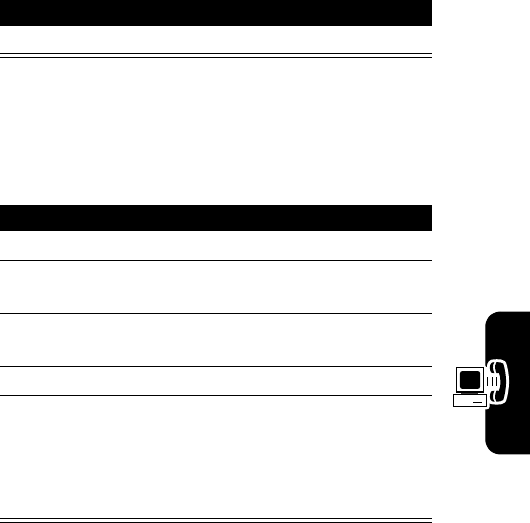
131
Getting More Out of Your Phone
DRAFT
Note:
Ensure
Smartphone 2003 Wireless USB Modem
is
selected and the hardware features are properly
configured before dialing.
Doubling Check Settings
Activating the Modem Link
After setting up your phone and your computer for the first
time, in order to initiate the modem session on your device
you need to perform the instructions described in each of
the 2 sections: “Setting Up a USB Modem Connection” on
page 127 if you use a USB data cable, or “Setting Up an
Infrared Modem Connection” on page 128 if you use an
infrared port.
10
Select
No
then
Next
and click
Finish
.
Action
1
Open a newly created dial-up connection.
2
Click
Properties
and verify
Smartphone 2003
Wireless USB Modem
is selected.
3
Click
Configure
and ensure all hardware features
are selected as shown above.
4
Click
OK
then
OK
.
5
After clicking
Dial
you should see
Opening
,
Dialing
,
Verifying User Name and Password
and
Registering Your Computer on the Network
. You are
GPRS connected when the dial-up dialogue
window changes to an icon in your icon tray.
Action
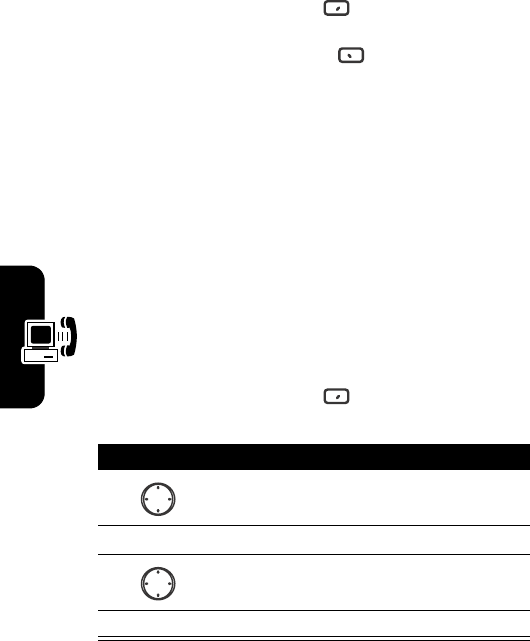
132
Getting More Out of Your Phone
DRAFT
Deactivating the Modem Link
Note:
Deactivate the modem link when you are finished
using it in order to avoid potential problems when using
ActiveSync®
in the same session.
Changing the Order of
Applications Displayed on the
Start List
Favorites Manager
allows you to select applications from
the
Favorites Manager
list and change their positions shown
on the Start list.
Find the Feature
Start
>
More
>
More
>
More
>
Accessories
>
Modem Link
>
Menu
>
Deactivate
Find the Feature
Start
>
More
>
Favorites
Manager
Press To
1
scroll to a desired application
2
Action
(
A
) select the application
3
up/down move the selected application
to a desired position
4
Action
(
A
) save the setting
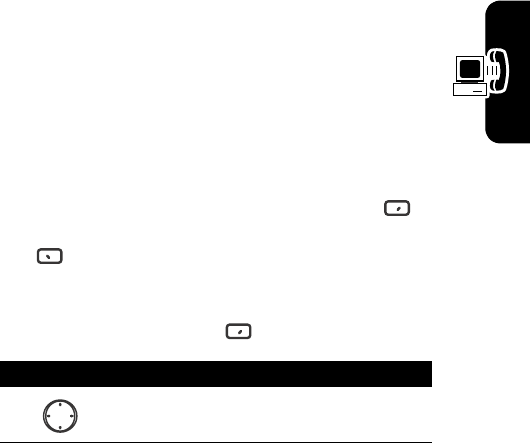
133
Getting More Out of Your Phone
DRAFT
Using File Viewer
Note:
Whether your phone is equipped with
File Viewer
is
subject to your service provider.
File Viewer
allows you to view the documents attached,
locally stored, or stored on your storage card without any
file-conversion or loss of content. It supports most
common desktop document formats (including PDF, Word,
Excel, PowerPoint...) and significant image formats (such
as JPEG, GIF, PNG...).
By default, Microsoft ActiveSync converts documents that
it recognizes to simpler formats. With
File Viewer
, this is not
necessary. Before you synchronize emails or copy files to
your phone for the 1st time, you should disable this
conversion, or you will not be able to open the email
attachments or copied files with
File Viewer
. Go to the
ActiveSync
®
Tools
>
Options
on your computer, then to
the
Rules
tab, and click on
Conversion Settings
. Uncheck
“
Convert files when synchronized, copied or moved
”; then click
on
OK
in each dialogue box.
Tip:
To send emails with attachments, press
Start
>
More
>
File Manager
> scroll to the file you want to send > press
Menu
>
Send
&
Receive
>
Send by E-mail
.
To view a document on your phone:
Find the Feature
Start
>
More
>
File Viewer
Press To
1
scroll to a desired folder
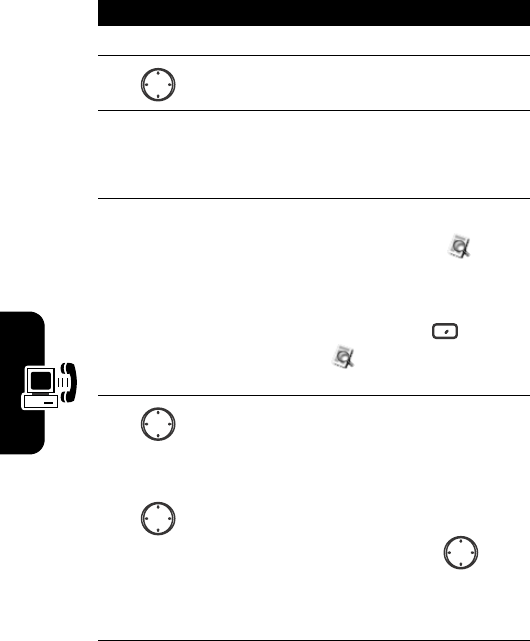
134
Getting More Out of Your Phone
DRAFT
2
Action
(
A
) select the folder
3
scroll to a desired folder or
file
4
Action
(
A
) select the folder or file
Tip:
Repeat steps 3-4 until
your desired file is found.
5
Action
(
A
) launch the document
zooming mode with
displayed in the bottom right
corner of the screen.
Tip:
Press
Hide Mode
to
keep from displaying on
the screen.
6
up/right
or
down/left
zoom the selected file in
or
zoom the selected file out
Tip:
Press and hold to
continuously magnify or
minify the size of the selected
document.
Press To
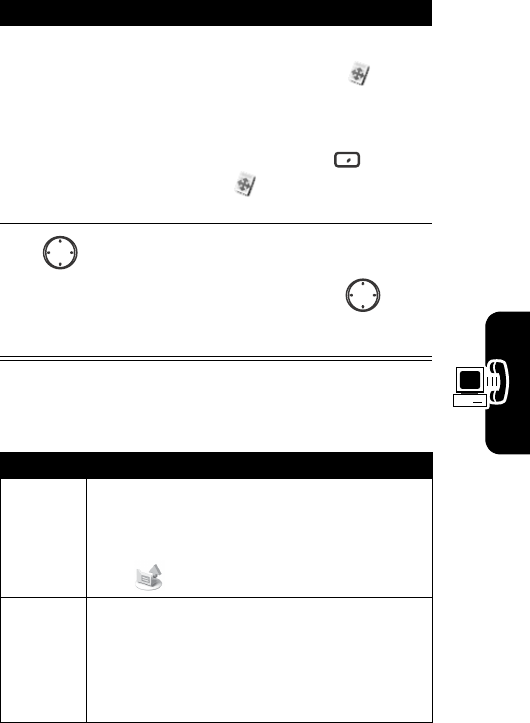
135
Getting More Out of Your Phone
DRAFT
The menu options for folders or files are described
below.
7
Action
(
A
) switch to the document
scrolling mode with
displayed in the bottom right
corner of the screen.
Tip:
Press
Hide Mode
to
keep from displaying on
the screen.
8
up/down/
left/right
view the different part of the
selected file
Tip:
Press and hold to
continuously move the page
in the desired direction.
Option Description
Document
View
/
Folders
switch between the document you are
viewing and the entire file structure. To go
to the folder above, tap the
Up directory
icon in the corner.
Page
rotate the screen, fit the size of the file to
the width of the screen (which may leave
blank areas depending on the aspect
ratio), or move to the page of the selected
document you want to view.
Press To
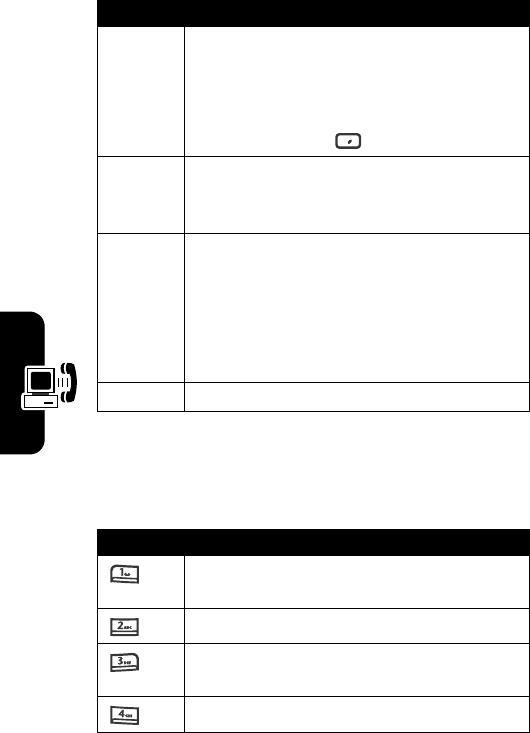
136
Getting More Out of Your Phone
DRAFT
You can also use the keypad to zoom pages in or out, view
different parts of pages, navigate among pages, rotate
pages and fit the size of pages to the width of the screen.
Favorites
add the selected document to the
Favorites list and it is displayed as a
thumbnail image or remove a desired
document from the Favorites list by
pressing
Add/Delete
.
History
display the file(s) you have viewed. Press
Action
(
A
) to open files from the History
list.
Settings
define how long you want the files stored
on the History list or clear the history
records immediately. You can also select
file types to associate with
File Viewer
, learn
how to use
File Viewer
and view the details
about it.
Close
exit from
File Viewer
.
Press To
go to the previous page of the selected
document.
scroll the page you are viewing up.
go to the next page of the selected
document.
scroll the page you are viewing left.
Option Description
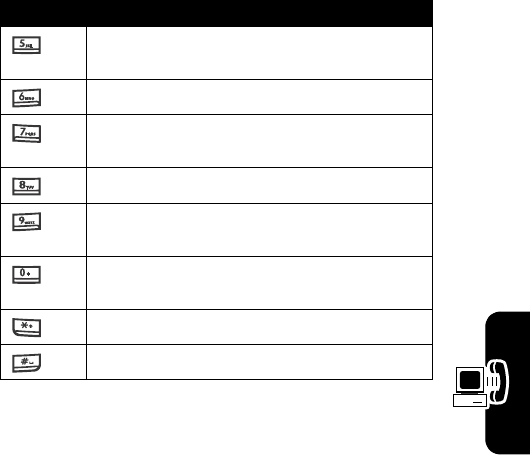
137
Getting More Out of Your Phone
DRAFT
rotate the page you are viewing 90
degrees counterclockwise/clockwise.
scroll the page you are viewing right.
go to the 1st page of the selected
document.
scroll the page you are viewing down.
go to the last page of the selected
document.
fit the size of the page you are viewing to
the width of the screen.
zoom the page you are viewing in.
zoom the page you are viewing out.
Press To
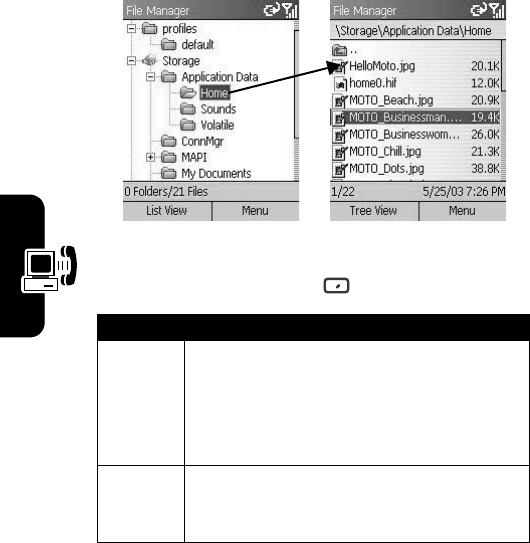
138
Getting More Out of Your Phone
DRAFT
Managing Files
File Manager
is for file and folder management in your phone.
It operates in 2 major views,
Tree View
and
List View
.
Starting File Manager
There are a variety of key features for
File Manager
:
Find the Feature
Start
>
More
>
File Manager
Option Description
Tree View
displays the entire file structure in your
phone’s memory. The functions in
Tree
View
primarily focus on folder
management (operates similar to
Microsoft Windows File Explorer).
List View
displays the details of the selected folder
(its sub-folders and files). The functions
in
List View
are basically file-oriented.
Tree View List View
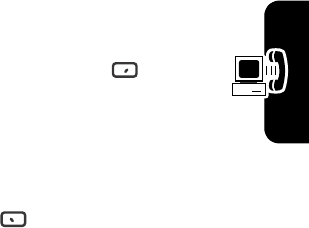
139
Getting More Out of Your Phone
DRAFT
•
Send the selected files via email, infrared beaming,
MMS, or Bluetooth radio, and receive files via infrared
beaming or Bluetooth radio.
•
Delete, move, or copy/paste folders and files.
•
Search for files according to portions of filenames
and/or text contained in the files.
•
View file or folder properties.
•
View information about memory utilization, device,
storage card, and battery power.
•
Sort listed files in a variety of ways (by
Name
,
Size
,
Date of
Last Change
, or
Type
, and by
Ascending
or
Descending
).
•
Create file shortcuts.
When
File Manager
is initially invoked, it is in
Tree View
by
default. To switch to
List View
, press
List View
. If the
currently selected folder contains no subfolders,
pressing
Action
(
A
) will also switch to
List View
. If the
selected folder in
Tree View
contains subfolders, press
Action
(
A
) to expand or collapse the tree for that folder. For most
functions, you must first select the file or folder you wish to
operate on, then press
Menu
to select the desired
command from the menu. Press
Action
(
A
) to run the
selected file.
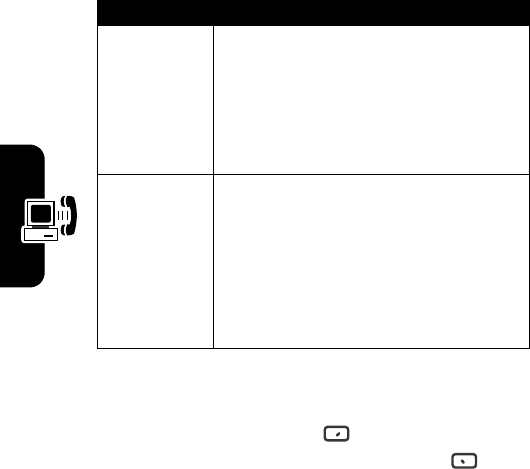
140
Getting More Out of Your Phone
DRAFT
Managing Phone System
Resources
Resource Manager
allows you to view and refresh the details of
battery power status and phone memory amount. It
consists of two features:
Task Manager
and
Space Manager
.
Using Task Manager
Option Description
Task Manager
lists all applications currently running
on your phone. You can easily
activate any currently running
application, terminate applications,
and refresh the list of running
applications.
Space Manager
lists all emails, SMS messages, voice
notes, speed dials, and call history
stored on your phone’s flash memory.
You can easily delete any of the files
saved on the flash memory and
refresh the amount of free flash
memory.
Find the Feature
Start
>
More
>
More
>
Resource Manager
>
Menu
>
Task Manager
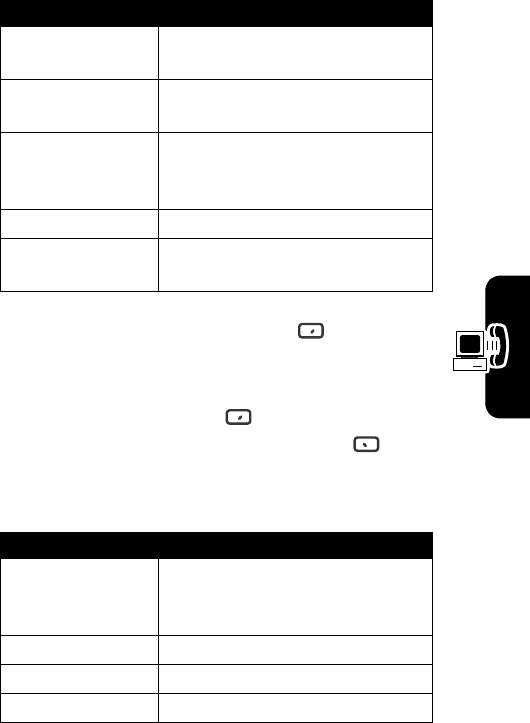
141
Getting More Out of Your Phone
DRAFT
The menu options for
Task Manager
are listed below:
Tip:
To ex i t f r o m
Task Manager
, press
Quit
.
Using Space Manager
The menu options for
Space Manager
are listed below:
Option Description
Kill
terminate the selected
application
Kill All
terminate all running
applications
Kill All Except Selected
terminate all running
applications except the selected
one
Go To
open the selected application
Refresh
refresh the list of running
applications
Find the Feature
Start
>
More
>
More
>
Resource Manager
>
Menu
>
Space Manager
Option Description
Erase Messages In
Inbox...
delete all messages in the
selected folder from any of your
accounts
Erase Call History
clear call history
Erase Speed Dial
delete all speed dial settings
Erase Voice Notes
delete all voice notes
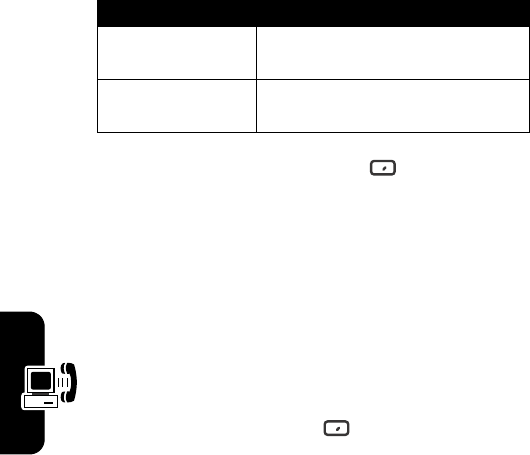
142
Getting More Out of Your Phone
DRAFT
Tip:
To ex i t f r o m
Space Manager
, press
Quit
.
Removing Programs
Remove Programs
settings lets you remove programs installed
on your phone, with the exception of core programs that
came with the phone, such as
Contacts
,
Calendar
, and
Internet
Explorer®
. If you accidentally remove a program on the
device, you can find it on the companion CD to
reinstall.
Erase All
delete all messages, call history,
speed dials, and voice notes
Refresh
refresh the free flash memory
amount
Find the Feature
Start
>
Settings
>
More
>
Remove Programs
Option Description
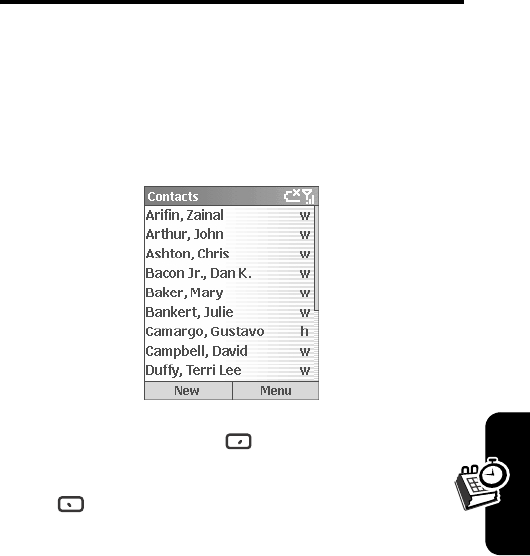
DRAFT
143
Personal Organizer
Personal Organizer
This chapter introduces features on your phone that help
you manage and keep track of contacts and appointments,
maintain a “things to do” list and use the calculator.
Using Contacts
Tip:
You can also access
Contacts
by pressing
Contacts
on the Home screen.
You can think of
Contacts
as an address book, where you
store information about people and businesses you
communicate with in contact cards. For example, you can
store multiple phone numbers, email, and street
addresses, Web pages, and other information on such as
a birthday or anniversary date. You can use
Contacts
to dial
phone numbers and compose email and SMS messages
directly from a contact card.
Find the Feature
Start
>
Contacts
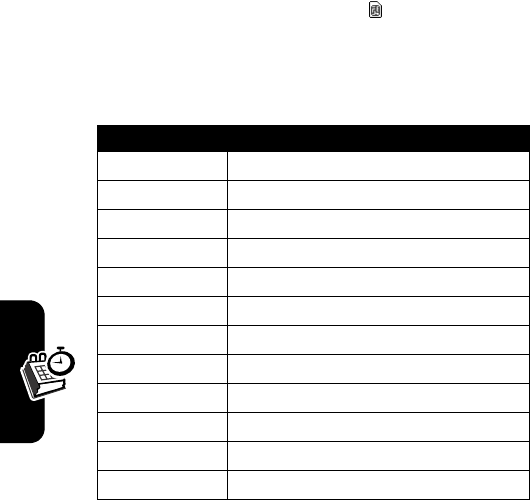
DRAFT
144
Personal Organizer
The contacts list displays the names of your contact cards
alphabetically, along with an abbreviation for the default
communication method, such as the person’s work phone
number (
w
) or home phone number (
h
).
Note:
If the contact card includes a work phone number,
your phone will automatically set it as the default number.
The contact cards along with the icon are the entries
stored on your SIM card.
The following table shows possible abbreviations and their
meanings that might display in your contacts list.
Abbreviation Description
w
work phone
w2
2nd work phone
h
home phone
h2
2nd home phone
m
mobile phone
pgr
pager
car
car phone
txt
SMS address (SMS phone number)
e
email address
e2
2nd email address
e3
3rd email address
web
web page
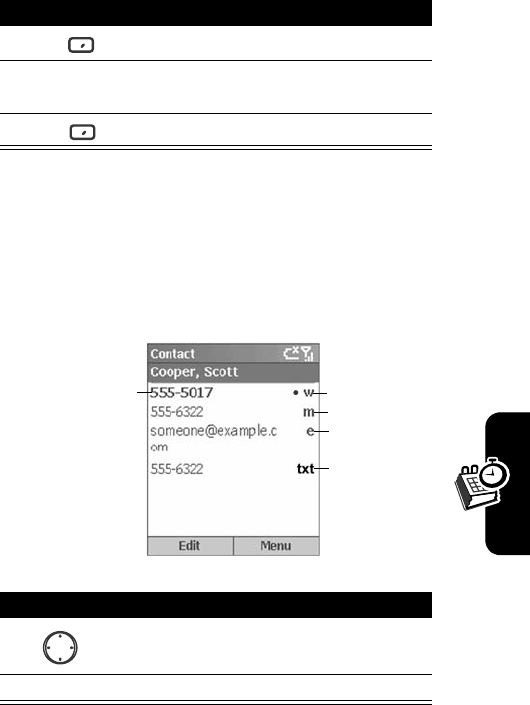
DRAFT
145
Personal Organizer
Creating a New Contact
Tip:
When you create a new contact on your phone, you
can synchronize
Contacts
with your desktop computer or a
server to keep your contact information current in all
locations.
Viewing a Contact
Press To
1
New
open an empty contact card
2
keypad keys enter the appropriate
information
3
Done
save the contact
Press To
1
scroll to a desired contact
2
Action
(
A
)
view the contact
Work number
Mobile number
Email address
SMS message
number
Number with a
black dot denotes
default number
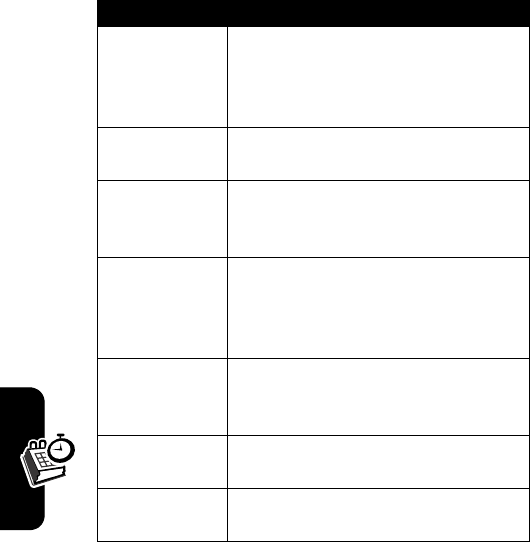
DRAFT
146
Personal Organizer
The following table lists the contact card menu options and
their functions.
* This feature is available only for the contacts saved in
your phone memory.
Option Description
Add Speed Dial *
create a shortcut to the selected
phone number, email address, or
Web URL by assigning 1 or 2
numbers as a speed dial
Send Text Message
compose and send SMS message
to the selected contact
Save to SIM/
Save to Contacts
copy the selected contact saved in
your phone to the SIM card or vice
versa
Set as Default
set the selected phone number,
email address, or SMS number as
the default communication method
for the contact
Beam Contact
send the selected contact card to
another mobile device or desktop
computer using infrared
Delete
remove the selected contact card
from the contacts list
Edit
modify information on the selected
contact card
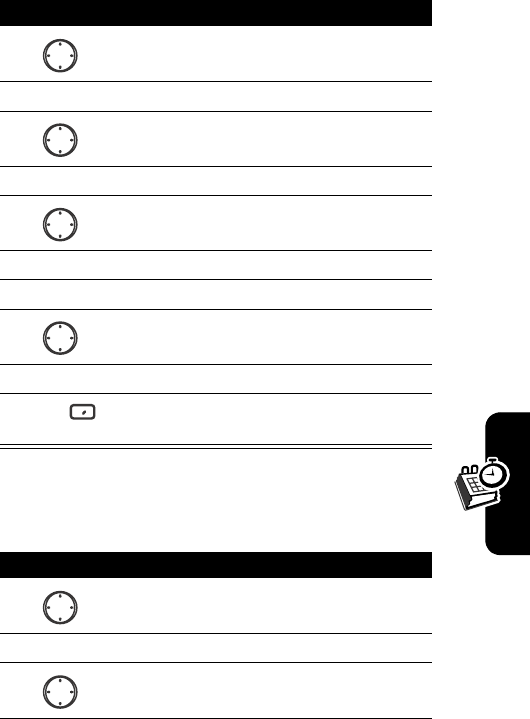
DRAFT
147
Personal Organizer
Sending an Email from a Contact
Sending an SMS Message from a
Contact
Press To
1
scroll to a desired contact
2
Action
(
A
)
open the contact
3
scroll to a desired email
address
4
Action
(
A
)
select the email address
5
scroll to
Outlook E-Mail
6
Action
(
A
)
select
Outlook E-Mail
7
keypad keys enter your subject
8
down go to the body text field
9
keypad keys edit your message
10
Send
send the message to the
selected contact
Press To
1
scroll to a desired contact
2
Action
(
A
)
open the contact
3
scroll to the SMS message
number
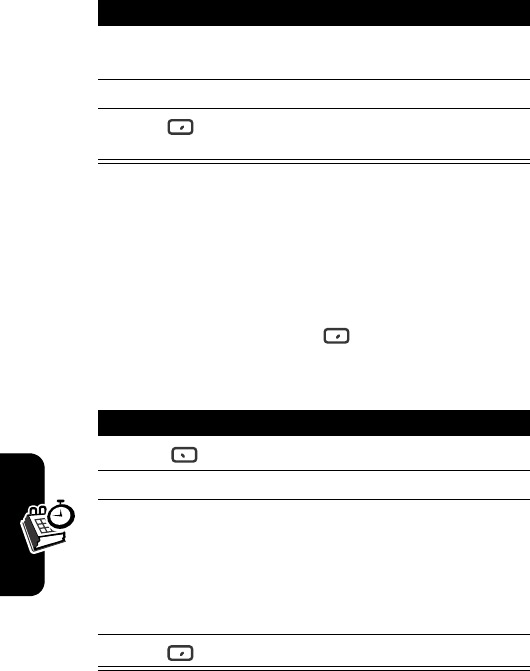
DRAFT
148
Personal Organizer
Using Calendar
Calendar
is your phone’s scheduling program, where you can
create and view appointments, and view your
Calendar
by
day, week, or month.
Creating a New Appointment
Tip:
When you create a new appointment on your phone,
you can synchronize
Calendar
with your desktop computer or
4
Action
(
A
)
select the SMS message
number
5
keypad keys edit your message
6
Send
send the message to the
selected contact
Find the Feature
Start
>
Calendar
Press To
1
Menu
open the options menu
2
Action
(
A
)
select
New
3
keypad keys edit the appointment
Tip:
Under
Reminder
, select the
amount of time you want the
reminder to appear before the
appointment.
4
Done
save the appointment
Press To
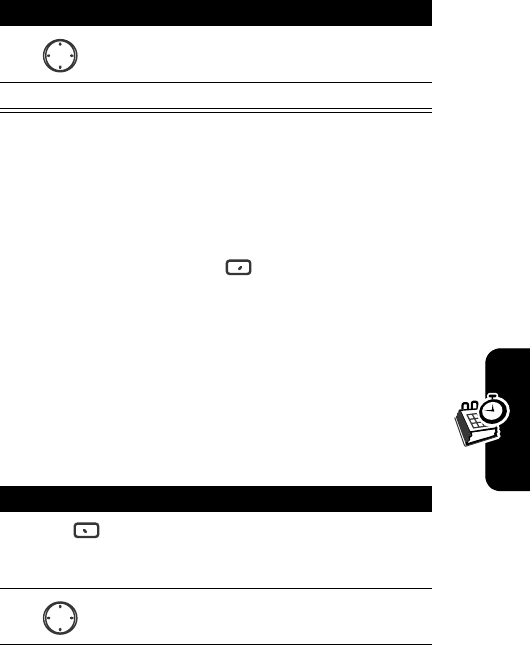
DRAFT
149
Personal Organizer
a server to keep your schedule information current in all
locations.
Viewing an Appointment
Using Schedule
You can view your schedule in
Calendar
using 3 different
views:
Agenda View
,
Week View
, and
Month View
.
Using Agenda View
Agenda View
is the default view for calendar information. This
view displays meetings and appointments scheduled
for the current day. The appointments appear in
chronological order according to start time.
Viewing Your Agenda for the Current Day
Press To
1
scroll to a desired
appointment
2
Action
(
A
)
display the appointment
Find the Feature
Start
>
Calendar
Press To
1
Menu
open the options menu (if you
are using the
Week View
or
Month
View
)
2
scroll to
Agenda View
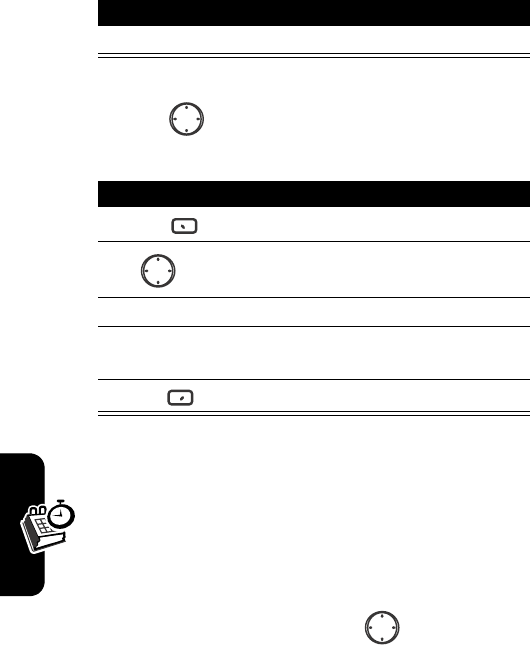
DRAFT
150
Personal Organizer
Tip:
To look at your agenda for previous or approaching
dates, press left/right.
Viewing Your Agenda for a Specific Date
Using Week View
The
Week View
shows your schedule for the specified
week. This view allows you to get a quick indication of
your free and busy time, and allows you to create an
appointment at a selected time easily. The
Week View
displays the hours in 1-hour increments by default on the
left side of the screen. You can press up/down to
navigate through the hours on the screen.
3
Action
(
A
)
select
Agenda View
Press To
1
Menu
open the options menu
2
scroll to
Go to Date
3
Action
(
A
)
select
Go to Date
4
keypad keys enter the date you want to
view
5
Done
display the agenda
Press To
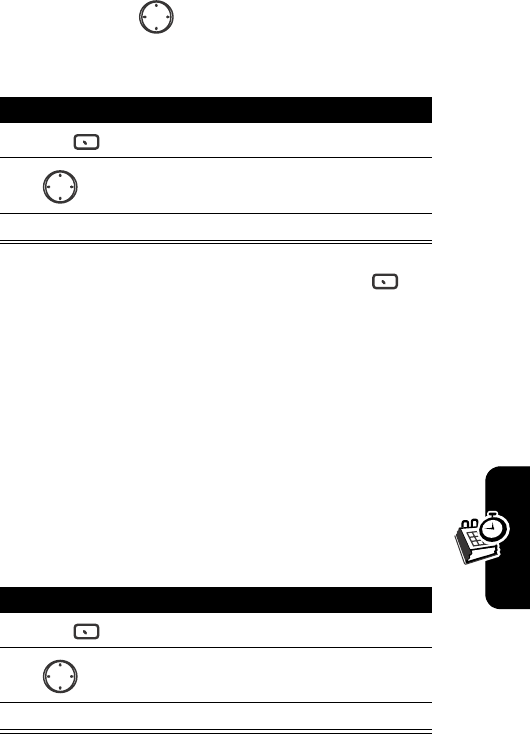
DRAFT
151
Personal Organizer
Note:
If you press up/down and leave the
Week View
, the
hours last shown will be displayed the next time you return
to the
Week View
.
Tip:
To change settings for
Week View
, press
Menu
and
select
Options
.
Using Month View
The
Month View
provides an overview of your monthly
schedule. Arrow indicators pointing up represent morning
appointments, and the arrows pointing down represent
afternoon appointments. A hollow box indicates an all-day
event. A solid box indicates you have morning and
afternoon appointments. If you have morning and
afternoon appointments plus an all-day event, a solid
box is surrounded by a hollow box.
Press To
1
Menu
open the options menu
2
scroll to
Week View
3
Action
(
A
)
select
Week View
Press To
1
Menu
open the options menu
2
scroll to
Month View
3
Action
(
A
)
select
Month View
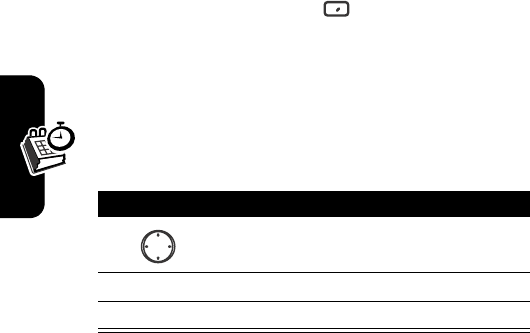
DRAFT
152
Personal Organizer
Using Tasks
You can use
Tasks
to track a personal or work-related
project, assignment, or errand from beginning to
completion. A task can occur once or repeatedly. A
recurring task can repeat at regular intervals or repeat
based on the date you mark the task complete. For
example, you might want to pay a bill on the last Friday of
every month, or get a haircut when one month has passed
since your last haircut. The
Tasks
list shows your “things to
do.” An item followed by an exclamation mark indicates
high priority and an item with a down arrow is marked as
low priority. Overdue tasks display bold and red.
Completed tasks display with the corresponding check box
selected.
Note:
If you synchronize
Tasks
with your desktop computer,
completed tasks are removed from your phone after
synchronization. They are then displayed in gray with a
strikethrough on your desktop computer.
Creating a New Task
Find the Feature
Start
>
More
>
More
>
Tasks
Press To
1
up select the
Enter new task here
field
2
keypad keys enter the task
3
Action
(
A
)
save the task
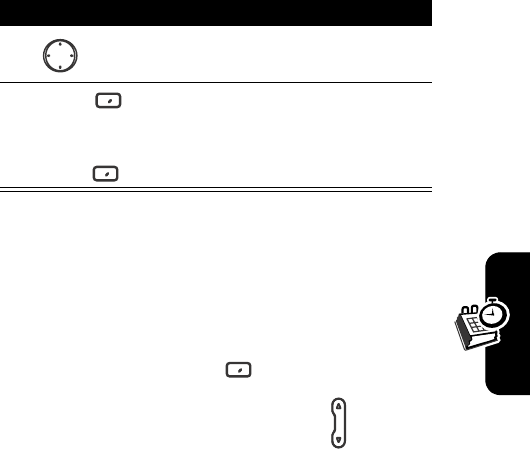
DRAFT
153
Personal Organizer
Tip:
When you create a new task on your phone, you can
synchronize
Tasks
with your desktop computer to keep your
tasks list current in both locations. If you create a new task
with a reminder on your desktop computer, you can
synchronize
Tasks
so that you hear the reminder on your
phone.
Marking a Task as Complete/Incomplete
Using Voice Recorder
Use
Voice Recorder
to create short voice recordings.
Recordings are included in the
All Notes
list and are
named consecutively (
Recording1
,
Recording2
, and so on).
Tip:
On the Home screen, press and hold down to
quickly open
Voice Recorder
.
Press To
1
scroll to a desired task
2
Complete
or
Activate
mark the task as complete
or
mark the task as incomplete
Find the Feature
Start
>
More
>
More
>
Voice Recorder
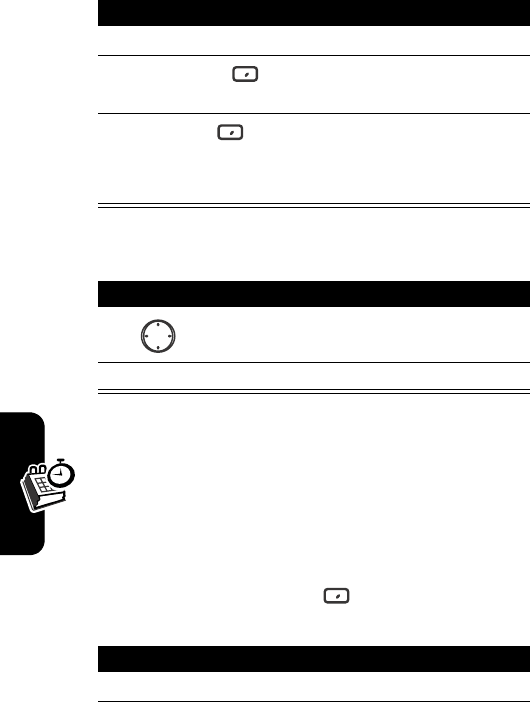
DRAFT
154
Personal Organizer
Creating a Voice Note
Playing a Voice Note
Using Calculator
You can use
Calculator
to perform any of the standard
operations for which you would normally use a
handheld calculator.
Calculator
performs basic arithmetic,
such as addition, subtraction, multiplication, and division.
Action
1
Hold your phone’s microphone near your mouth.
2
Press
Record
to begin recording your voice
note.
3
Press
Stop
to stop recording your voice note.
Note:
The length of time to record a voice note
depends on the remaining phone storage.
Press To
1
scroll to a desired voice note
2
Action
(
A
)
play the voice note
Find the Feature
Start
>
More
>
More
>
More
>
Accessories
>
Calculator
Press To
1
number keys enter numbers
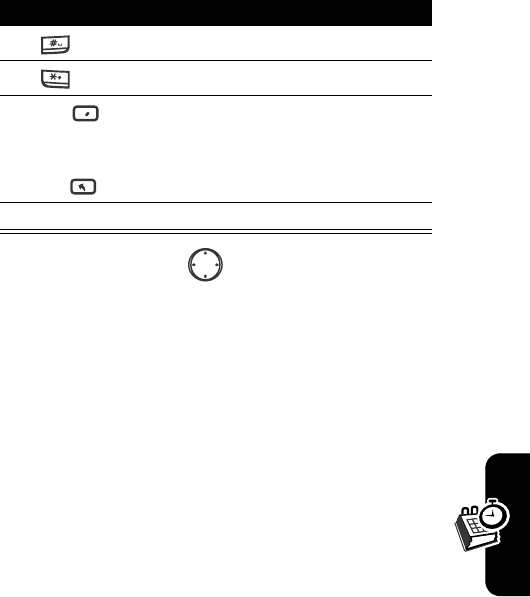
DRAFT
155
Personal Organizer
Tip:
You can also press to display the available
mathematical symbols. Press Up for the plus sign (+),
Down for the minus sign (-), Left for the division sign (/),
and Right for the multiplication sign (x).
2
select a mathematical symbol
3
enter a decimal point
4
Clear
or
Back
delete the last input
5
Action
(
A
)
perform the calculation
Press To
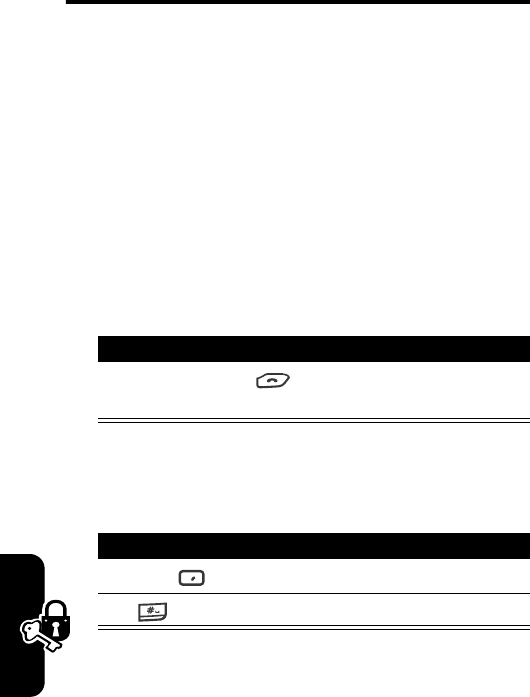
DRAFT
156
Security
Security
Use
Security
settings to turn on phone lock or SIM lock and
to set the phone lock password.
Locking and Unlocking the
Keypad
The keypad lock turns off the keypad function to prevent
accidental keypresses.
Locking the Keypad
On the Home screen:
Unlocking the Keypad
On the Home screen:
Tip:
You still can receive calls and make emergency
calls when the keypad is locked.
Action
Press and hold
End
. The left soft key displays
Unlock
, indicating that the keypad is locked.
Press To
1
Unlock
prepare to unlock the keypad
2
unlock the keypad
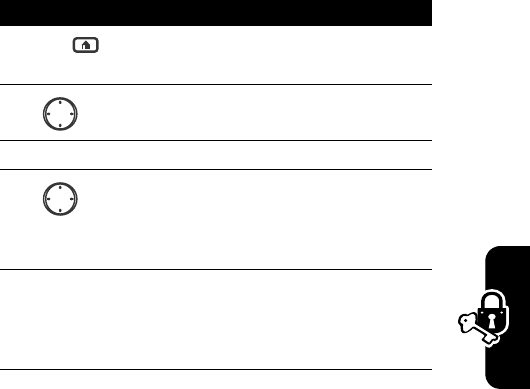
DRAFT
157
Security
Locking and Unlocking Your
Phone
Locking the phone prevents access to personal data.
When you turn on this feature, the phone automatically
locks after a specified time of inactivity. A screen displays
requiring your phone lock password before access is
granted.
Tip:
You still can receive calls and make emergency calls
when the phone is locked.
Locking the Phone
On the Home screen:
Press To
1
Home
for a
while
open the
Quick List
2
scroll to
Device lock
3
Action
(
A
)
select
Device lock
4
left/right select a time period the
phone is inactive before it
automatically locks under
Lock
phone after
5
keypad keys enter the password you want
to use to access the phone
when it is locked under
Password
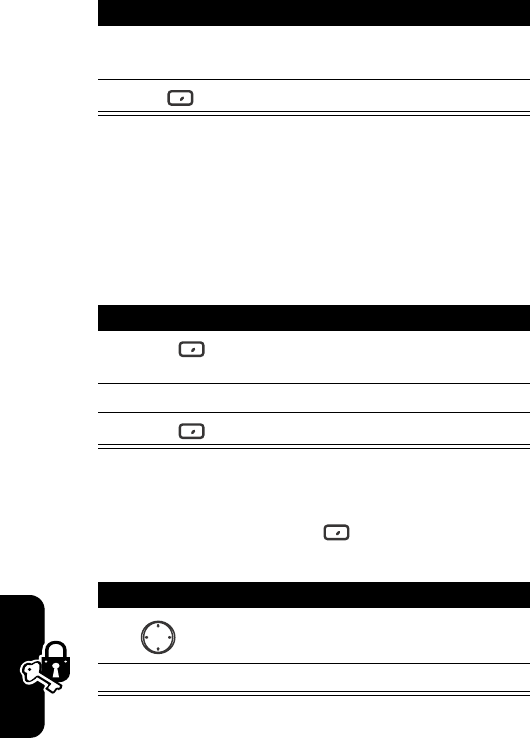
DRAFT
158
Security
Tip:
After you select the time delay and create a password,
you can quickly lock your phone from the
Quick List
, without
having to view these settings.
Unlocking the Phone
On the Home screen:
Turning Off Phone Lock
6
keypad keys enter the password again
under
Confirm password
7
Done
save the settings
Press To
1
Unlock
prepare to enter the
password
2
keypad keys enter the password
3
Unlock
unlock the phone
Find the Feature
Start
>
Settings
>
More
>
Security
Press To
1
scroll to
Disable Phone Lock
2
Action
(
A
)
turn off phone lock
Press To
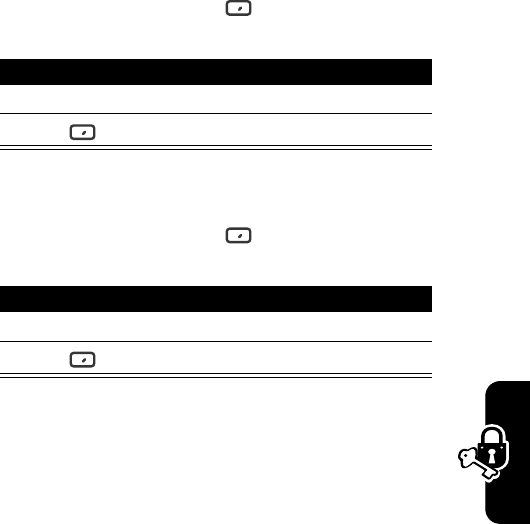
DRAFT
159
Security
Locking and Unlocking Your
SIM Card
Locking the SIM card prevents you and others from using
your phone until the correct password is entered. You still
can make emergency calls when the SIM card is locked.
Locking the SIM Card
Unlocking the SIM Card
Find the Feature
Start
>
Settings
>
More
>
Security
>
Enable SIM Lock
Press To
1
keypad keys enter your PIN1 password
2
Done
lock your SIM card
Find the Feature
Start
>
Settings
>
More
>
Security
>
Disable SIM Lock
Press To
1
keypad keys enter your PIN1 password
2
Done
unlock your SIM card
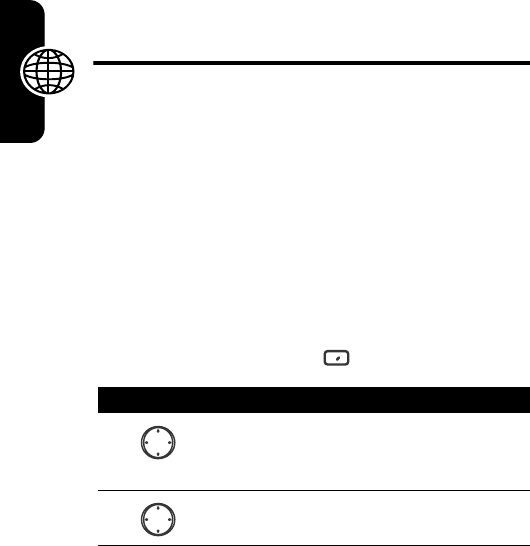
DRAFT
160
News and Entertainment
News and
Entertainment
Taking Pictures
You can capture images and store them in your phone or
memory card. There are 3 different modes to capture
photos:
Normal
,
Timer
, and
Burst
.
Using Normal Mode
Normal
mode is selected as the default when you launch
Camera
.
Find the Feature
Start
>
More
>
Camera
Press To
1
up/down zoom in/out (when the flip is
opened and the internal
viewer is used)
2
left/right decrease/increase the
brightness
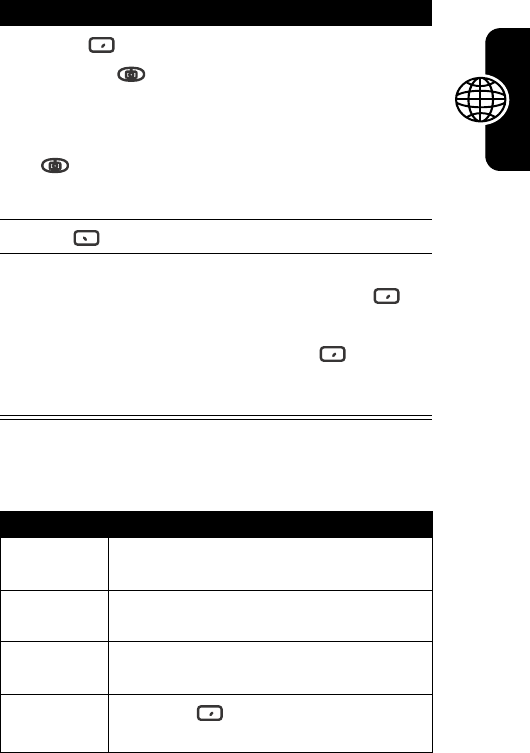
DRAFT
161
News and Entertainment
The menu options before taking pictures are described
below.
3
Capture
/
Action
(
A
)/
or
take a picture (when the flip is
opened and the internal
viewer is used)
or
take a picture (when the flip is
closed and the external
viewer is used)
4
Menu
open the options menu
5
Action
(
A
)select
Store in Album
and the
picture is saved in
Start
>
More
>
PhotoAlbum
Tip:
Press
Discard
if you do
not want to save the current
photo.
Option Description
Mode
switch between
Normal
,
Timer
, and
Burst
modes
Enable/Disable
Flash
turn on/off the flash
Settings
open the
Camera Settings
menu (see
below)
Browse Photos
go to
Start
>
More
>
PhotoAlbum
to view
photos
Press To
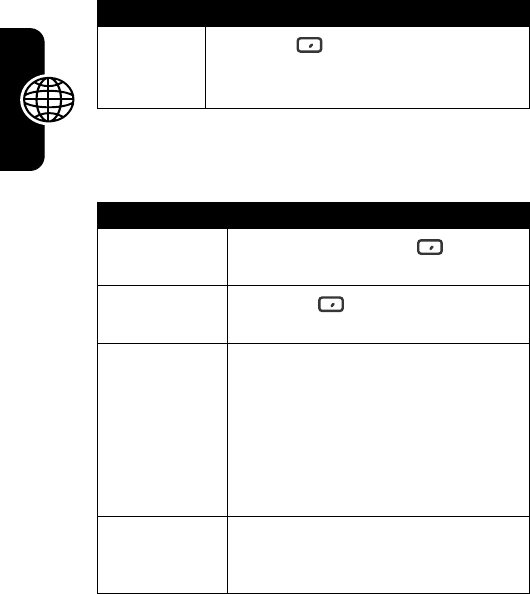
DRAFT
162
News and Entertainment
The menu options after taking pictures are described
below.
Record Video
go to
Start
>
More
>
More
>
More
>
Accessories
>
Camcorder
to create video
clips
Option Description
Store in Album
store the photo in
Start
>
More
>
PhotoAlbum
Send in Message
open
Start
>
Messaging
>
Media
Messages
with the photo attached
Apply as Wallpaper
set the photo as your wallpaper
(Choose either
Fit in
or
Best fit
. The
former displays the entire photo,
which may leave blank areas
depending on the aspect ratio. The
latter crops the photo and fills it
entirely on the screen.)
Attach to Contact
set the photo as Caller ID to the
selected contact (The photo
displays when you receive the call.)
Option Description
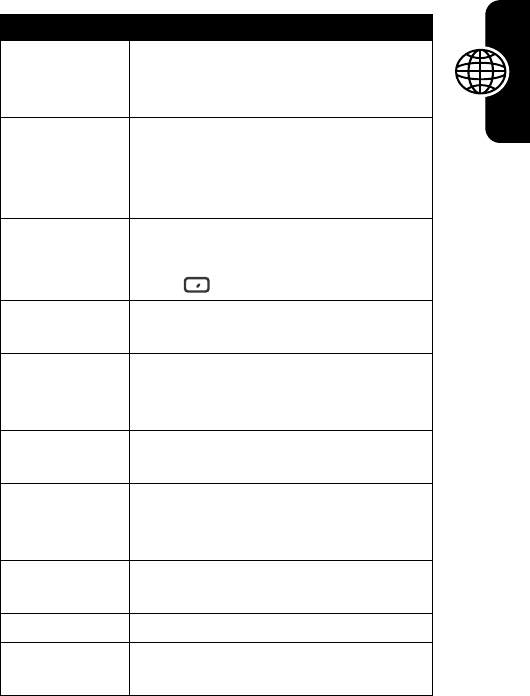
DRAFT
163
News and Entertainment
The
Camera Settings
menu options are described below.
Option Description
White balance
choose from a variety of presets
depending on your shooting
conditions
Resolution
select the size of captured photos
(The higher the resolution, the more
space required to store the image
on your phone.)
Storage folder
choose a different folder to store
your captured photos by pressing
Change
File size restriction
choose to keep your files under
100KB
, or place no constraint at all
Max idle time
set the time it takes for the camera
to turn off when no action is taken in
order to conserve power
Name prefix
enter in a prefix to save as the file
name of your captured photos
Time stamp on
picture
check this feature to include an
overlay of the date on all of your
captured photos
Contrast
set the default contrast for the
viewer
Hue
set the default hue for the viewer
Saturation
set the default saturation for the
viewer
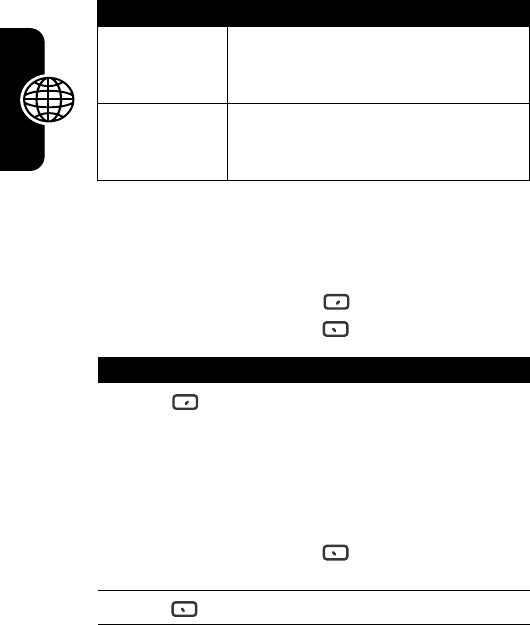
DRAFT
164
News and Entertainment
Using Timer Mode
Controls here are almost identical to
Normal
mode.
Self-imaging Timer
set the duration of the timer for use
when taking delayed photos in
Timer
mode
Max burst number
set the maximum number of images
that can be taken at a time while in
Burst
mode
Find the Feature
Start
>
More
>
Camera
>
Menu
>
Mode
>
Timer
Press To
1
Start
take a picture
Note:
There is a delay before
the photo is taken. Your
phone will beep for each
second of the countdown
(which can be adjusted in
Menu
>
Settings
>
Self-imaging
Timer
).
2
Menu
open the options menu
Option Description
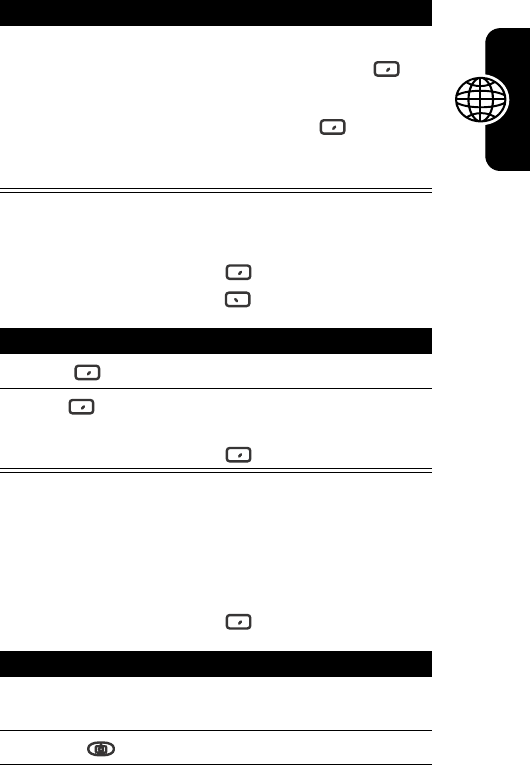
DRAFT
165
News and Entertainment
Using Burst Mode
Using Self-Shot
You can take a shot of yourself and store it in your phone
or memory card.
3
Action
(
A
)select
Store in Album
and the
picture is saved in
Start
>
More
>
PhotoAlbum
Tip:
Press
Discard
if you do
not want to save the current
photo.
Find the Feature
Start
>
More
>
Camera
>
Menu
>
Mode
>
Burst
Press To
1
Start
take pictures
2
Stop
stop taking pictures and the
pictures are stored in
Start
>
More
>
PhotoAlbum
Find the Feature
Start
>
More
>
Camera
Action
1
Close the phone flip and use the external viewer
to capture images.
2
Press to take your picture.
Press To
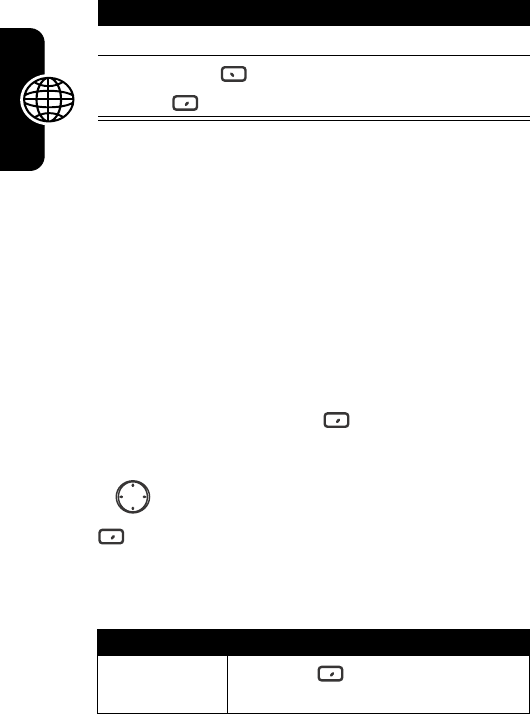
DRAFT
166
News and Entertainment
Managing Pictures
You can use
PhotoAlbum
to view and edit images on your
phone and send them via MMS, email, Bluetooth, or
infrared.
PhotoAlbum
consists of 2 different modes:
Album
view
and
Single Photo
view.
Using Album View
This view displays thumbnail images of photos stored in a
specific directory.
To open a photo, press the corresponding number. Or,
press to highlight the desired thumbnail and press
Open
. See “Using Single Photo View” on page 168 for
details on viewing single photos.
The menu options for
Album
view are described below.
3
Open the phone flip.
4
Press
Menu
>
Action
(
A
) to save the picture in
Start
>
More
>
PhotoAlbum
.
Find the Feature
Start
>
More
>
PhotoAlbum
Option Description
Take new photo
go to
Start
>
More
>
Camera
to take
photos
Action
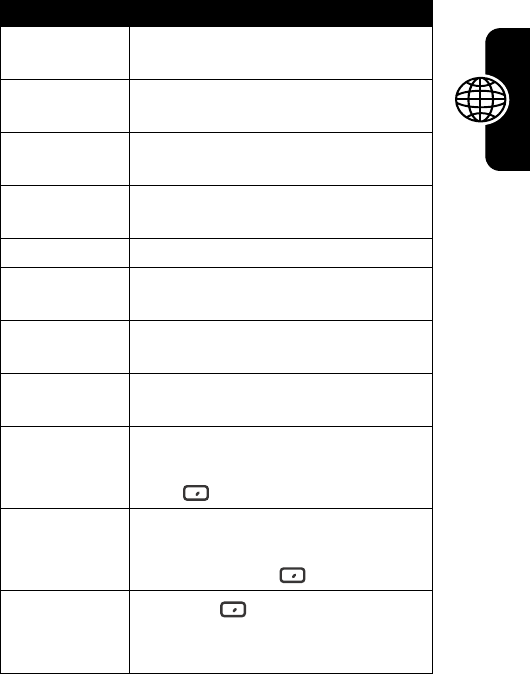
DRAFT
167
News and Entertainment
Send via
send the current photo via MMS,
email, Bluetooth, or infrared
Move
move the current photo to a folder of
your choice
Copy
copy the current photo to a folder of
your choice
Rename
change the name of the current
photo
Delete
remove the current photo
Properties
display the current photo’s
resolution, date, color depth, etc.
Slide Show
play a slide show of all the photos in
the current location
Change Folder
display photos contained in another
folder of your choice
Attach to Contact
associate the current photo with a
contact of your choice by pressing
Attach
View Photo
Contacts
display a list of your contacts and let
you detach any associated photos
by pressing
Detach
Play Video
go to
Start
>
More
>
More
>
More
>
Accessories
>
Video Player
to play video
clips
Option Description
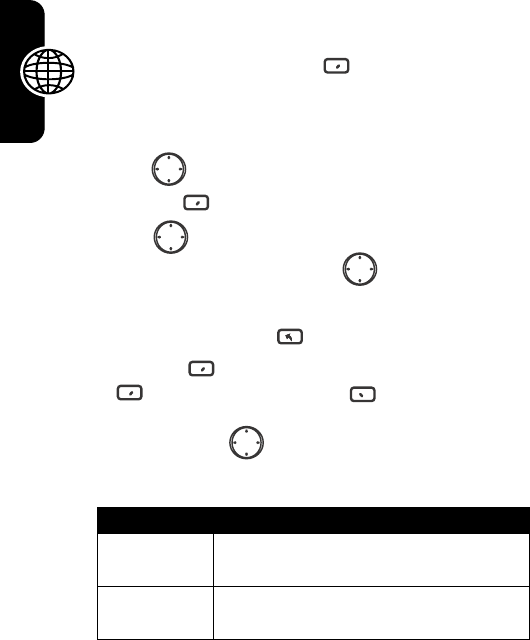
DRAFT
168
News and Entertainment
Using Single Photo View
This view displays each photo on the screen.
Press different keys to do the following:
•
To open a photo, press the corresponding number. Or,
press to highlight the desired thumbnail and
press
Open
.
•
Press up/left to display the previous photo in the
current folder (if any) or press down/right to
display the next photo in the current folder (if any).
•
Press
Action
(
A
) or
Back
to return to
Album
view.
•
Press
Zoom
to zoom in/out commands. Press
Zoom
in
to magnify; press
Zoom out
to minify. If your
photo does not fit entirely on the display when
zooming, press to scroll.
The menu options for
Single Photo
view are described below.
Find the Feature
Start
>
More
>
PhotoAlbum
Option Description
Rotate Left
rotate your photo 90 degrees to the
left
Rotate Right
rotate your photo 90 degrees to the
right
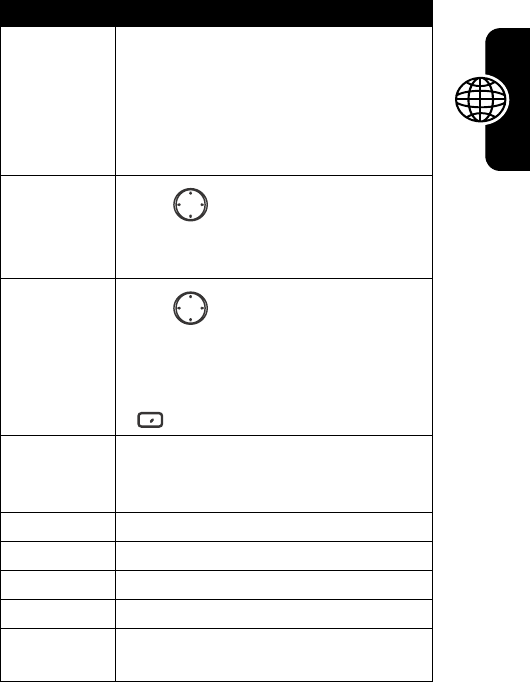
DRAFT
169
News and Entertainment
Crop
isolate a specific area of the photo (A
crop box will appear, everything
outside of the box will be removed.
You can adjust the position and size
of the box using the following 2 menu
options.)
>
Move
press to move the crop box
(Press
Action
(
A
) to toggle between
Move
and
Resize
for ease of use.)
>
Resize
press to resize the crop box
(Press Up/Down to decrease/
increase height; press Left/Right to
make it narrower/wider. Press
Crop
it
when you are ready.)
Add Text
add additional lines of text to your
photo using the following 5 menu
options
>
Edit text
modify the current line
>
Delete text
remove the current line
>
Change color
change the color of the current line
>
Font size
change the size of the current line
>
Switch
switch to the previous or next line of
text to edit it
Option Description
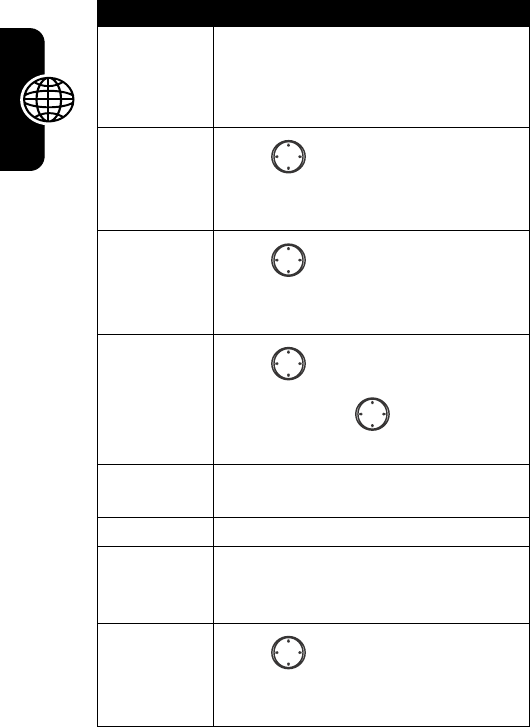
DRAFT
170
News and Entertainment
Add Clip Art
add a variety of fun and unusual
images to your photo (The following 5
menu options are related to this
feature.)
>
Resize
press to resize the clip art
(Press Up/Left to make it smaller;
press Down/Right to make it larger.)
>
Reposition
press to move the clip art
around your photo (This is the default
selection.)
>
Rotate
press up/left to rotate the clip art
to the left; press down/right to
rotate the clip art to the right
>
Switch
switch between different pieces of clip
art you added
>
Remove
remove the current piece of clip art
Add Frame
add a comical frame around your
photo (The following 7 menu options
are related to this feature.)
>
Reposition
press to move your photo within
the frame (This is the default
selection.)
Option Description
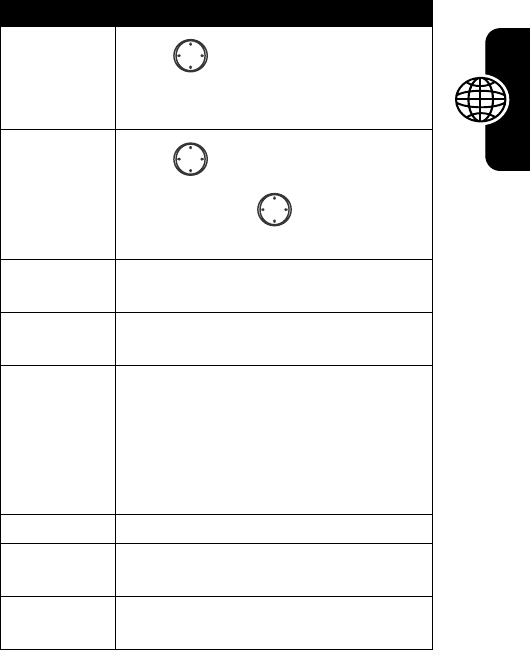
DRAFT
171
News and Entertainment
>
Resize
press to resize the photo (Press
Up/Left to make it smaller; press
Down/Right to make it larger.)
>
Rotate
press up/left to rotate the photo
to the left; press down/right to
rotate the photo to the right
>
Flip horizontal
create a mirror image of your photo
over the horizontal axis
>
Flip vertical
create a mirror image of your photo
over the vertical axis
>
Crop
isolate a specific area of the photo (A
crop box will appear, everything
outside of the box will be removed.
You can adjust the position and size
of the box using the 2 menu options:
Move
and
Resize
.)
>
Change frame
select a different template
Previous Photo
display the previous photo in the
current location
Next Photo
display the next photo in the current
location
Option Description
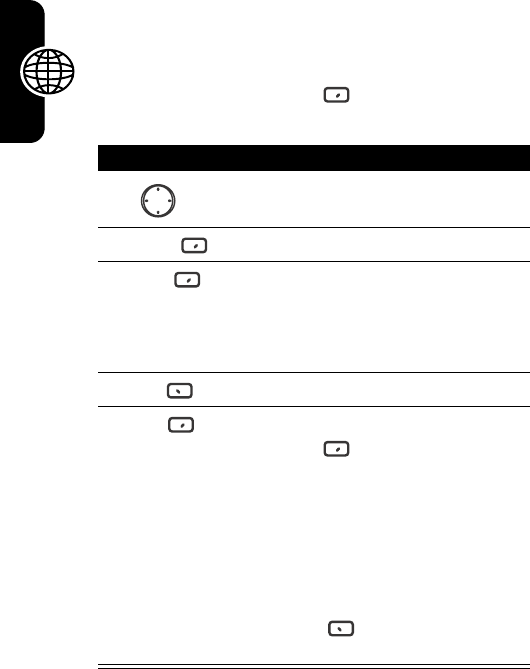
DRAFT
172
News and Entertainment
Creating Video Clips
You can record video clips with or without audio and
store them in your phone or memory card.
Find the Feature
Start
>
More
>
More
>
More
>
Accessories
>
Camcorder
Press To
1
left/right decrease/increase camera
brightness level
2
Record
record a video clip
3
Pause
pause recording
Tip:
Press
Action
(
A
) to toggle
between the
Record
and
Pause
states.
4
Stop
stop recording
5
Save
save your recording in
Start
>
More
>
More
>
More
>
Accessories
>
Video Player
Note:
If you do not make a
selection within 3 seconds
after stopping the recording,
the recorded clip is
automatically saved. Or press
Delete
to delete your
recording.
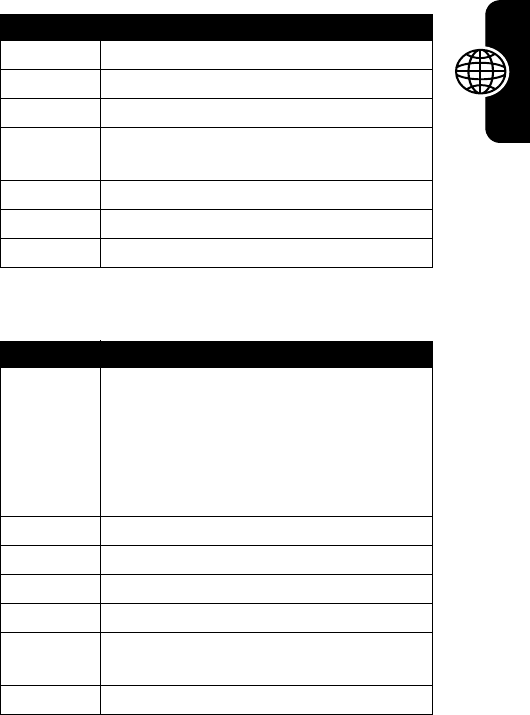
DRAFT
173
News and Entertainment
The menu options for
Camcorder
are described below.
The
Camcorder Settings
menu options are described below.
Option Description
Video player
launch
Camcorder
Image viewer
launch
PhotoAlbum
Take Photo
launch
Camera
Settings
open the
Camcorder Settings
menu (see
below)
Audio
turn on/off audio capture
About
open the
About
dialog
Exit
exit from
Camcorder
Option Description
Clip storage
select storage location of the recorded
clips (
Camcorder
at startup determines
Storage card
as storage location if it is
inserted. If no storage card is detected
the value for
Clip storage
is changed to
Phone memory
.)
Contrast
adjust the recording contrast value
Brightness
adjust the recording brightness value
Record quality
switch among preset quality settings
Audio
turn on/off audio capture
Max clip size
specify maximum file size for a video
clip
Clip name
select the default file name for the clip
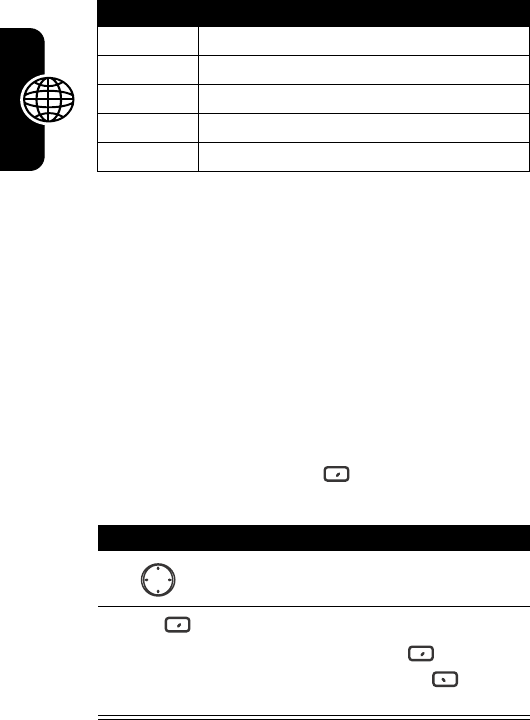
DRAFT
174
News and Entertainment
Playing Video Clips
You can play the recorded clips directly from your phone or
memory card. You can also simultaneously download and
play streaming clips from a Web site.
Tip:
For best results and performance, store clips on the
storage card instead of the phone memory.
Viewing a Clip Stored on Your Phone Or
Memory Card
Title
enter in the title of the clip
Author
enter in the author name of the clip
Copyright
enter in the copyright info of the clip
Rating
enter in the clip rating
Description
enter in the clip description
Find the Feature
Start
>
More
>
More
>
More
>
Accessories
>
Video Player
Press To
1
scroll to a desired clip
2
Play
play the clip
Tip:
Press
Pause
to pause
playing; press
Stop
to stop
playing.
Option Description
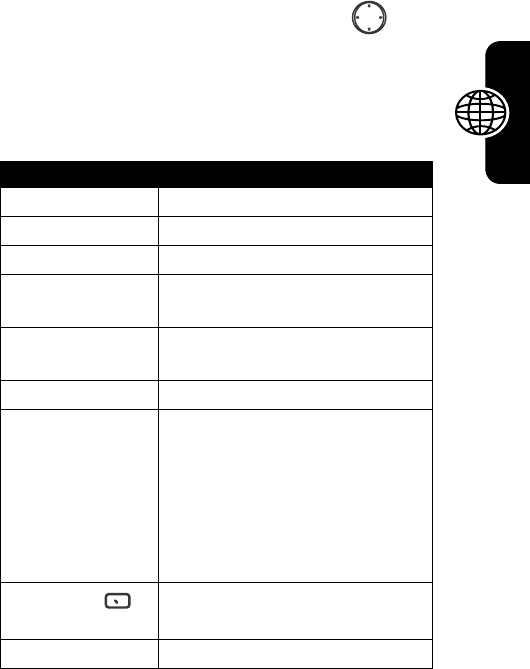
DRAFT
175
News and Entertainment
Tip:
While the clip is playing, press and hold left/right
to reposition forward/backward in the clip. A single
movement to the left or right position will reposition the
clip to the end or beginning of the clip.
The menu options for
Video Player
are described below.
Option Description
Play
/
Pause
play/pause a clip from the list
Open URL
edit a URL to link with
Camera
launch
Camcorder
File
>
Rename
/
Delete
/
Move to storage card
rename a clip/delete a clip/move
a clip to the memory card
Send via MMS
send an MMS message with a
clip attached
Properties
display a clip info
Options
>
Media Buffer
control the amount of data that
is stored before playback begins
(Increasing the media buffer
may improve the consistency of
your viewing experience, but will
increase the time before the
media playback starts.)
Options
>
Menu
>
Clear Cache
clear the last download clip from
your phone’s cache memory
About
open the
About
dialog
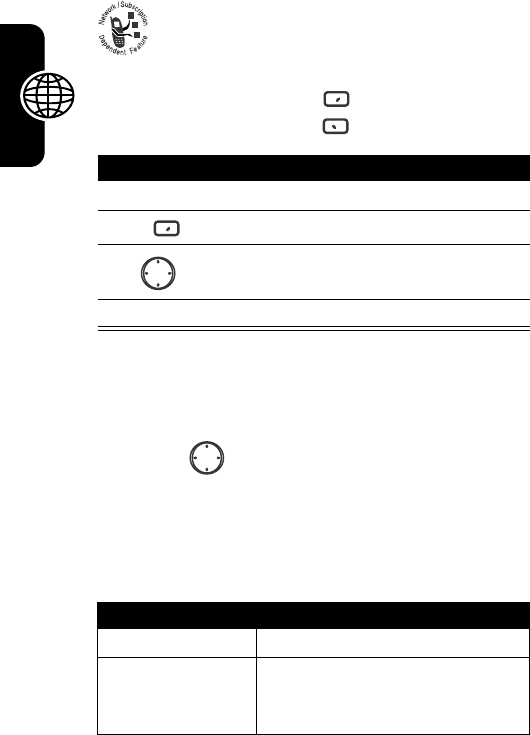
DRAFT
176
News and Entertainment
Viewing a Live Stream from a Web
Site
Tip:
You can play a stream/clip directly from a link in email.
Once you select the link and press
Action
(
A
),
Video Player
will
start playing the stream/clip. While the clip is playing,
press and hold left/right to reposition forward/
backward in the clip. A single movement to the left or right
position will reposition the clip to the end or beginning of
the clip.
The related menu options are described below.
Find the Feature
Start
>
Internet Explorer
>
Menu
>
Address Bar
Press To
1
keypad keys enter the Web address
2
Go
connect to the Web address
3
scroll to a desired stream
4
Action
(
A
)
play the stream
Option Description
Play
play a clip you paused
Pause
pause a clip or stop a stream
that is playing (This option is not
available for live streaming.)
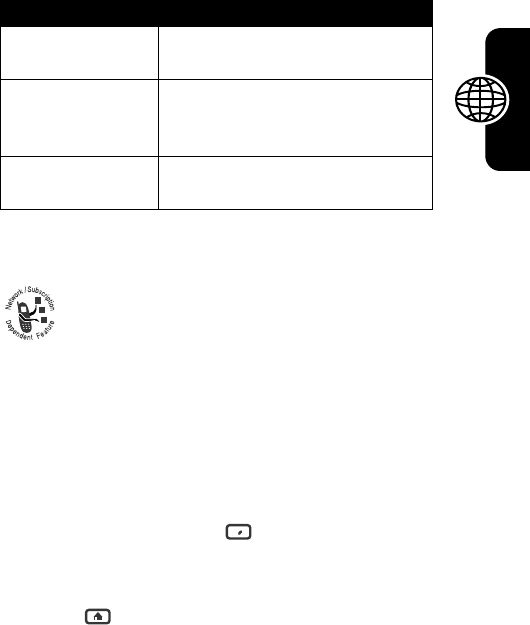
DRAFT
177
News and Entertainment
Using Internet Explorer
®
Using
Internet Explorer
, you can browse the Web on
your phone.
Internet Explorer
supports Wireless
Application Protocol (WAP), Hypertext Markup
Language (HTML), and compact Hypertext Markup
Language (cHTML). It also supports images and sounds,
but does not support frames on a Web page. With
Internet
Explorer
, the Favorites list is displayed as the main screen
instead of a home page. You can add your own favorites to
this list for quick access to Web sites you frequently visit.
Tip:
While you are connected to the Internet, to change
between
Internet Explorer
and other programs on your phone,
press
Home
. This will not close your Internet
connection.
Clips
display a list of clips stored on
your phone or memory card
Save
save a clip to your phone or
memory card (This option is not
available for live streaming.)
Options
>
Media Buffer
see above (This option is not
available for live streaming.)
Find the Feature
Start
>
Internet Explorer
Option Description
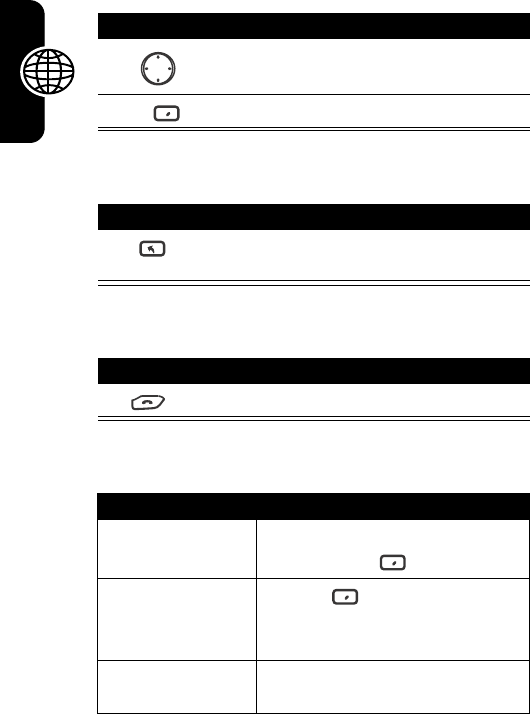
DRAFT
178
News and Entertainment
Viewing a Favorite
Returning to the Previous Web Page
Disconnecting from the Internet
Use the menu options to do the following:
Press To
1
scroll to a desired favorite
2
Go
connect to the favorite
Press To
Back
go to the previous Web page
in the same session
Press To
End
disconnect from the Internet
Option Description
Address Bar
edit a Web address and link to it
by pressing
Go
Address Bar
>
View
History
press
Go
to view a list of the
most recently-visited Web
pages
Refresh
update the Web pages you
visited
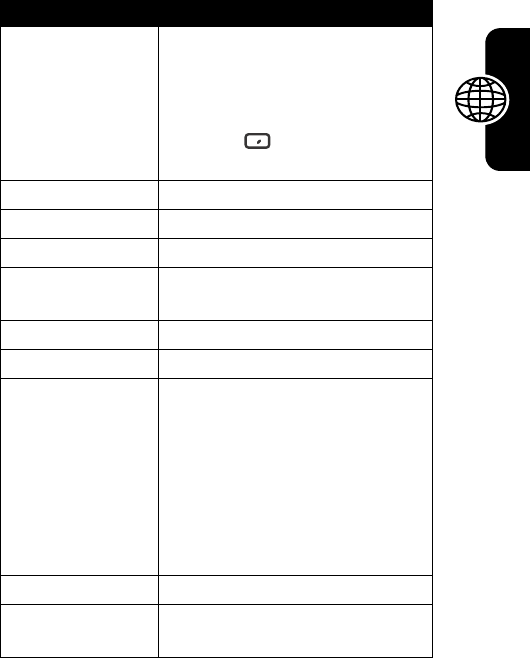
DRAFT
179
News and Entertainment
Add Favorite
add a Web page to your
Favorites list (Enter a name for
the Web site as you want it to
appear on the Favorites list.
Press
Add
when you are
ready.)
Favorites
open the Favorites list
Layout
specify how Web pages display
Properties
view the Web page info
Add Folder
create a new folder in your
Favorites list
Edit
edit the current favorite/folder
Delete
delete the current favorite/folder
Options
>
General
change the way Web pages are
downloaded and displayed (You
can omit displaying images, turn
off sound, request a warning
before moving from secure Web
pages to insecure Web pages,
allow cookies, or change the
language.)
Options
>
Connections
change your network connection
Options
>
Memory
clear your temporary Internet
files, cookies, and Web history
Option Description
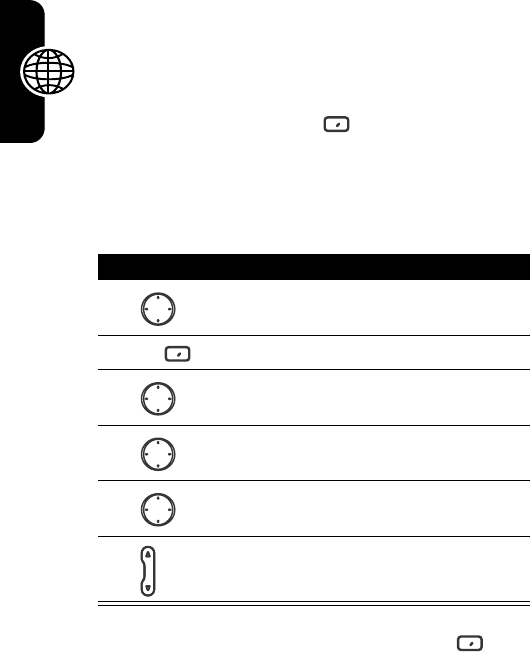
DRAFT
180
News and Entertainment
Using Media Player
Using
Windows Media®
9.0 or later, you can play media
audio and video files and MP3 audio files stored on
your phone or memory card.
Playing a Media File on Your Phone
On the
Local Content
screen:
Tip:
To access the
Local Content
screen, press
Playlist
.
Find the Feature
Start
>
More
>
More
>
Windows Media
Press To
1
scroll to a desired file
2
Play
play the file
3
left skip to the beginning of the
current file
4
left twice skip to the beginning of the
previous file
5
right skip to the next file
6
up/down
increase/decrease the
volume
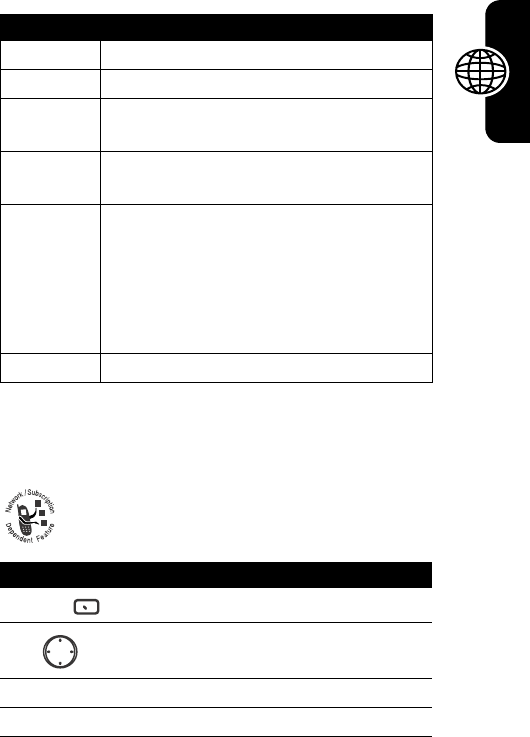
DRAFT
181
News and Entertainment
The related menu options are described below.
Playing a Streaming Media File on a
Network
On the
Local Content
screen:
Option Description
Local Content
display the
Local Content
playlist
Favorites
display the
Favorites
playlist
Open URL
play a streaming media file on a
network
Properties
display information about the selected
file
Settings
adjust the volume and specify various
playback options (For example, to play
files randomly, check
Shuffle
; to play files
repeatedly, check
Repeat
; and to stop
playback while using another program,
check
Background play
.)
Delete
delete the selected file
Press To
1
Menu
open the options menu
2
scroll to
Open URL
3
Action
(
A
)
select
Open URL
4
keypad keys edit the URL
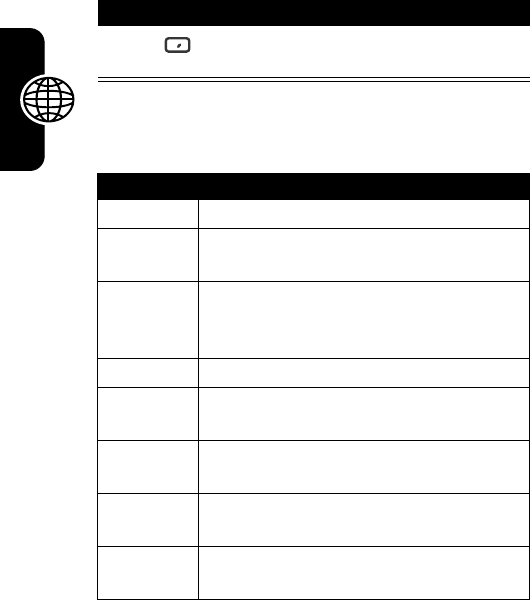
DRAFT
182
News and Entertainment
The following table lists the menu options that are
available when you play a file.
5
Play
connect and play the
streaming media file
Option Description
Play/Pause
play/pause the current file
Next
skip to the next file on the current
playlist
Previous
skip to the beginning of the current file
(If no file is playing, this option skips to
the previous file on the current playlist.)
Full Screen
play the current file in full screen
Open URL
play a streaming media file on a
network
Properties
display information about the current
file that is playing
Settings
adjust the volume and specify various
playback options
Add to
Favorites
add the current file to the
Favorites
playlist
Press To
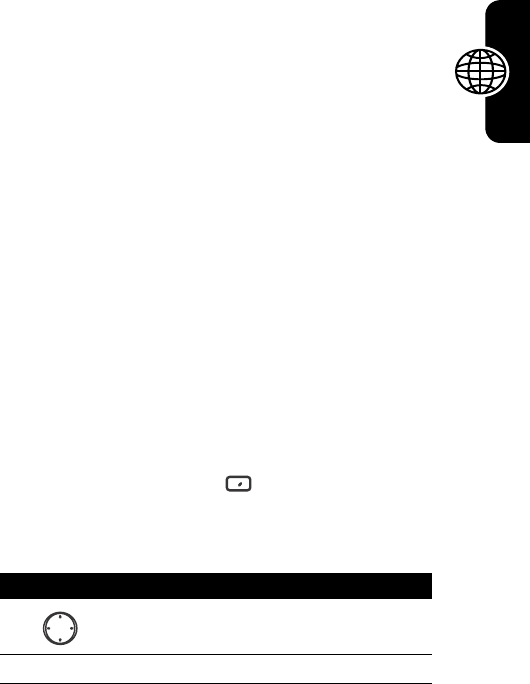
DRAFT
183
News and Entertainment
Managing Digital Rights
Management (DRM) Content
Media Manager
allows you to maintain digital rights
management (DRM) associated with your media
content including images, video clips, audio files and
ring tones.
Some digital media content from the Internet, CD tracks,
and videos have associated licenses that protect them
from being unlawfully distributed or shared. Licenses are
managed and created using DRM, which is the technology
for securing content and managing the rights for its
access.
To ensure that the license is copied with the content, use
the Portable Device (or Copy to CD or Device) feature in
Windows Media Player 9.0 or later on your desktop
computer to copy content to your phone. For more
information about copying content to your phone, see the
Windows Media Player Help on your desktop computer.
To manage DRM content for a specific media type, follow
the steps below:
Find the Feature
Start
>
More
>
Media Manager
Press To
1
scroll to a desired media type
2
Action
(
A
)
select the media type
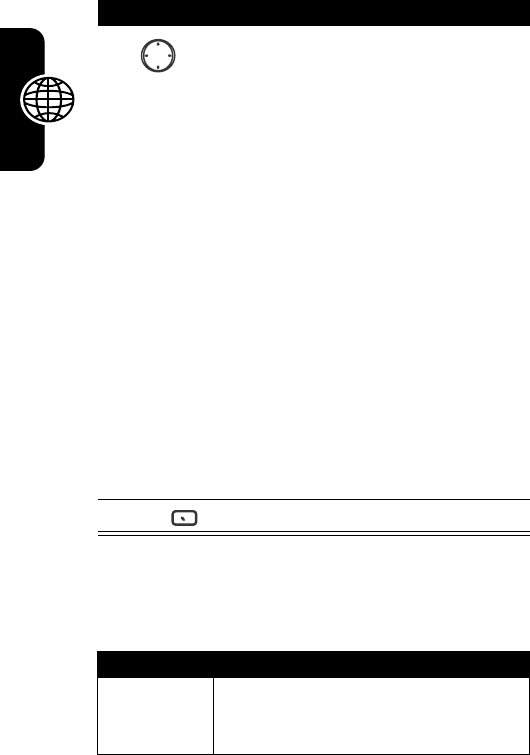
DRAFT
184
News and Entertainment
Once you find the content you are searching for, you are
prompted with a context-sensitive menu that provides you
with multiple management options.
3
scroll to a desired DRM-
protected content
Note:
You are presented with
each file is marked with an
icon that gives you a quick
overview on the rights status
associated with each media
object. There are 6 different
status markers:
•
Not a DRM object
•
Valid rights
•
Expired/renewable rights
•
Pending rights
•
Rights that are about to
expire
•
Expired/non-renewable
rights
4
Menu
open the options menu
Option Description
Send As...
transfer a file to another remote
device using either the Bluetooth
wireless protocol or IR
Press To

DRAFT
185
News and Entertainment
Playing Games
Caution:
A very small percentage of individuals may
experience epileptic seizures when exposed to certain
light patterns or flashing lights. If you experience any of the
following symptoms while playing a video game—
dizziness, altered vision, eye or muscle twitches, loss of
awareness, disorientation, any involuntary movement, or
convulsions—IMMEDIATELY discontinue use and consult
your physician before resuming play.
Renew Rights
launch
Internet Explorer
and direct you to
a URL address where you can renew
the rights for a media object
Show Rights
provide more specific details
concerning the rights for a media
object
Delete File
delete a DRM-protected file and all
the licenses associated with it
Note:
If a non-DRM file is selected for
deletion, only the file itself will be
removed.
Set as Ring Tone
specify the selected media file as the
default ring tone for your phone
Note:
This option is available only for
Ringtones
.
Option Description
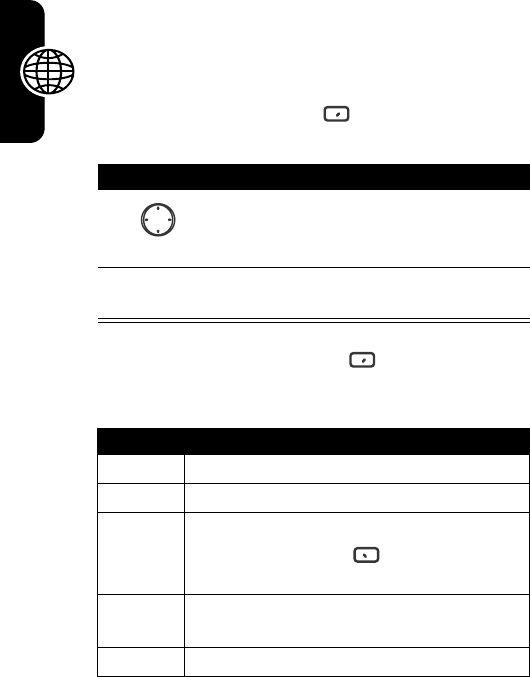
DRAFT
186
News and Entertainment
Playing Jawbreaker
The object of
Jawbreaker
is to have balls (more than 1) in the
same color deleted from the screen. The fewer balls
you leave behind, the more scores you get.
Tip:
To start a new game, press
New
.
The related menu options are described below.
Find the Feature
Start
>
More
>
More
>
More
>
Games
>
Jawbreaker
Press To
1
highlight the ball which is the
same color as the ball(s)
around
2
Action
(
A
)
twice delete the balls from the
screen
Option Description
Undo
undo the balls you just deleted
New Game
start a new game
Statistics
select a style to display the related
records (Press
Reset
to clear the
records of the selected style.)
Options
turn on/off the play sounds and guest
mode, and select a style and color
About
open the
About
dialog
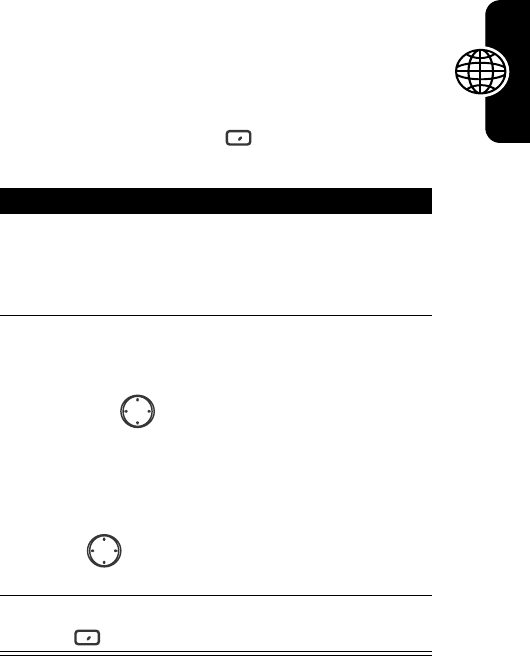
DRAFT
187
News and Entertainment
Playing Solitaire
The object of
Solitaire
is to use all the cards in the deck to
build up 4 suit stacks in ascending order, beginning
with the aces. You win the game when all cards are on
the suit stacks.
Find the Feature
Start
>
More
>
More
>
More
>
Games
>
Solitaire
Action
1
Press the number or character above the card
stack displaying the card you want to move, and
press the number or character above the card
stack to which you want to move the card.
2
Move any aces on the 7 stacks to the 4 card
spaces at the top of the screen, and then make
any other available plays.
Tip:
Press up to move a card to one of the 4
card stacks on the upper right corner of the
screen if it belongs there. For example, if you
have an ace displayed in one of the 7 stacks,
press the number above the ace, and then
press up. The card that is faced up on the
deck is always available for play.
3
When you have made all available plays, press
Draw
to turn over cards.
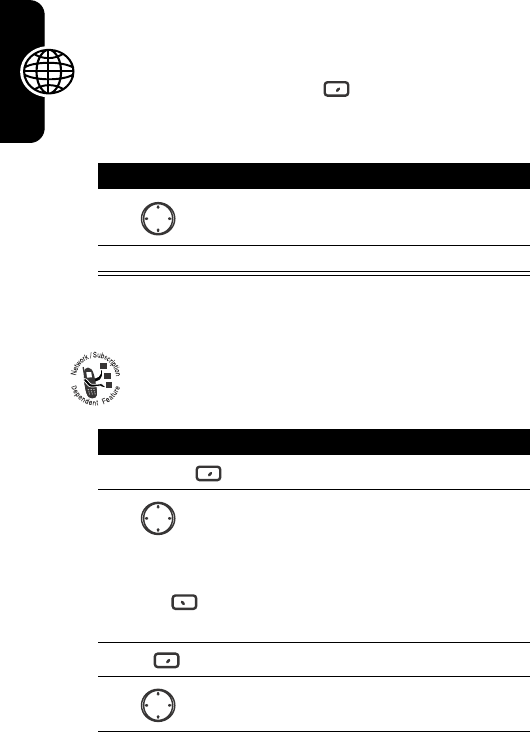
DRAFT
188
News and Entertainment
Managing Java
You can play the preset or downloaded Java games
and configure Java settings on your phone.
Playing a Java Game
Downloading a Java Game
You can download Java games from the Internet
you are surfing on.
Find the Feature
Start
>
More
>
Game Room
Press To
1
scroll to a desired Java game
2
Action
(
A
)
play the Java game
Press To
1
Download
open the Favorites list
2
or
Menu
>
Address
Bar
scroll to a desired favorite
or
enter a Web address
3
Go
connect to the Web page
4
scroll to a desired Java game
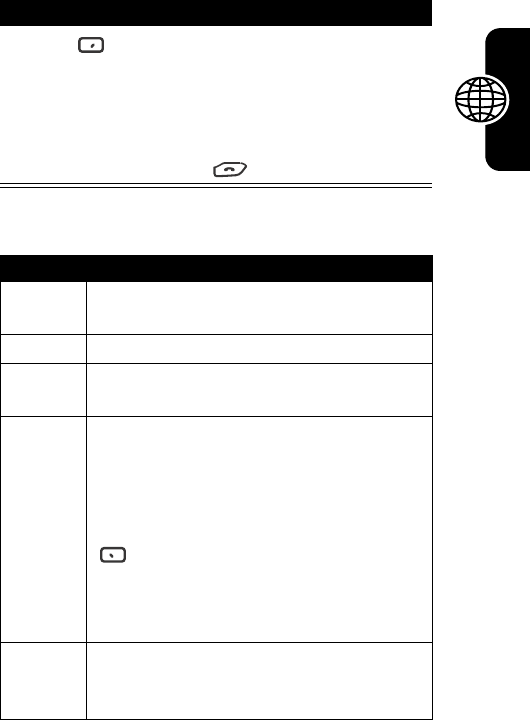
DRAFT
189
News and Entertainment
The menu options for a Java game are described below.
5
Install
install the Java game on your
phone
Tip:
Press
Action
(
A
)
to run the
Java game. To terminate the
running Java game, press
End
.
Option Description
Remove
delete a Java game except the preset
ones
Rename
rename a Java game
Update
update a Java game using the stored
information, such as the URL
Options
select required settings (by highlighting a
feature > pressing
Action
(
A
)
> scrolling to
a desired option > pressing
Action
(
A
)
) for
a Mobile Information Device application
(MIDlet) of a Java game and press
Save
when done (Changes to permission
settings for a MIDlet in a multi-MIDlet
suite will affect the settings for the whole
suite.)
Info
display the size of a Java game, version
number, vendor, domain and URL from
which it was downloaded
Press To
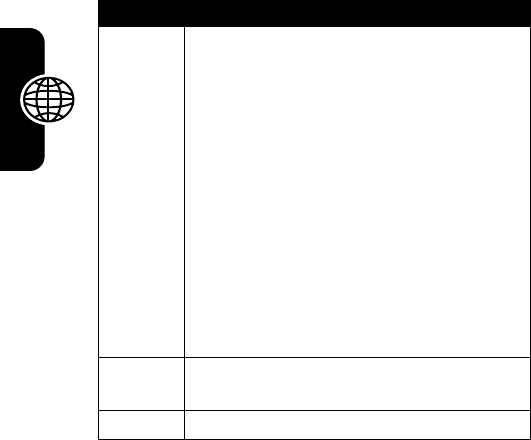
DRAFT
190
News and Entertainment
Java Info
display the following:
•
Connected Limited Device Configuration (CLDC)
version number
•
Mobile Information Device Profile (MIDP) version
number
•
Heapsize
•
SD Card free space
•
Phone storage free space
•
JSRs
Note:
The heapsize does not reflect the
memory installed, but the actual Jbed
FastDAC heapsize setting.
Java
Settings
sort Java games and turn the backlight
on or off
Exit
exit from
Game Room
Option Description
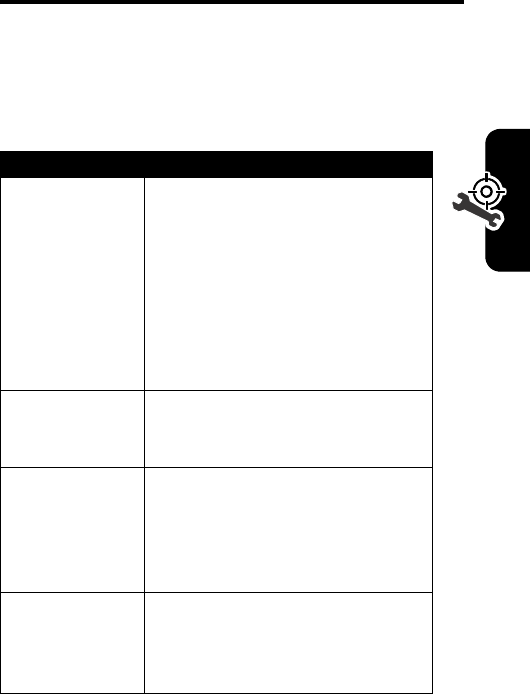
DRAFT
191
Troubleshooting
Troubleshooting
Check these questions first if your phone does not seem to
work properly. If you need additional help, contact the
Motorola Customer Call Center at 1-800-331-6456 (USA)
or 1-800-461-4575 (Canada).
Question Answer
Cannot turn on
the phone?
•
Is the battery empty?
•
Is the battery properly
installed?
•
Are the contacts on battery
and phone clean? If the
contacts appear to be soiled,
contact your dealer to clean
them.
Your voice cannot
be heard.
Have you already turned on the
in-call
Mute
function? Turn it off if
necessary.
Cannot use
certain call
functions?
To use certain advanced call
functions (such as
Call Forwarding
and
Call Barring
), you may need to
subscribe these services to your
operator first.
There are noises
during a phone
call.
Avoid using the phone near a
microwave oven, speaker or TV.
Their interference has adverse
effect to call quality.
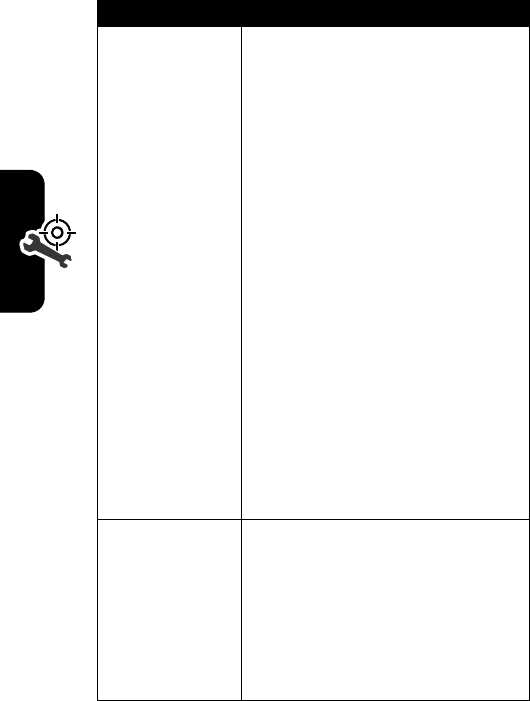
DRAFT
192
Troubleshooting
Unable to make/
receive calls?
•
Is the reception of network
signal in good condition?
Move to an open space, or a
place closer to window.
•
Is network setup properly? If
necessary, try to select your
network manually.
•
Have you already activated
the
Fixed Dialing
,
Call Forwarding
,
and
Call Barring
functions? If
yes, deactivate them
temporarily.
•
Are you using your phone
with other SIM cards when
the
Enable SIM Lock
function has
been activated? Deactivate
the function if necessary.
•
Check to make sure
Flight mode
is off.
Cannot connect
to the Internet?
•
Have you subscribed the
Internet (WAP) service to
your operator?
•
Did you enter correct setting
parameters (such as APN
and IP addresses) in WAP
profile setup?
Question Answer
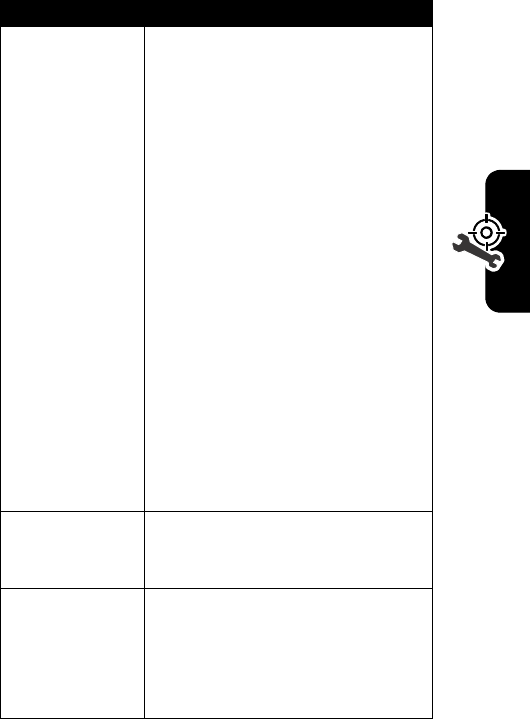
DRAFT
193
Troubleshooting
The battery
cannot be
charged.
•
Is the battery charger
correctly plugged into the
battery charger socket on the
phone?
•
Is the power cord of the
charger damaged?
•
Is the battery very old?
Replace with a new battery
and try again.
•
If the battery is “deeply
discharged” and you plug in a
charger, the phone will not
display that it is charging.
After charging for
approximately 15 minutes,
disconnect then reconnect
the charger to the phone. It
will then properly display that
it is charging.
Cannot
synchronize
device with PC?
Check the following Web site for
several possible solutions:
http://support.microsoft.com
USB won’t
connect while
using
ActiveSync
®
.
Upgrade to the latest version of
ActiveSync. Use version 3.7.1 or
higher from Microsoft
®
downloads, available at
http://
www.microsoft.com/downloads.
Question Answer
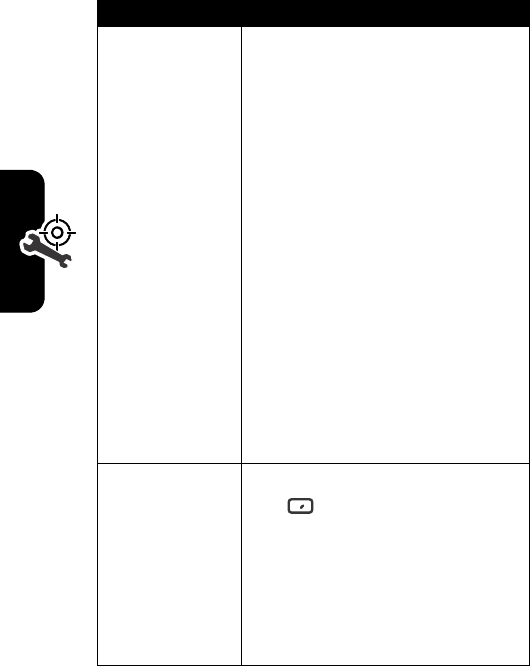
DRAFT
194
Troubleshooting
The standby and
talk time is
apparently
shorter than ever.
•
Your phone consumes more
power when signal reception
is poor. Try to move to a
better location when you use
the phone.
•
Are you using a new battery?
It takes several charge and
discharge cycles for the
battery to reach its original
capacity.
•
Is the battery very old?
Replace it with a new one.
•
Are you using the phone in
very high or low temperature
environment? The efficiency
of a battery can be effected
by ambient temperature.
Phone appears to
operate slowly.
Check the free memory. Go to
Start
>
Settings
>
About
. It is
recommended to have at least 1.5
to 2 MB of free memory storage
on your phone. Remember to
delete or transfer (to mini SD or
computer) old messages and
pictures.
Question Answer
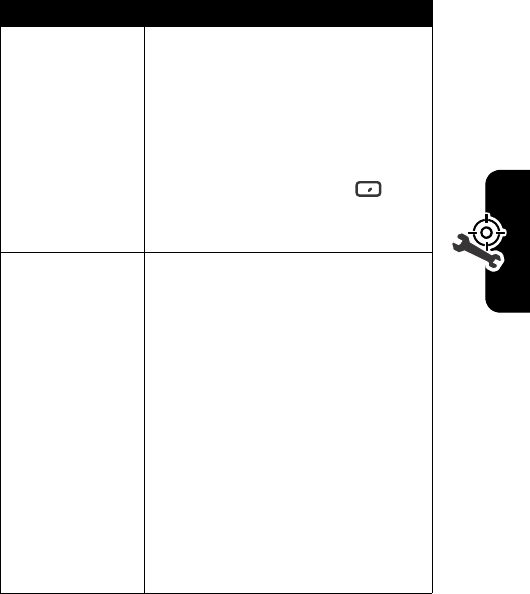
DRAFT
195
Troubleshooting
Home Screen
Layout error
message
appears.
If the Home screen appears white
or another color, the Home screen
layout may not be selected. An
error message
Cannot find Home Screen
Layout
may also appear. To correct
this, you need to reselect the
Home screen. Go to
Start
>
Settings
>
Home Screen
and select a
Home screen layout.
I’m having issues
with my email or I
can’t connect to
the GPRS/WAP
server.
•
Check your GPRS data
connection settings (see
“Creating GPRS Connection”
on page 109).
•
Try browsing the Web or your
provider’s Web site.
•
Check your email setting:
user name, password, server
name, and server type (see
“Configuring an Email
Account” on page 65).
•
Try connecting to your email
server.
Question Answer

196
Specific Absorption Rate Data
The model MPx220 GSM wireless phone meets the
government’s requirements for exposure to radio waves.
Your wireless phone is a radio transmitter and receiver. It is designed and
manufactured not to exceed limits for exposure to radio frequency (RF)
energy set by the Federal Communications Commission (FCC) of the U.S.
Government and by the Canadian regulatory authorities. These limits are
part of comprehensive guidelines and establish permitted levels of RF
energy for the general population. The guidelines are based on standards
that were developed by independent scientific organizations through
periodic and thorough evaluation of scientific studies. The standards
include a substantial safety margin designed to assure the safety of all
persons, regardless of age or health.
The exposure standard for wireless mobile phones employs a unit of
measurement known as the Specific Absorption Rate, or SAR. The SAR
limit set by the FCC and by the Canadian regulatory authorities is 1.6 W/
kg.
1
Tests for SAR are conducted using standard operating positions
accepted by the FCC and by Industry Canada with the phone transmitting
at its highest certified power level in all tested frequency bands. Although
the SAR is determined at the highest certified power level, the actual SAR
level of the phone while operating can be well below the maximum value.
This is because the phone is designed to operate at multiple power levels
so as to use only the power required to reach the network. In general, the
closer you are to a wireless base station, the lower the power output.
Before a phone model is available for sale to the public in the U.S. and
Canada, it must be tested and certified to the FCC and Industry Canada
that it does not exceed the limit established by each government for safe
exposure. The tests are performed in positions and locations (e.g., at the
ear and worn on the body) reported to the FCC and available for review by
Industry Canada. The highest SAR value for this model phone when
tested for use at the ear is 0.75 W/kg, and when worn on the body, as

197
described in this us er guide, is 0.88 W/kg. T he S AR value for this product
in its data trans mis s ion mode (body-worn use) is 0.56 W/kg. (B ody-worn
measurements differ among phone models, depending upon available
access ories and regulatory requirements).
2
While there may be differences between the S AR levels of various phones
and at various pos itions, they all meet the governmental requirements for
safe exposure. P leas e note that improvements to this product model
could caus e differences in the S AR value for later products ; in all cas es,
products are designed to be within the guidelines.
Additional information on S pecific Absorption R ates (S AR ) can be found
on the C ellular Telecommunications & Internet As s ociation (C T IA) Web
site:
http://www.phonefacts.net
or the C anadian Wireless Telecommunications As s ociation (C W TA) Web
site:
http://www.cwta.ca
1. In the United S tates and C anada, the S AR limit for mobile
phones used by the public is 1.6 watts/kg (W/kg) averaged over
one gram of tis sue. The s tandard incorporates a substantial
margin of safety to give additional protec tion for the public and
to acc ount for any variations in meas urements .
2. The S AR information includes the Motorola testing protocol,
ass ess ment proc edure, and meas urement unc ertainty range for
this product.

DRAFT
198
Microsoft End User License
Agreement
You have acquired a device (“DEVICE”) that includes software licensed
by Motorola, Inc. (“Motorola”) from Microsoft Licensing Inc. or its affiliates
(“Microsoft”), for use in connection with wireless network services
provided under separate agreement between you and a wireless
telecommunications provider (“Mobile Operator”). Those installed
software products of Microsoft origin, as well as associated media, printed
materials, and “online” or electronic documentation (“SOFTWARE”) are
protected by international intellectual property laws and treaties.
SOFTWARE includes software already installed on the DEVICE
(“DEVICE Software”) and Microsoft software contained on any CD-ROM
disk accompanying the DEVICE (“Desktop Software”).
The SOFTWARE is licensed, not sold. All rights reserved.
IF YOU DO NOT AGREE TO THIS END USER LICENSE AGREEMENT
(“EULA”), DO NOT USE THE DEVICE OR COPY THE SOFTWARE.
INSTEAD, PROMPTLY CONTACT MOTOROLA FOR INSTRUCTIONS
ON RETURN OF THE UNUSED DEVICE(S) FOR A REFUND. ANY USE
OF THE SOFTWARE, INCLUDING BUT NOT LIMITED TO USE ON THE
DEVICE, WILL CONSTITUTE YOUR AGREEMENT TO THIS EULA (OR
RATIFICATION OF ANY PREVIOUS CONSENT).
1. GRANT OF SOFTWARE LICENSE. This EULA grants you the
following license:
1.1. DEVICE Software. You may use the DEVICE Software as installed
on the DEVICE (including as installed on removable media installed in the
DEVICE). All or certain portions of the DEVICE Software may be
inoperable if a proper account is not established or maintained with an
appropriate Mobile Operator, or if the Mobile Operator’s network facilities
are not operating or configured to operate with the DEVICE software.
DRAFT
199
1.2. Desktop Software. Desktop Software is included with your DEVICE,
and you may install and use the Microsoft ActiveSync
®
3.7.1 component
on one (1) or more computers to exchange information with one (1) or
more computing devices that contain a compatible version of the
Microsoft Windows
®
for Smartphone 2003 Software. For other software
component(s) contained in the Desktop Software, you may install and use
such components only in accordance with the terms of the printed or
online end user license agreement(s) provided with such component(s).
In the absence of an end user license agreement for particular
component(s) of the Desktop Software, you may install and use only one
(1) copy of such component(s) on the DEVICE or a single computer with
which you use the DEVICE.
1.3. Back-up Copy. If Motorola has not included a back-up copy of the
DEVICE Software with the DEVICE, you may make a single back-up copy
of the DEVICE Software. You may use the back-up copy solely for
archival purposes.
1.4. Microsoft Windows
®
2003. If Microsoft Outlook
®
2002 is included
with your Device, the following terms apply to your use of Microsoft
Outlook
®
2002: (i) regardless of the information contained in “Software
Installation and Use” section of the online EULA you may install one (1)
copy of Microsoft Outlook
®
2002 on one (1) computer to use, exchange
data, share data, access and interact with the DEVICE, and (ii) the EULA
for Microsoft Outlook
®
2002 is between Motorola and the end user - not
between the PC manufacturer and end user.
2. Speech/Handwriting Recognition. If the Software includes speech and
or handwriting recognition component(s), you should understand that
speech and handwriting recognition are inherently statistical processes;
that recognition errors are inherent in the processes; that it is your
responsibility to provide for handling such errors and to monitor the
recognition processes and correct any errors. Neither Motorola nor its
suppliers shall be liable for any damages arising out of errors in the
speech and handwriting recognition processes.
DRAFT
200
3. Limitations on Reverse Engineering, Decompilation and Disassembly.
You may not reverse engineer, decompile, or disassemble the
SOFTWARE, except and only to the extent that such activity is expressly
permitted by applicable law notwithstanding this limitation.
4. Single DEVICE. The Device Software is licensed with the DEVICE as a
single integrated product. The DEVICE Software may only be used as
part of the DEVICE, notwithstanding any installation of the DEVICE
Software on removable media.
5. Single EULA. The package for the DEVICE may contain multiple
versions of this EULA, such as multiple translations and/or multiple media
versions (e.g., in the user documentation and in the software). Even if you
receive multiple versions of the EULA, you are licensed to use only one
(1) copy of the DEVICE Software.
6. Rental. You may not rent or lease the SOFTWARE.
7. Software Transfer. You may not permanently transfer any of your rights
under this EULA with regard to the DEVICE Software or Desktop
Software, except as permitted by the applicable Mobile Operator. In the
event that the Mobile Operator permits such transfer, you may
permanently transfer all of your rights under this EULA only as part of a
sale or transfer of the DEVICE, provided you retain no copies, you
transfer all of the SOFTWARE (including all component parts, the media
and printed materials, any upgrades or backup copies, this EULA and, if
applicable, the Certificate(s) of Authenticity), and the recipient agrees to
the terms of this EULA. If the Software is an upgrade, any transfer must
include all prior versions of the SOFTWARE.
8. Termination. Without prejudice to any other rights, Motorola or
Microsoft may terminate this EULA if you fail to comply with the terms and
conditions of this EULA. In such event, you must destroy all copies of the
SOFTWARE and all of its component parts.
9. Security Updates. The SOFTWARE may include digital rights
management technology. If SOFTWARE does contain digital rights
management technology, content providers are using the digital rights
DRAFT
201
management technology (“Microsoft DRM”) contained in the SOFTWARE
to protect the integrity of their content (“Secure Content”) so that their
intellectual property, including copyright, in such content is not
misappropriated. Owners of such Secure Content (“Secure Content
Owners”) may, from time to time, request Microsoft, Microsoft Corporation
or their subsidiaries to provide security related updates to the Microsoft
DRM components of the SOFTWARE (“Security Updates”) that may affect
your ability to copy, display and/or play Secure Content through Microsoft
software or third party applications that utilize Microsoft DRM. You
therefore agree that, if you elect to download a license from the Internet
which enables your use of Secure Content, Microsoft Corporation or their
subsidiaries may, in conjunction with such license, also download onto
your DEVICE such Security Updates that a Secure Content Owner has
requested that Microsoft, Microsoft Corporation or their subsidiaries
distribute. Microsoft, Microsoft Corporation or their subsidiaries will not
retrieve any personally identifiable information, or any other information,
from your DEVICE by downloading such Security Updates.
10. Consent to Use of Data. You agree that Microsoft, Microsoft
Corporation and their affiliates may collect and use technical information
gathered in any manner as part of product support services related to the
SOFTWARE. Microsoft, Microsoft Corporation and their affiliates may
use this information solely to improve their products or to provide
customized services or technologies to you. Microsoft, Microsoft
Corporation and their affiliates may disclose this information to others, but
not in a form that personally identifies you.
11. Internet Gaming/Update Features. If the SOFTWARE provides, and
you choose to utilize, the Internet gaming or update features within the
SOFTWARE, it is necessary to use certain computer system, hardware,
and software information to implement the features. By using these
features, you explicitly authorize Microsoft, Microsoft Corporation and/or
their designated agent to use this information solely to improve their
products or to provide customized services or technologies to you.
Microsoft or Microsoft Corporation may disclose this information to others,
but not in a form that personally identifies you.
DRAFT
202
12. Internet-Based Services Components. The SOFTWARE may contain
components that enable and facilitate the use of certain Internet-based
services. You acknowledge and agree that Microsoft Corporation or their
affiliates may automatically check the version of the SOFTWARE and/or
its components that you are utilizing and my provide upgrades or
supplements to the SOFTWARE that may be automatically downloaded
to your Device.
13. Links to Third Party Sites. The SOFTWARE may provide you with the
ability to link to third party sites through the use of the SOFTWARE. The
third party sites are NOT under the control of Motorola, Microsoft,
Microsoft Corporation or their affiliates. Neither Motorola, Microsoft nor
Microsoft Corporation nor their affiliates are responsible for (i) the
contents of any third party sites, any links contained in third sites, or any
changes or updates to third party sites, or (ii) webcasting or any other
form of transmission received from any third party sites. If the
SOFTWARE provides links to third party sites, those links are provided to
you only as a convenience, and the inclusion of any link does not imply an
endorsement of the third party site by Motorola, Microsoft, Microsoft
Corporation or their affiliates.
14. Additional Software/Services. The SOFTWARE may permit Motorola,
Microsoft, Microsoft Corporation or their affiliates to provide or make
available to you SOFTWARE updates, supplements, add-on components,
or Internet-based services components of the SOFTWARE after the date
you obtain your initial copy of the SOFTWARE (“Supplemental
Components”).
14.1.If Motorola provides or makes available to you Supplemental
Components and no other EULA terms are provided along with the
Supplemental Components, then the terms of this EULA shall apply.
14.2.If Microsoft, Microsoft Corporation or their affiliates make available
Supplemental Components, and no other EULA terms are provided, then
the terms of this EULA shall apply, except that the Microsoft, Microsoft
Corporation or affiliate entity providing the Supplemental Component(s)
shall be the licensor of the Supplemental Component(s).
DRAFT
203
14.3.Motorola, Microsoft, Microsoft Corporation and their affiliates reserve
the right to discontinue any Internet-based services provided to you or
made available to you through the use of the SOFTWARE.
15. UPGRADES AND RECOVERY MEDIA.
15.1.DEVICE Software. If the DEVICE Software is provided by Motorola
separate from the DEVICE on media such as a ROM chip, CD ROM
disk(s) or via web download or other means, and is labeled “For Upgrade
Purposes Only” or “For Recovery Purposes Only”, you may install one
copy of such DEVICE Software on the DEVICE as a replacement copy for
the existing DEVICE Software and use it in accordance with the Grant of
Software License section of this EULA.
15.2.Desktop Software. If any Desktop Software component(s) is
provided by Motorola separate from the DEVICE on CD ROM disk(s) or
via web download or other means, and labeled “For Upgrade Purposes
Only” or “For Recovery Purposes Only”, you may (i) install and use one
copy of such component(s) on the computer(s) you use to exchange data
with the DEVICE as a replacement copy for the existing Desktop Software
component(s).
16. COPYRIGHT. All title and intellectual property rights in and to the
SOFTWARE (including but not limited to any images, photographs,
animations, video, audio, music, text and “applets”, incorporated into the
SOFTWARE), the accompanying printed materials, and any copies of the
SOFTWARE, are owned by Microsoft or its suppliers (including Microsoft
Corporation). You may not copy the printed materials accompanying the
SOFTWARE. All title and intellectual property rights in and to the content
which may be accessed through use of the SOFTWARE is the property of
the respective content owner and may be protected by applicable
copyright or other intellectual property laws and treaties. This EULA
grants you no rights to use such content. All rights not specifically granted
under this EULA are reserved by Microsoft and its suppliers (including
Microsoft Corporation).
17. EXPORT RESTRICTIONS. You acknowledge that SOFTWARE is
subject to U.S. export jurisdiction. You agree to comply with all applicable
DRAFT
204
international and national laws that apply to the SOFTWARE, including
the U.S. Export Administration Regulations, as well as end-user, end-use
and destination restrictions issued by U.S. and other governments. For
additional information, see
http://www.microsoft.com/ exporting/
.
18. PRODUCT SUPPORT. Product support for the SOFTWARE is NOT
provided by Microsoft, its parent corporation, Microsoft Corporation, or
their affiliates or subsidiaries.
19. NO LIABILITY FOR CERTAIN DAMAGES. EXCEPT AS PROHIBITED
BY LAW, MICROSOFT SHALL HAVE NO LIABILTIY FOR ANY
INDIRECT, SPECIAL, CONSEQUENTIAL OR INCIDENTAL DAMAGES
ARISING FROM OR IN CONNECTION WITH THE USE OR
PERFORMANCE OF THE SOFTWARE. THIS LIMITATION SHALL
APPLY EVEN IF ANY REMEDY FAILS OF ITS ESSENTIAL PURPOSE.
20. FOR APPLICABLE LIMITED WARRANTIES AND SPECIAL
PROVISIONS PERTAINING TO YOUR PARTICULAR JURISDICTION,
PLEASE REFER TO YOUR WARRANTY BOOKLET INCLUDED WITH
THIS PACKAGE OR PROVIDED WITH THE SOFTWARE PRINTED
MATERIALS.

DRAFT
205
Index
A
a 123
About 38
Accessibility 95
accessories 17, 18
ActiveSync 110
Installing 111
answering a call 25
B
battery
charging 20
extending battery life 21
installing 19
level indicator 20, 21, 22
Beaming Information 120
block cursor 157
C
Calculator 154
Calendar 148
Schedule 149
Call 50
call
answering 25
dialing 23
ending 96, 97
making 23
receiving 25
Call Barring 89
Call Forwarding 89
Call Options 89
Call Waiting 55
Caller ID 25, 28, 89, 162
Calling with Speed Dial 53
Camcorder 172
Camera 160
Channels 89
Contact cards 145
Contacts 143
Contacts list 143
D
Data Connection 104
Data Connections
Dial-up connection 105
Proxy connection 108
VPN connection 107
Date and Time 39
dialing a number 23
Digital 183
Display 28
External display 28
Main display 28
display
DRAFT
206
description 26
idle display 33
idle display, defined 26
E
Emergency calls 51
end key 96, 97
ending 25
ending a call 96, 97
F
Favorites Manager 132,
133
File Manager 138
Fixed Dialing 89
flip
activating 25
H
Home Screen 94
Customizing 94
I
idle display 26
idle display, defined 33
indicators
battery level 20, 21, 22
Input modes 34, 35
Multipress mode 35
Numeric mode 37
Internal Display 26
Internet Explorer 177
iTAP modes 34
J
Java 188
Jawbreaker 186
K
key
end 96, 97
send 23, 25, 42, 96, 97
Keypad
Locking 38
Unlocking 156
L
Lock 38
lock
phone 159
Locking the keypad 38
Locking the SIM card 159
M
making a call 23
Media 180
Media Player 180, 183
menu
navigating 33
Messaging 58, 70
MMSSettings 65
Modem Link 126, 127, 128
DRAFT
207
MSN Messenger 82
Multi-Tap Mode 35
N
Networks 89
O
optional accessory, defined
18
optional feature, defined 17
Owner Information 39
P
Phone 88
phone
flip 25
locking 159
turning on/off 22
unlocking 159
Phone Settings 95
PhotoAlbum 166
Player 174
Power Management 40
Profiles 91
Viewing 91
Q
Quick List 29, 33
R
Regional Settings 95
Remove Programs 142
Resource Manager 140
S
Security 156
send key 23, 25, 42, 96, 97
Shortcuts
Viewing 101, 102, 103
shortcuts 4
SIM card
defined 18
installing 18
Locking 159
precautions 18
Unlocking 159
Solitaire 187
Sounds 90
Customizing 90
Displaying 90
Space Manager 140
Speed dials 54, 99
standard display 26
T
Taking 160
Task Manager 140
Tasks 152
text
block cursor 157
travel charger 20, 165
motorola.com